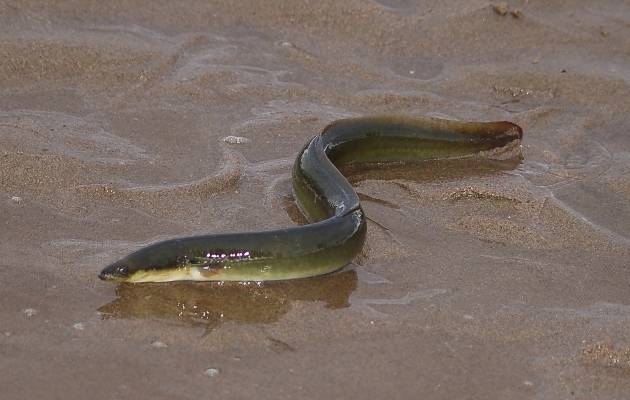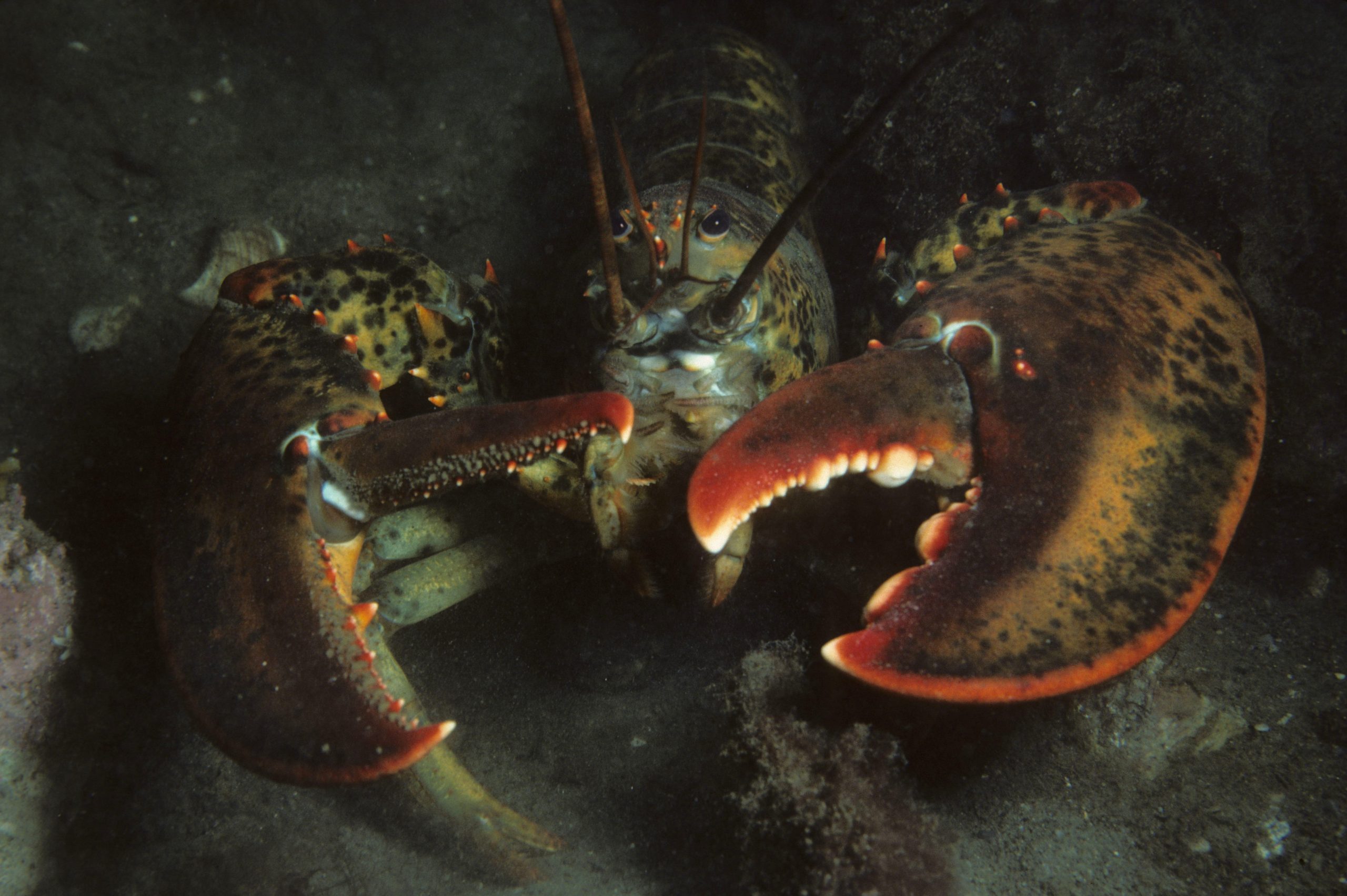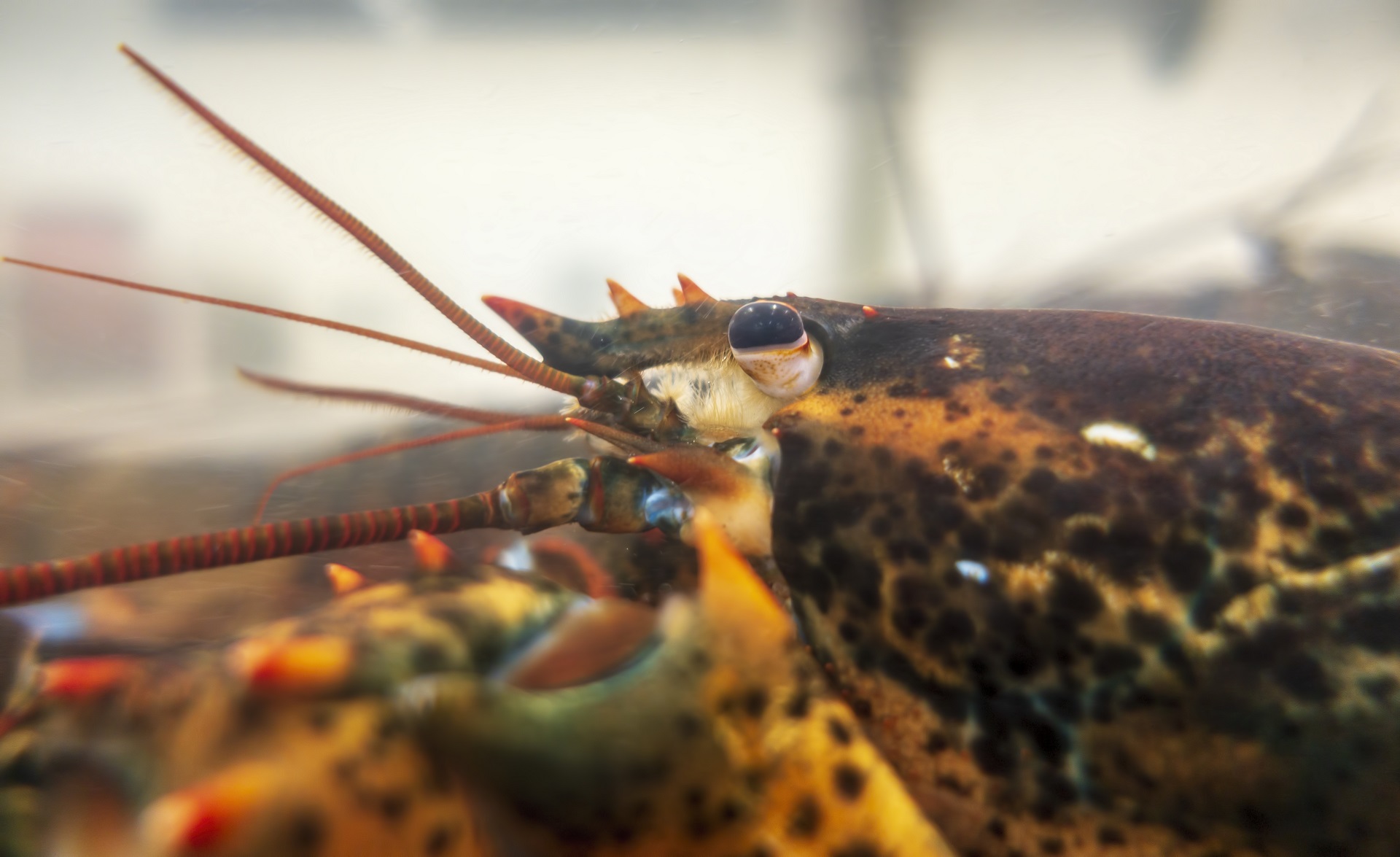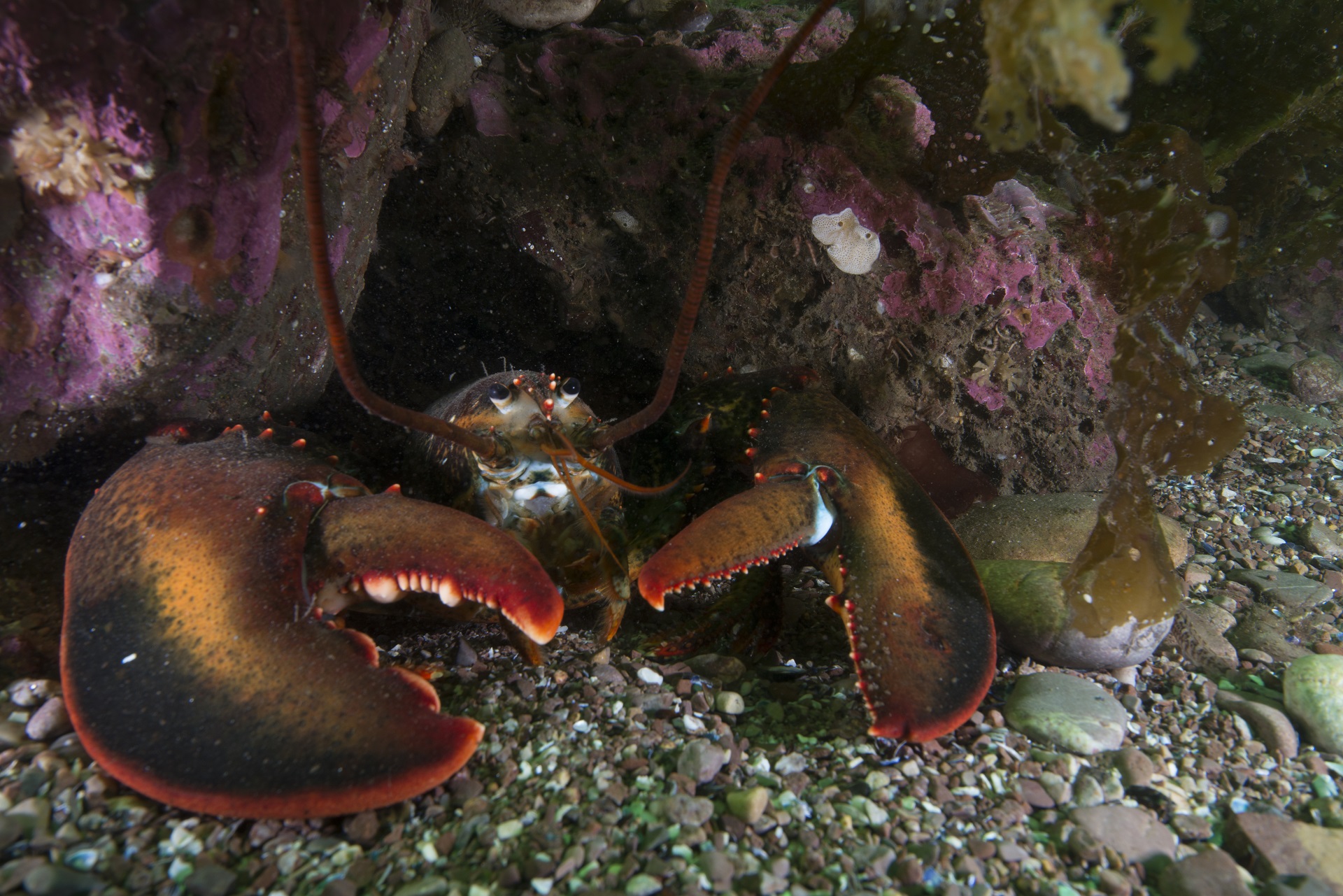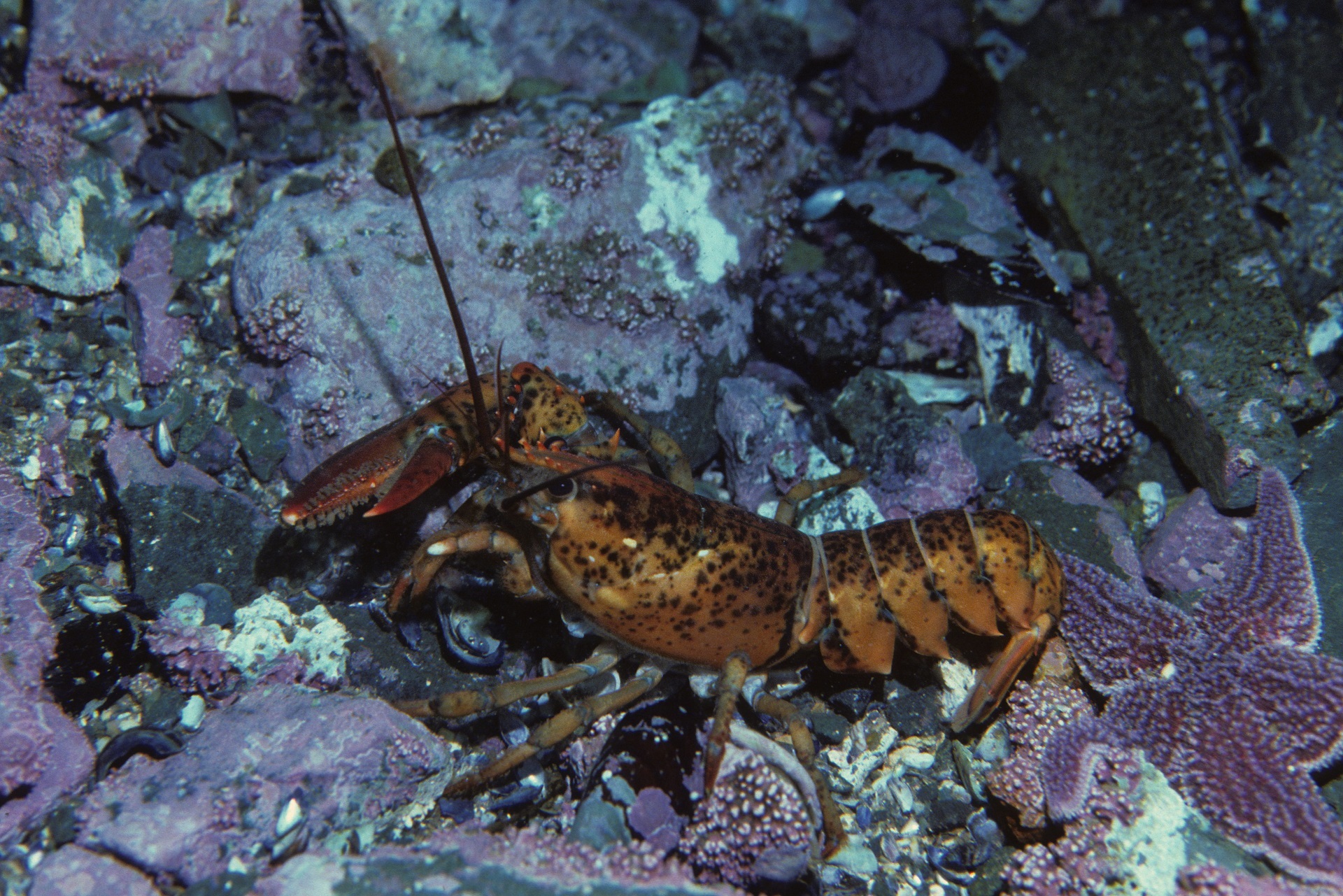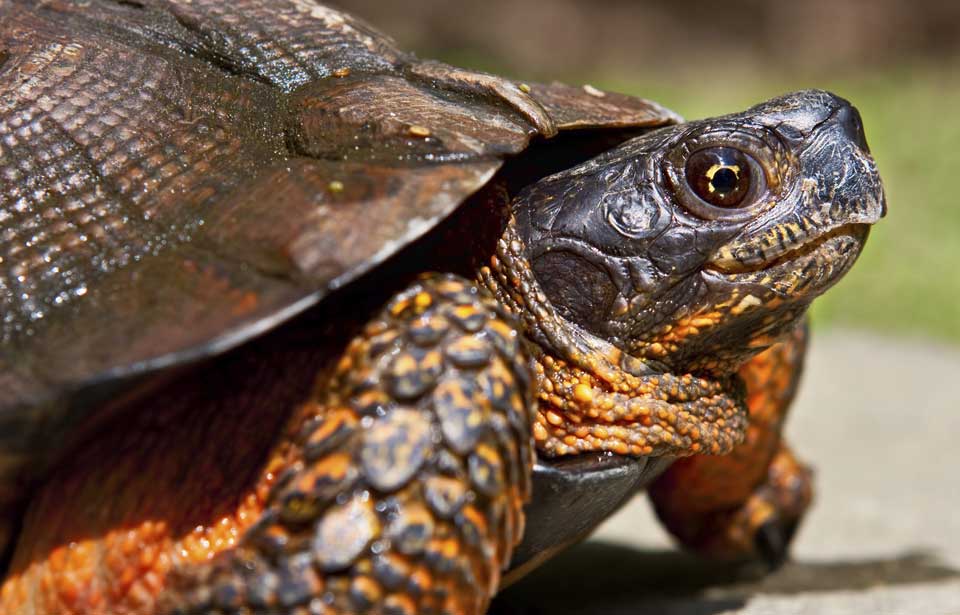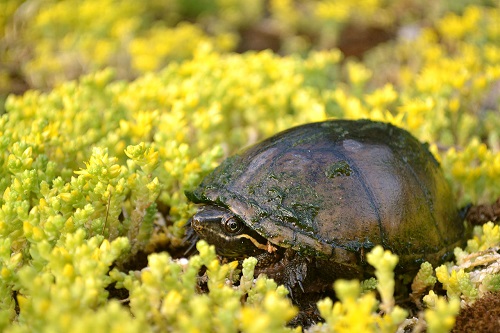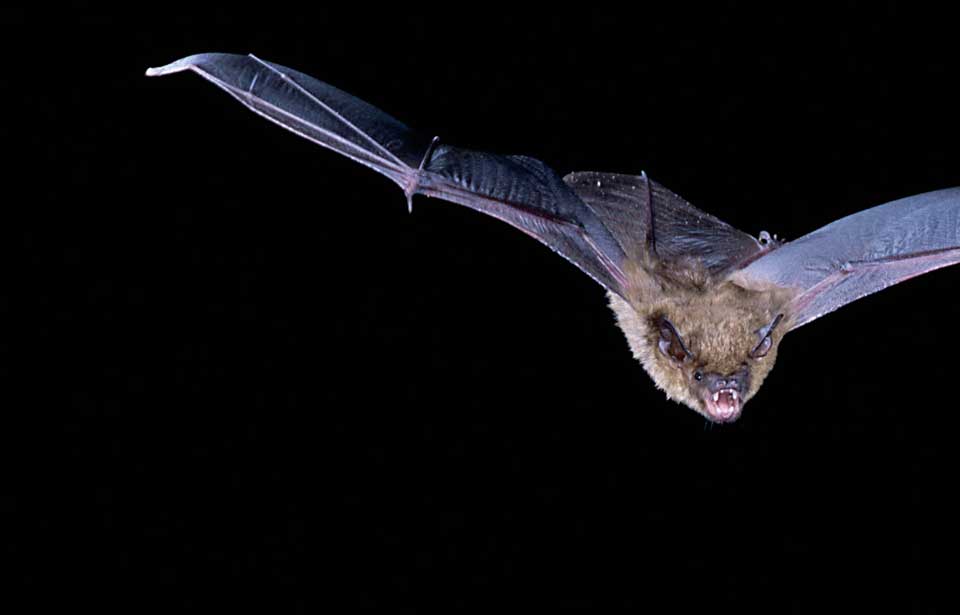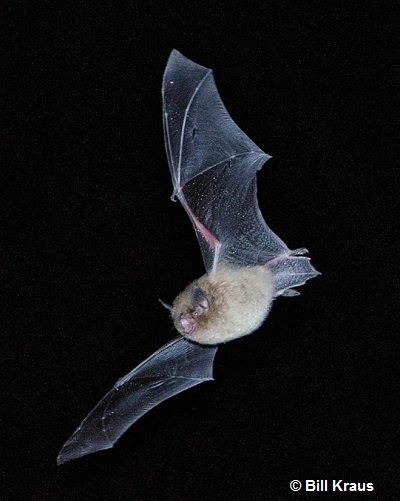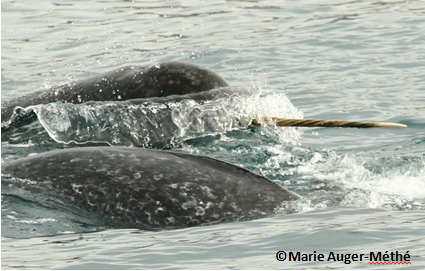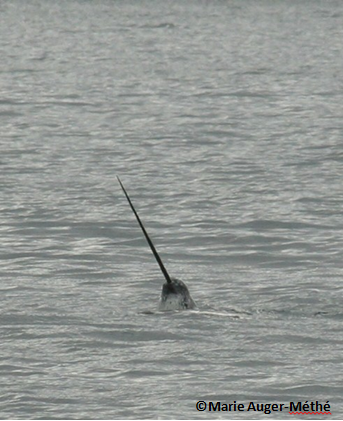Birds
Do birds of a feather really flock together? They do in this section, where we’ll give you a sampling of the 462 species of birds you’ll find across Canada.
And where do most birds gather in Canada? In British Columbia, where you may find 362 species, and in Ontario, where 318 species regularly appear.
Many of these species migrate to find suitable breeding grounds, more favourable temperatures and food supplies in winter. Some of them travel great distances—in the fall, many Canada geese make the trip from the Arctic to parts of the United States, sometimes covering more than 1 000 km in one day.
Spend some time in this section. If you find you’d like even more information concerning our feathered friends, find your way to Issues and Topics.
-
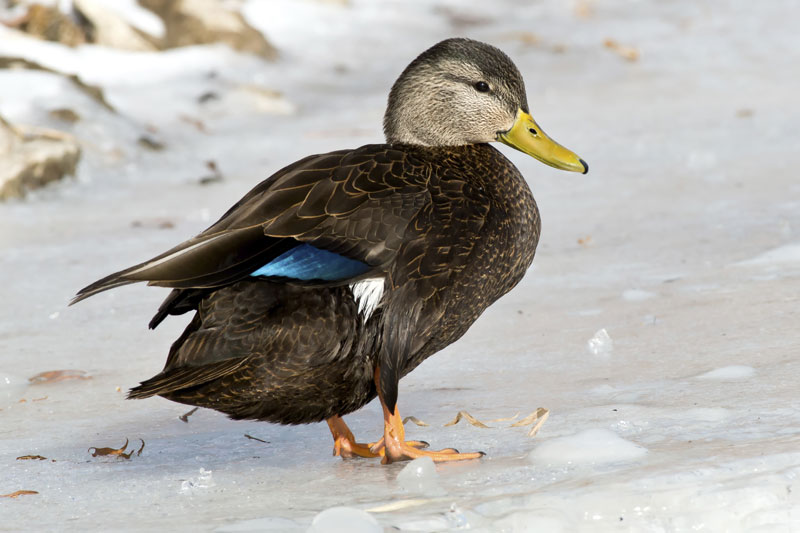 Thinkstock
American Black Duck
American Black Duck
Thinkstock
American Black Duck
American Black Duck
The American Black Duck Anas rubripes is a large dabbling duck that is commonly found throughout much of eastern North America. In contrast to its name, the American Black Duck is actually a dark dusky brown rather than black and is often referred to as “Dusky Duck”. They have relatively non descript dark dusky brown body plumage that transitions into a light brown, grey head characterized by a dark eye stripe. They have a brilliant purplish blue speculum, or wing patch, highlighted by black margins and stark white underwings that can be seen in flight. Male and female American Black Ducks share very similar plumage. They are considered to be the only common duck species in eastern North America in which the sexes are almost identical to each other. Upon closer inspection, Males can be distinguished from females by the color of their bills. Males have bright yellow-green bills while females have slightly drabber, olive colored bills. In addition to their similar appearance they have to each other, both male and Female American Black Ducks look similar to female mallards in size and color. As a result, they are often over looked as such, making them a common and yet uncommon sight in most ponds and marshes in North America. American Black Ducks can, however, be distinguished from the female Mallard by a few key differences in color. Mallards are an overall lighter brown than American Black Ducks and their speculum is highlighted by margins of white rather than black.
American Black Ducks are closely related to Mallards. Both species have the same habitat requirements and are often found together in areas where their populations overlap. About five percent of the wild ducks that look like American Black Ducks in eastern North America (in some local areas the percentage may be much higher) are actually hybrids, the result of cross-breeding between blacks and Mallards in the wild. Hybrids can be difficult to detect but watch for American Black Ducks with traces of green on the sides of their heads and traces of white bordering their blue speculums. Conversely, if you see birds that look like Mallards with some American Black Duck features, they are also hybrid offspring of American Black Duck–Mallard pairs.Signs and sounds
The call of female American Black Ducks is a loud quack or series of quacks, indistinguishable from the call of female Mallards. The males have lower, softer, and shorter calls more like a low reedy quek.
-
 Jen St. Louis
American Goldfinch
Jen St. Louis
American Goldfinch
With its short, heavy, conical beak, the American Goldfinch Carduelis tristis is typical of North American seed-eating birds that are members of the finch (Fringillidae) family. The goldfinch averages 11 cm in length, much the same size as the English Sparrow, and weighs about 11 g.
In spring the birds moult, or shed, all but their black wing and tail feathers, and the bills of both sexes turn orange. The male assumes brilliant canary yellow plumage and a striking jet black cap. In flight, a white rump contrasts with the black tail. The summer female is olive yellow, with a bib of yellow on her neck and breast.
After a complete moult in the fall, the birds grow plumage that is almost identical in colour for both sexes. They are buff-coloured below and olive brown above. Their wings are black with white wing bars, and the black tail is etched with white. The face and neck are a pale yellow, only a hint of the bright yellow of summer. The male’s lesser coverts—the feathers covering the shoulders—are yellow.
During their first autumn and winter the juveniles are wood brown above with buffy, rather than white, wing markings and dull black shoulders, which distinguish them from the adults.
A bird similar in appearance to the American Goldfinch, the Lesser Goldfinch Carduelis psaltria, is occasionally seen in British Columbia. It is slightly smaller than the American Goldfinch, measuring about 10 cm in length. In summer the adult male is black or olive above, rather than yellow, and he retains the black cap all year. The female has an olive rump instead of a pale one.
-
 John Pizniur
American Robin
American Robin Urban Wildlife (30 seconds) Urban Wildlife (60 seconds)
John Pizniur
American Robin
American Robin Urban Wildlife (30 seconds) Urban Wildlife (60 seconds)
The American Robin Turdus migratorius is one of the best-known birds in North America. It was given its name by the early settlers, who thought that, with its reddish breast, it resembled the English Robin. However, the American Robin is a thrush, not a robin, and except for the colour of its breast, it does not look like the small brown European bird.
The American Robin is the largest thrush in North America. The adult measures about 25 cm long and weighs about 77 g. In addition to its cinnamon-rufous to brick-red breast, the American Robin has a black head, white eye-rings, yellow bill, black and white streaked throat, and grey back. The male is generally more brightly coloured than the female.
Young birds assume a mouse-grey down shortly after hatching. This is replaced by feathers which make them resemble their parents, except for black spots on their breasts and pale streaks on their bodies. By October of their second year, they cannot be told apart from their elders. -
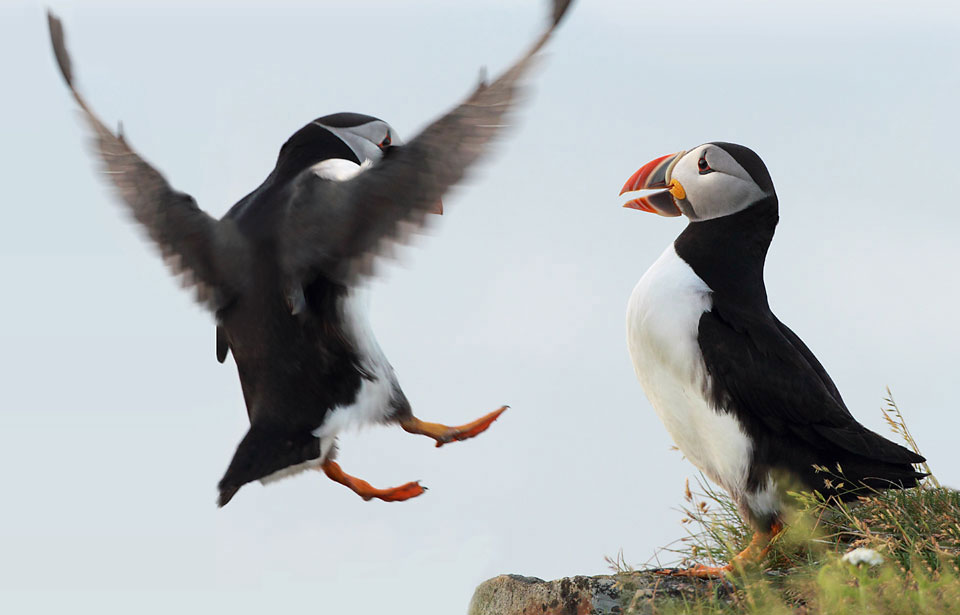 Megan Lorenz
Atlantic Puffin
Atlantic Puffin Atlantic Puffin (15 seconds) Atlantic Puffin (30-seconds) Atlantic Puffin (30-seconds, kids) Ocean Commotion (webisode)
Megan Lorenz
Atlantic Puffin
Atlantic Puffin Atlantic Puffin (15 seconds) Atlantic Puffin (30-seconds) Atlantic Puffin (30-seconds, kids) Ocean Commotion (webisode)
The Atlantic Puffin Fratercula arctica is one of four species of puffins and is the only one that lives on the North Atlantic Ocean. One of the most popular and well-known seabirds in Canada, its colourful features often appear on calendars and posters. In 1992 it was made the official bird of the province of Newfoundland and Labrador. Most people know a puffin only when it is "dressed up" for the breeding season and would hardly recognize it in its plainer winter garb.
Fratercula means "little brother" or "friar," perhaps a reference to the puffin’s black and white dress. Puffins belong to the family of birds called the auks, or Alcidae; other members of the family are the Dovekie, murres, guillemots, the Razorbill, auklets, murrelets, and the extinct Great Auk. Auks are diving seabirds of the northern hemisphere and use their wings to propel themselves underwater in pursuit of prey such as small fish.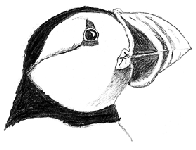
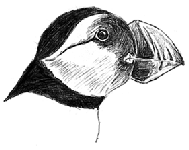
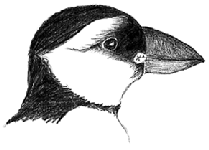

Upper left: adult Atlantic Puffin in breeding plumage. Upper right: adult Atlantic Puffin in winter plumage. Lower left: juvenile Atlantic Puffin. Lower right: adult Common Murre.
The familiar breeding adult has a striking orange, yellow, and bluish bill and matching bright orange feet. The bill is wide in profile and narrow side-to-side. A puffin’s greyish white face is decorated with fleshy yellow rosettes at the base of the bill and red rings and small bluish plates around the eyes. The upper parts, including the head, back, and wings, are black and contrast dramatically with the brilliant white underparts. The sexes look the same, although males tend to be slightly larger than females. -
 Pam Ann Mullins
Bald Eagle
Pam Ann Mullins
Bald Eagle
The Bald Eagle Haliaeetus leucocephalus is an enormous bird. Haliaeetus denotes "sea eagle," and leucocephalus refers to its white head. The wings, wide and long for soaring, span more than 2 m. When perched, the bird measures about 76 cm tall. Weights of over 7 kg are not uncommon. On average, females are larger than males, and juveniles are larger but lighter in weight than adults of the same sex. Bald Eagles that breed in the southern United States are smaller than those that breed farther north.
Males and females have identical plumage. Adults have a dark brown (almost black) body that contrasts sharply with the white feathers on the head and tail, and the yellow beak, eyes, and legs. It takes a young Bald Eagle four or five years to achieve this distinctive coloration. Until then, bird watchers may confuse it with other birds, such as the Turkey Vulture and Golden Eagle.
To kill and handle prey, Bald Eagles have massive beaks, large talons, and oversized feet equipped with small spikes, called spicules.
Signs and sounds
Bald Eagles do not have a wide range of calls. Their voice, which carries long distances, sounds something like a gull’s scream broken into a series of notes. -
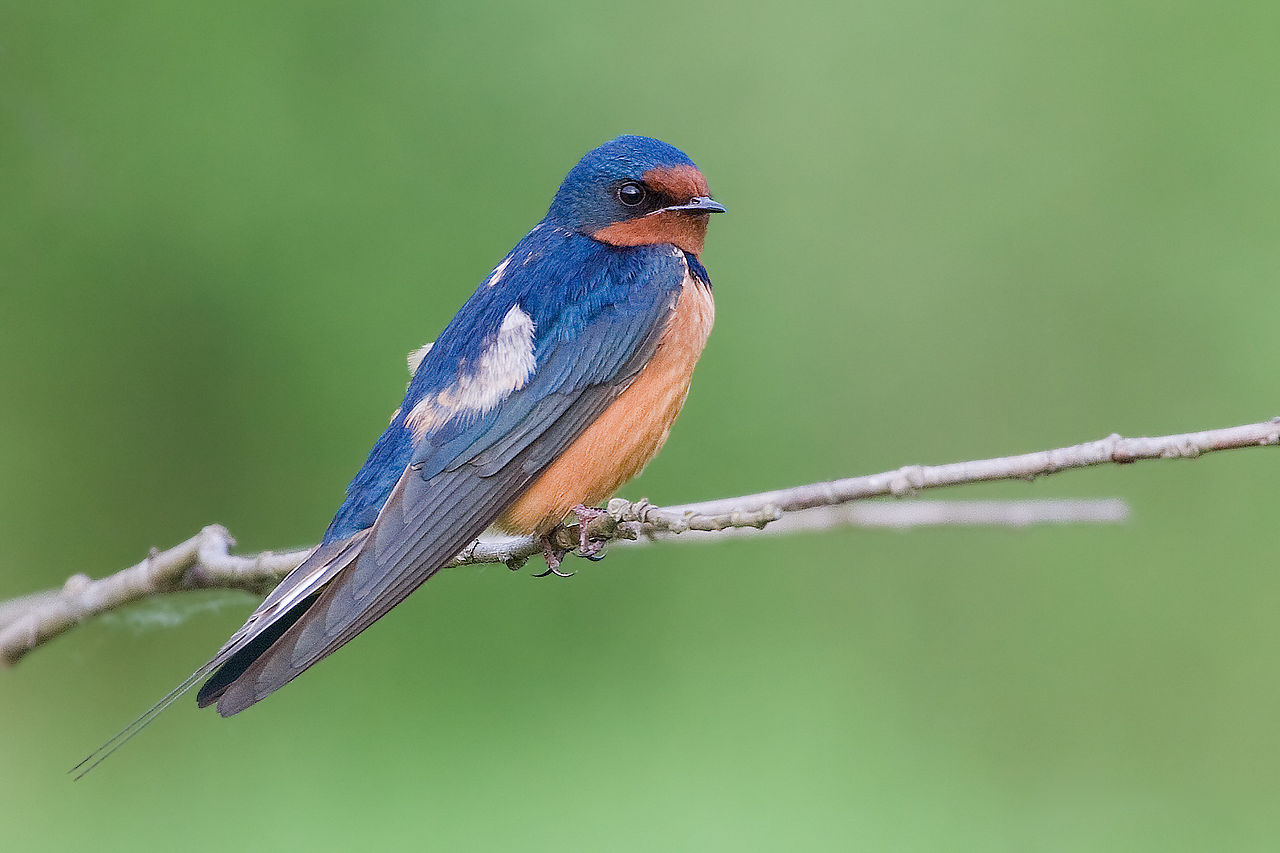 J.J. Cadiz
Barn Swallow
Barn Swallow (60 seconds) Barn Swallow (30 seconds)
J.J. Cadiz
Barn Swallow
Barn Swallow (60 seconds) Barn Swallow (30 seconds)

Barn Swallow (photo by J.J. Cadiz)The Barn Swallow (Hirundo rustica) is a medium-sized songbird, about the size of a sparrow. It measures between 15 and 18 centimeters (cm) in length and 29 to 32 cm in wingspan, and weighs between 15 and 20 grams (g). But while it is average-sized, it’s far from average-looking! Its back and tail plumage is a distinctive steely, iridescent blue, with light brown or rust belly and a chestnut-coloured throat and forehead. Their long forked tail and pointed wings also make them easily recognizable. It’s these wings, tail and streamlined bodies that make their fast, acrobatic flight possible. Both sexes may look similar, but females are typically not as brightly coloured and have shorter tails than males. When perched, this swallow looks almost conical because of its flat, short head, very short neck and its long body.
Although the average lifespan of a Barn Swallow is about four years, a North American individual older than eight years and a European individual older than 16 years have been observed.
Sights and sounds:
Like all swallows, the Barn Swallow is diurnal –it is active during the day, from dusk to dawn. It is an agile flyer that creates very acrobatic patterns in flight. It can fly from very close to the ground or water to more than 30 m heights. The species may be the fastest swallow, as it’s been recorded at speeds close to 75 kilometers per hour (km/h). When not in flight, the Barn Swallow can be observed perched on fences, wires, TV antennas or dead branches.
Both male and female Barn Swallows sing both individually and in groups in a wide variety of twitters, warbles, whirrs and chirps. They give a loud call when threatened, to which other swallows will react, leaving their nests to defend the area. -
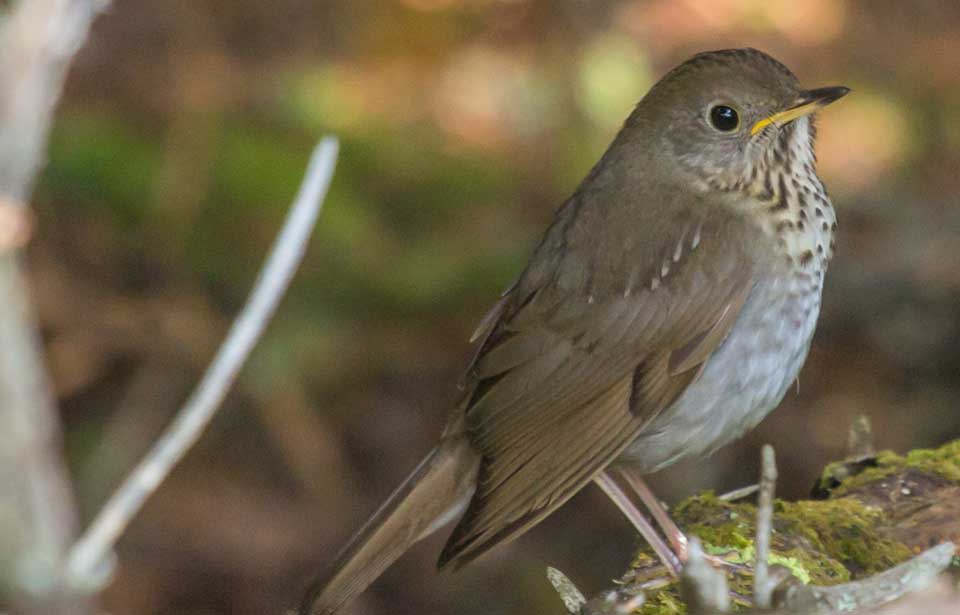 Laura Erickson
Bicknell's Thrush
Laura Erickson
Bicknell's Thrush
Bicknell’s Thrush Catharus bicknelli was discovered in 1881 by Eugene Bicknell in New York’s Catskill Mountains, but it was only named a distinct species in 1995. Before then, it was thought to be a subspecies of the Gray-cheeked Thrush Catharus minimus, which it closely resembles. It was a Canadian ornithologist, Henri Ouellet, who convinced authorities that the Bicknell’s and the Gray-cheeked thrushes are distinct species. Because this thrush favours habitats that are difficult for humans to explore and because it is relatively rare, it remains one of the least-known birds in North America.
Bicknell’s Thrush is a small, sparrow-sized bird. The male and the female are identical except that the male is slightly larger. Measuring 16 to 18 cm long and weighing 25 to 30 g, Bicknell’s Thrush is one of the smallest of the Catharus thrushes. A pale yellow colour extends from the bird’s face halfway or more along its lower mandible. At a distance, the bird appears to be mainly a drab, olive brown. Close up, however, the plumage is more attractive, with a warmish brown cast to the back and a chestnut brown tint on the upper tail feathers. This thrush has a striking buff-coloured chest with dark spots decorating the chin, breast, and sides. Its legs are purplish-brown, and the soles of its feet are pale yellow. Its large eyes are an adaptation for seeing in the darkness of its dense habitat.
One must be cautious when identifying this bird in the field. It looks like several other thrushes, chief among them the Gray-cheeked Thrush. This relative is somewhat larger, has a more uniformly olive-grey back, less pale yellow on the lower mandible, and a slightly different song. Fortunately, the ranges of these two species do not overlap, except during the migration period, making it easier to distinguish one from the other. -
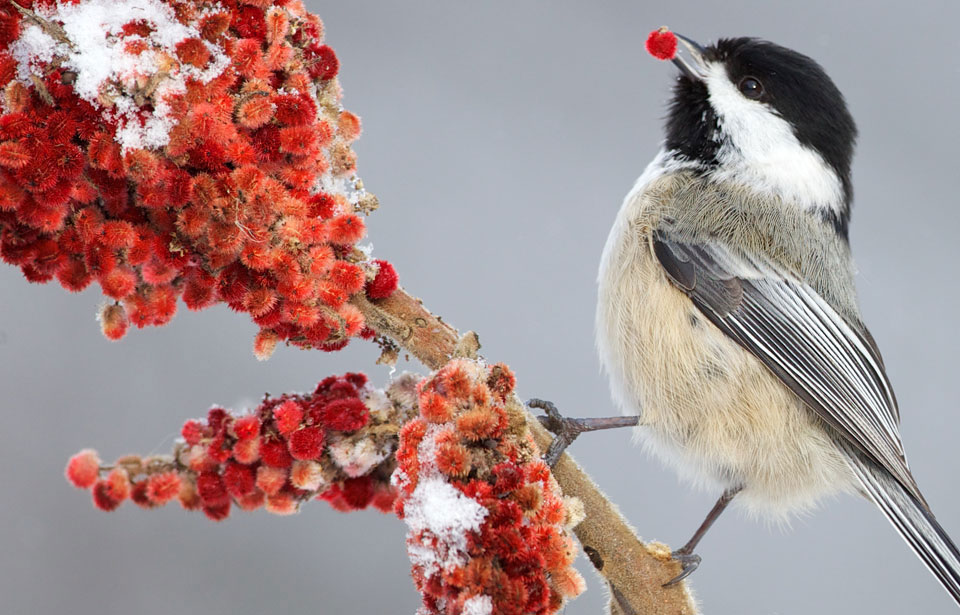 Missy Dawn Mandel
Black-capped Chickadee
Black-capped Chickadee (30 seconds) Black-capped Chickadee (60 seconds)
Missy Dawn Mandel
Black-capped Chickadee
Black-capped Chickadee (30 seconds) Black-capped Chickadee (60 seconds)
Measuring only 12 to 15 cm from bill-tip to tail-tip, the Black-capped Chickadee Poecile atricapilla is greenish-grey above with a white underside shading to light brownish buff along its flanks. Its long, dark-grey tail looks like a handle. A black cap, well drawn over sparkling eyes, covers its head from cone-like bill to nape, or back of the neck. Pure white cheek patches and a triangular black throat patch complete its most conspicuous markings. Because chickadees inhabit such a wide variety of climates and habitats, birds from different populations may vary somewhat in size and plumage.
A number of chickadee species resemble the Black-capped Chickadee. The Mountain Chickadee Poecile gambeli is distinguished from the Black-capped by a white line over the eye. In Canada, it lives only in the mountains of British Columbia and Alberta. The Mountain Chickadee is closely related to the Black-capped, and the two species hybridize, or interbreed, occasionally.
The Gray-headed Chickadee Poecile cincta is widely distributed across Asia and Europe. In North America, this brownish-grey chickadee is found in a small corner of the northwestern Yukon and eastern Alaska, where it lives in the willow and spruce woods bordering the treeline.
The Boreal Chickadee Poecile hudsonica has a seal-brown cap, greyish-brown above and dusky white or light grey below with rust-coloured sides. Its cheek patches are often dusky white and the throat patch is black. Like the Black-capped, it lives right across Canada, but resides in the belt of coniferous forest that extends to the northern treeline. Boreal and Black-capped Chickadees overlap at the edges of their breeding ranges, but do not hybridize. -
 BIll McMullen
Blue Jay
Blue Jay
BIll McMullen
Blue Jay
Blue Jay
The Blue Jay Cyanocitta cristata is a little larger than an American Robin, about 30 cm in length from the tip of its bill to the tip of its tail. A white-faced bird with a blue crest, back, wings, and tail, it is strongly marked with black and white. Male and female Blue Jays are very similar in appearance. The crest, an elongated crown of feathers found in many jays, is raised or lowered according to the bird’s mood. In moments of high excitement and aggression the crest may be fully erected, forming a prominent peak. When the Blue Jay is greatly surprised or excited, the crest points forward. If the bird is frightened, the crest bristles out like a bottle brush. The Blue Jay’s crest position, when erected, is emphasized by a black band that crosses over the back of the head, a continuation of the broad band or necklace across the chest. However, when the bird is feeding among other jays, when it is ready to flee, or when it is quietly resting, the crest is laid flat on top of the head, giving the bird a quite different and somewhat untidy appearance.
The Blue Jay’s scientific name is derived from Greek and Latin words and means, in reverse order, "crested, blue chattering bird," an apt designation. The Blue Jay belongs to the crow family, or Corvidae, a group of 100 related species including ravens, rooks, jackdaws, crows, magpies, and jays. Some of these species are the largest members of the order Passeriformes, or perching songbirds. The family, which appears around the world, is best represented in the northern hemisphere. These birds are of ancient lineage; fossil remains of corvids have been identified from Miocene deposits 25 million years old. -
 Leahb Paxon
Bufflehead
Leahb Paxon
Bufflehead
The Bufflehead Bucephala albeola is Canada’s smallest diving duck. Strikingly patterned in black and white, and constantly active, it attracts attention out of proportion to its relatively small numbers.
Buffleheads are compactly built birds, with males, or drakes, averaging 450 g in weight and females about 340 g. During their migrations they are much heavier, with up to 115 g of stored fat as fuel for their travels. Hunters sometimes call these fat birds "butterballs."
Adult males are black above and white below, with bright pink feet. They wear a white "shawl" around the back of the head, and a broad white band extends from front to back across each wing. The females and first-year males are more drab, with the dark areas sooty-grey or brownish rather than black, and the white areas duller and smaller in size than in adult males. Like their near relatives, the goldeneyes and mergansers, Bufflehead males do not attain adult plumage until their second winter, and first breed when nearly two years old.
Signs and sounds
Both sexes are normally silent, and the only sound commonly heard from Buffleheads is the grrk call of females when alarmed near the nest or brood. -
 William Kleinfelder
Burrowing Owl
Burrowing Owl (30 seconds)
William Kleinfelder
Burrowing Owl
Burrowing Owl (30 seconds)
The Burrowing Owl Athene cunicularia gained its name from a particular behaviour: it nests underground. But contrary to the impression given by the bird’s scientific name, which means “little digger,” this owl rarely digs its own burrow. Instead, it constructs its nest in burrows vacated by small mammals like ground squirrels, badgers, and prairie dogs.
The adult Burrowing Owl is smaller than a pigeon. It weighs between 125 and 185 g and stands from 19 to 20 cm tall. Its body is generally brown, mottled with white flecks and barred across the chest. This earth-coloured plumage provides good camouflage in the grasslands where the owl lives. The Burrowing Owl’s head is rounded, and its eyes and beak are yellow. The sexes look similar, but the male is slightly lighter in colour.
While they resemble the adults for the most part, the young have rusty-coloured throats and buff-coloured breasts without barring; they acquire their adult-like plumage during the late summer.
Signs and sounds
To discourage predators, the Burrowing Owl can make a noise like the rattling hiss of a rattlesnake’s tail. Males will repeat a doleful coo-coooo, mainly to attract females. Otherwise, Burrowing Owls make a variety of sounds to each other that are rarely heard by humans. -
 Lu Zhang
Canada Goose
Canada Goose Centennial of the Migratory Birds Convention Centennial of the Migratory Birds Convention (30 seconds) Urban Wildlife (30 seconds) Urban Wildlife (60 seconds)
Lu Zhang
Canada Goose
Canada Goose Centennial of the Migratory Birds Convention Centennial of the Migratory Birds Convention (30 seconds) Urban Wildlife (30 seconds) Urban Wildlife (60 seconds)
Many people can recognize a Canada Goose Branta canadensis by its characteristic black head, white cheek patches, and long black neck. However, there are several different races, so a Canada Goose in one region may be quite different from a Canada Goose in another. Although there has been some disagreement about the exact number of races of Canada Geese, most scientists believe that there are 11.
Members of the different races range in size from one of the smallest geese, the Cackling Canada Goose, which can weigh as little as 1.1 kg, to the largest of all geese, the Giant Canada Goose, which can weigh up to 8 kg. Wingspans vary between about 90 cm and 2 m. The underparts range in colour from light pearl-grey to chestnut, and even blackish brown. Differences in body proportions, particularly the relative length of the neck, the body shape, and the body stance, further distinguish the different races. In general, the larger the bird, the longer the neck and the more elongated the body. Please note: Four former races of Canada Goose are now considered a separate species, the Cackling Goose. These geese all breed in the Arctic, and in general, they are smaller than Canada Geese. A revised version of this fact sheet reflecting this change will be posted soon.
Newly hatched Canada Geese have a coat of yellow to olive down that darkens to dull grey over the first few weeks of life. As the birds grow, feathers gradually cover the down, and by the time the young geese are ready to fly in late summer, they are nearly indistinguishable from their parents. From that point on, both males and females look the same throughout the year. -
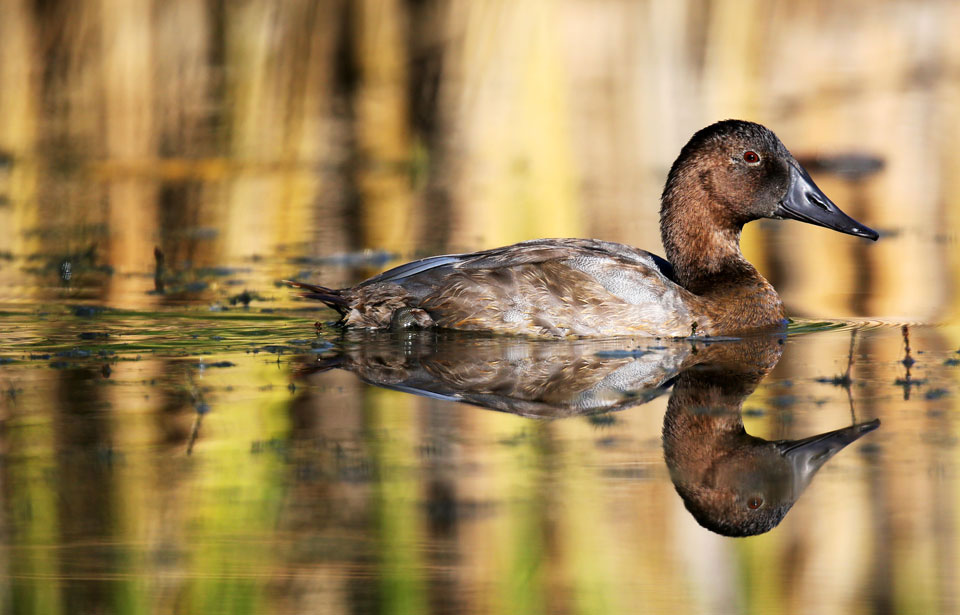 Kevin Friesen
Canvasback
Canvasback
Kevin Friesen
Canvasback
Canvasback
The Canvasback Aythya valisineria is a wild duck that is found only in North America. The adult male, or drake, is a large white-bellied, grey-backed duck with a black chest, sloping forehead, and ruddy chestnut head and neck. The adult female is about the same size and has the same sloping forehead and long bill. Less colourful, she is more able to blend into her surroundings when on the nest or rearing her young. She is white-bellied with a pale brown back and reddish brown head, neck, and chest. Male and female Canvasbacks resemble Redheads and Ring-necked Ducks of the corresponding sex, but can be distinguished from them by their longer black bills and less abrupt foreheads.
In early autumn, the young of both sexes resemble adult females, although their breast plumage is more mottled and their back plumage is darker. During November, the young males begin to resemble the adult males, and by February the adult plumage of both sexes has almost completely grown in.
The genus Aythya to which the Canvasback belongs includes 12 species, five of which occur in North America. These are the Canvasback, Redhead, Greater Scaup, Lesser Scaup, and Ring-necked Duck. Generally, all Aythya species have rounded bodies with large feet, legs set back on the body, and a broad bill. They are all diving ducks.
Signs and sounds
During courting, the male utters a moaning, almost dove-like, ik-ik-cooo cry. The female answers with a low quacking cuk-cuk. -
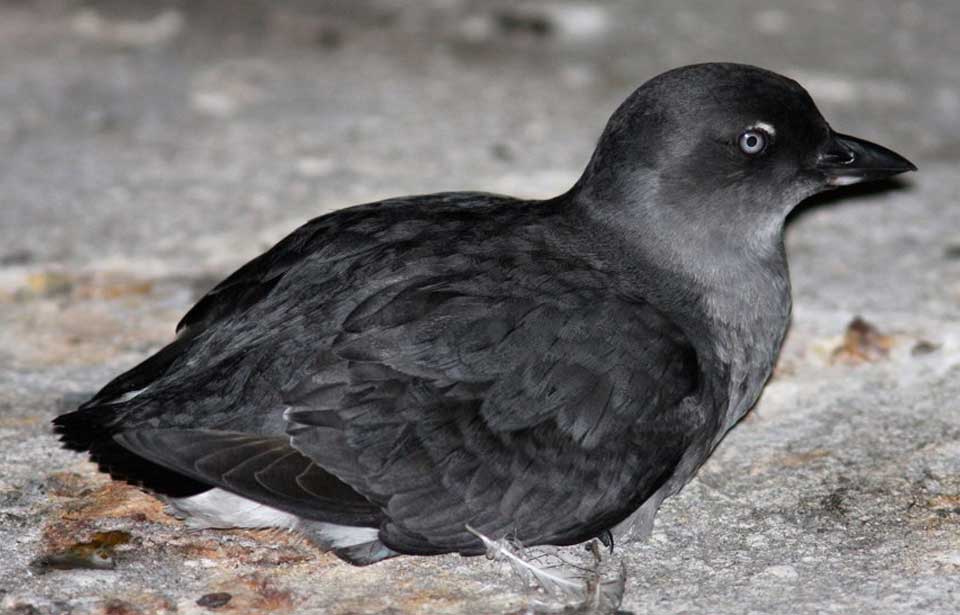 Oscar Johnson
Cassin's Auklet
Ocean Commotion (webisode)
Oscar Johnson
Cassin's Auklet
Ocean Commotion (webisode)
Cassin’s Auklet Ptychoramphus aleuticus is a member of a large successful family of seabirds, the auks (Alcidae), that inhabits the north Atlantic, Pacific, and Arctic oceans. One of the least known and most rarely seen of British Columbia’s seabirds, it could also be the province’s most abundant breeding bird. Four million Cassin’s Auklets live in British Columbia, but they are difficult to see and study because they spend most of their lives on the open ocean.
In keeping with its secretive character, the Cassin’s Auklet has dull, grey-brown feathers all year round. The only flourishes on this nondescript plumage are white eyebrows, which are too small to be seen at any distance. The featherless parts of the bird are more colourful. The feet are bright blue, and there is a pale pink patch on the lower half of the bill. The eyes, which are brown in the young, become a striking metallic grey in the adult.
Other auks in British Columbia include the Tufted Puffin, Rhinoceros Auklet, Ancient Murrelet, Marbled Murrelet, Common Murre, and Pigeon Guillemot.
Signs and sounds
Like many nocturnal birds that need to find their mates and young at night, Cassin’s Auklets are vocal on the colonies. In the small hours of the morning in May and June, they set up a chorus reminiscent of spring peepers and other swarming frogs. Where thousands nest, the din is deafening. Once the young leave the nest, the nightly choruses cease, and only the occasional tentative signal from late breeders is heard. By late July the colonies are deserted and silent. -
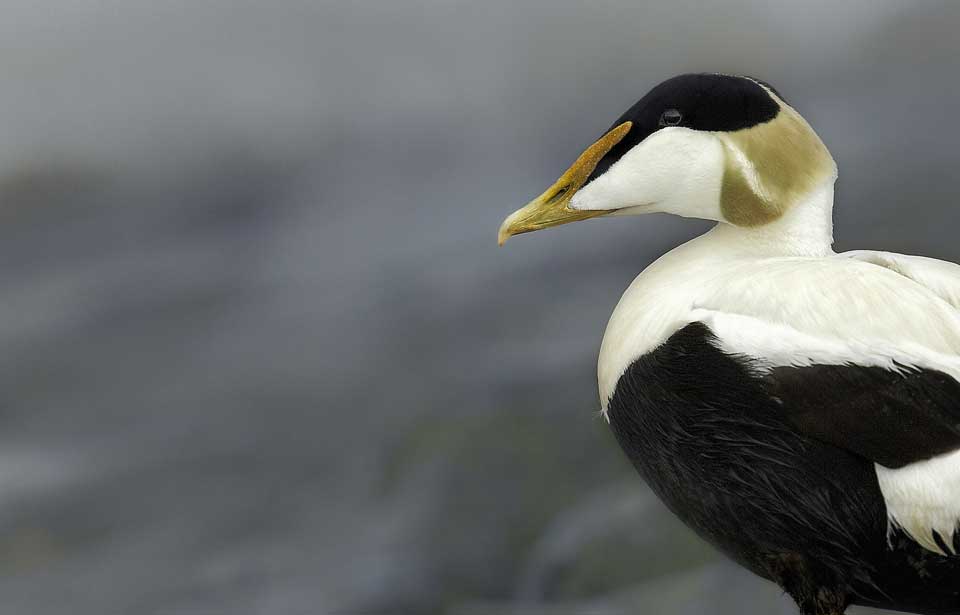 Marijke Mooy
Common Eider
Ocean Commotion (webisode)
Marijke Mooy
Common Eider
Ocean Commotion (webisode)
The Common Eider Somateria mollissima is the largest duck in the northern hemisphere. It weighs an average of 1 800 g, but its weight can vary from 850 to 3 025 g depending on race, sex, and time of year. There are four Common Eider races in North America; subtle differences in body size and bill structure distinguish each race from the other.
The plumage of the Common Eider varies considerably. It passes through several stages while the bird is growing to maturity, and after the bird reaches adulthood at about three years old, the plumage alternates between two colours each year as a result of moulting, or the replacement of old feathers with new. In addition, the male’s plumage differs from the female’s.
Between the ages of three weeks and three years, male Common Eiders moult their feathers eight times, changing their colour from a juvenile blackish brown to an adult olive-brown and white in winter and a striking black and white, with a small area of light emerald green on the back and sides of the head, during the breeding season. Changes in female plumage are less dramatic: from a juvenile blackish brown, the duck becomes rusty-to-tan. The female’s summer colours provide good camouflage in the vegetation and rocks of the offshore islands on which she breeds.
Common Eiders can live 20 years, one of the longest lifespans among sea ducks. However, the expected lifespan for eider populations which are heavily harvested may be much shorter.
Signs and sounds
Ducklings utter a number of sounds, ranging from a high-pitched note of contentment, which they give especially when they are feeding in the water, to a distress call—a monosyllabic piping.
When they are alarmed, adult Common Eiders emit a series of hoarse kor-korr-korr notes. When courting, drakes give a haunting call much like the cooing of pigeons, which can travel great distances across water on calm days.Females are less vocal than males. They produce a series of throaty calls during courtship and feeding and an abrupt cluck-cluck-cluck when defending their ducklings from avian predators such as herring gulls.
-
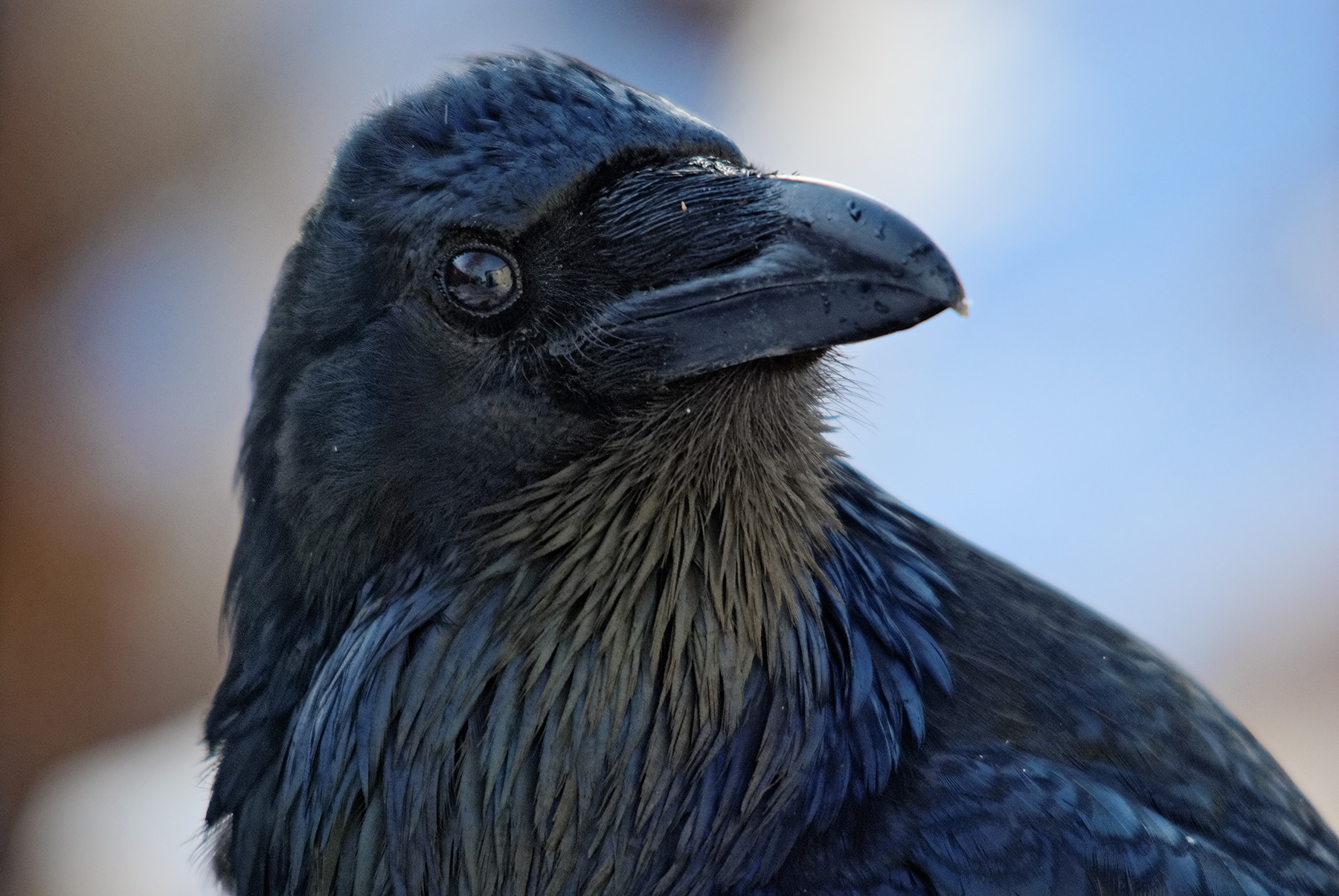 Keith Williams
Common Raven
Common Raven (15 seconds) Common Raven (Youth) Common Raven Common Raven (30 seconds)
Keith Williams
Common Raven
Common Raven (15 seconds) Common Raven (Youth) Common Raven Common Raven (30 seconds)
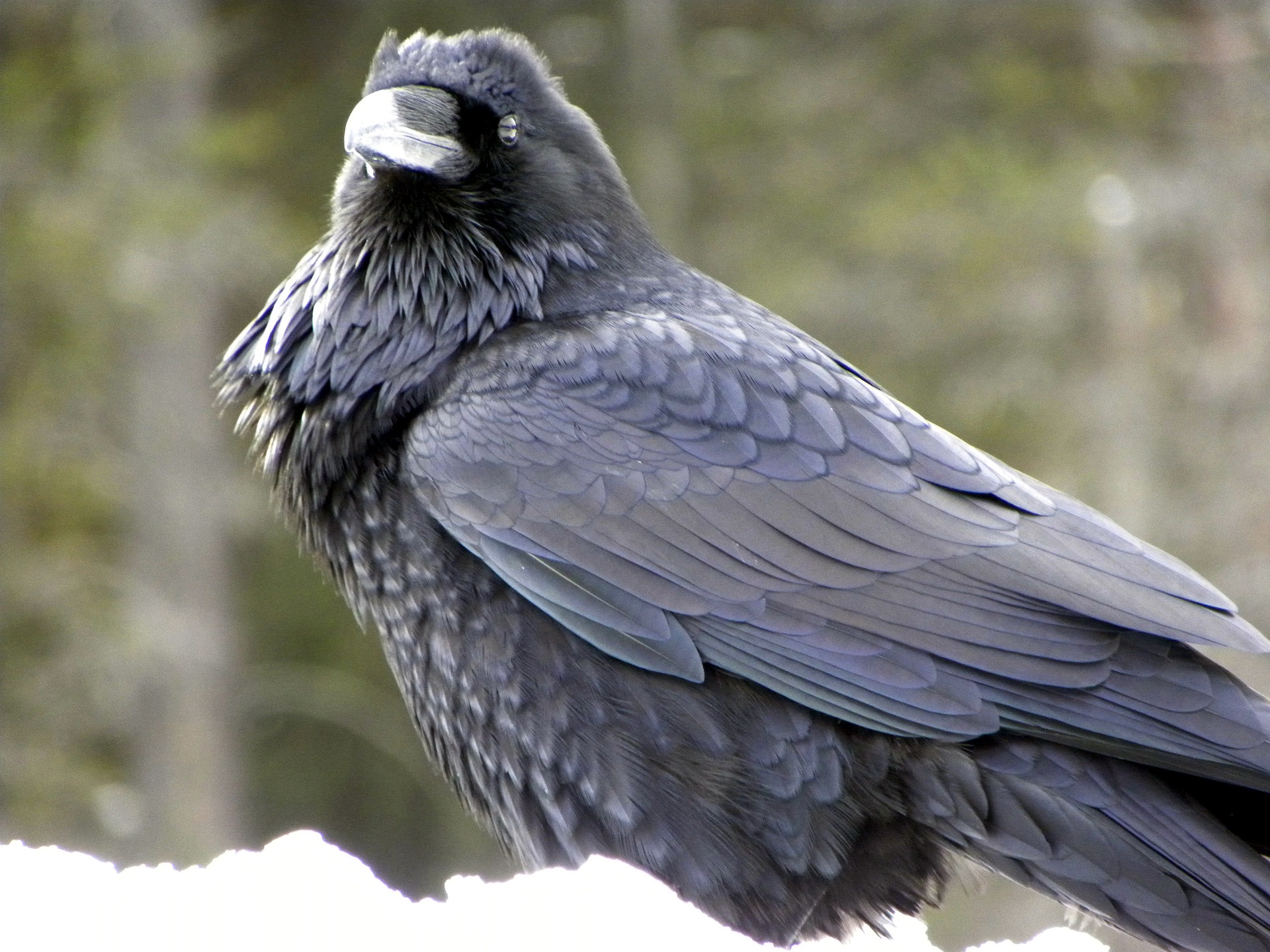
Common Raven showing its hackles and large beak The Common Raven Corvus corax is one of the heaviest passerine birds and the largest of all the songbirds. It is easily recognizable because of its size (between 54 and 67 centimetres long, with a wingspan of 115 to 150 cm, and weighing between 0.69 and two kilograms) and its black plumage with purple or violet lustre. It has a ruff of feathers on the throat, which are called 'hackles', and a wide, robust bill. When in flight, it has a wedge-shaped tail, with longer feathers in the middle. While females may be a bit smaller, both sexes are very similar. The size of an adult raven may also vary according to its habitat, as subspecies from colder areas are often larger.
A raven may live up to 21 years in the wild, making it one of the species with the longest lifespan in all passerine birds.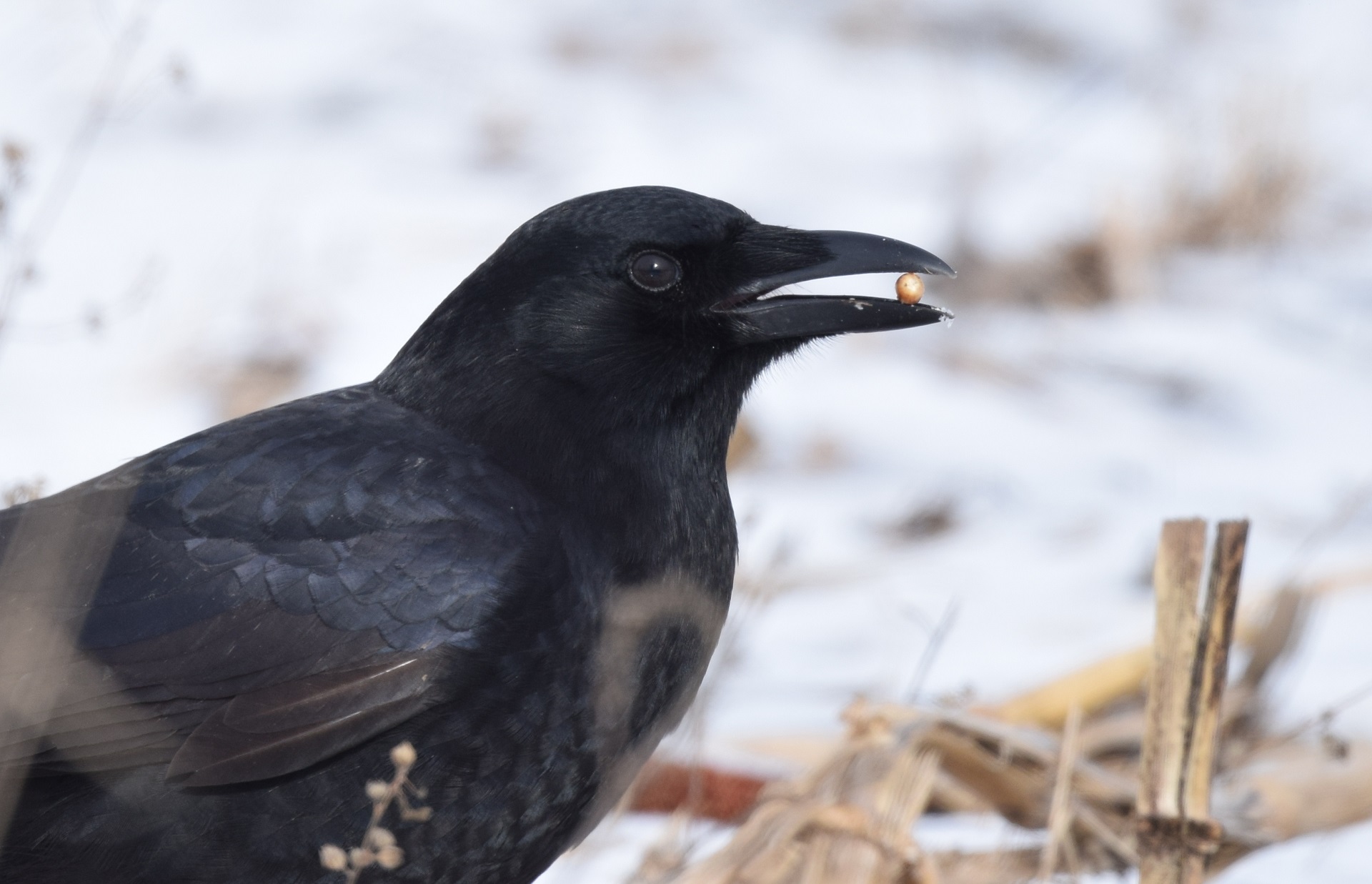
American Crow The Common Raven is often mistaken for an American Crow in southern Canada and the United States. Both birds are from the same genus (order of passerine birds, corvid family –like jays, magpies and nutcrackers, Corvus genus) and have a similar colouring. But the American Crow is smaller (with a wingspan of about 75 cm) and has a fan-shaped tail when in flight (with no longer feathers). It also has a narrower bill and lacks the raven’s hackles. Their cries are different: the raven produces a low croaking sound, while the crow has a higher pitched cawing cry. While adult ravens tend to live alone or in pairs, crows are more often observed in larger groups.
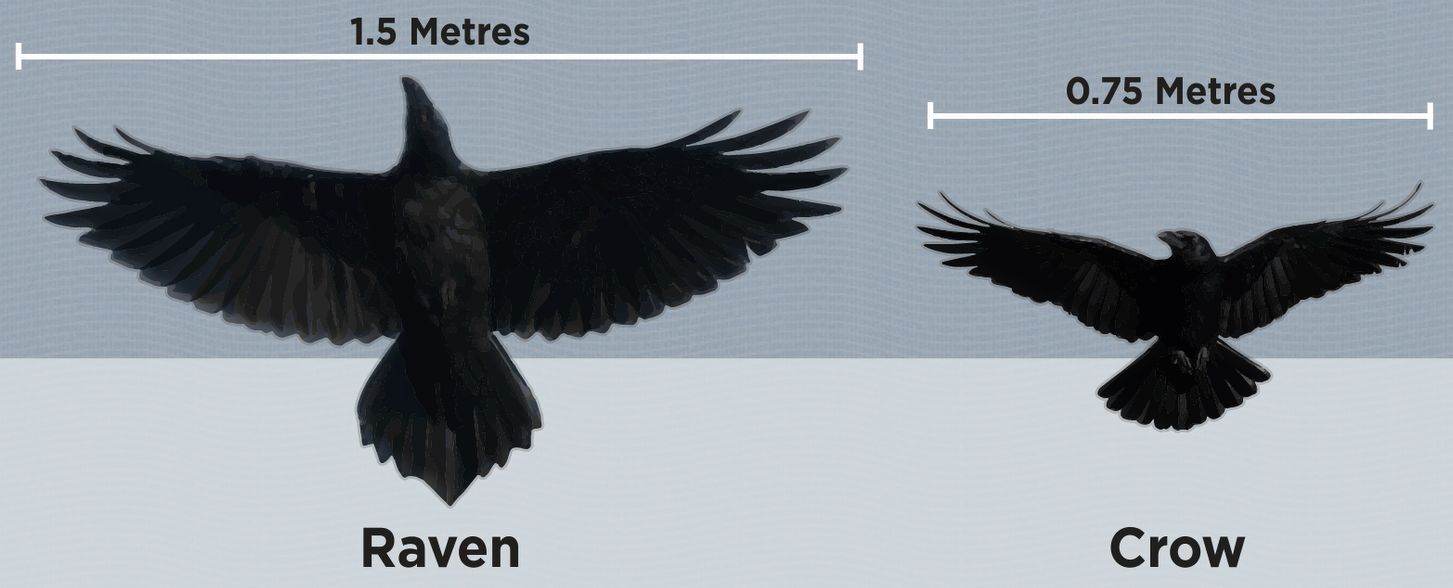
Common Raven vs American Crow -
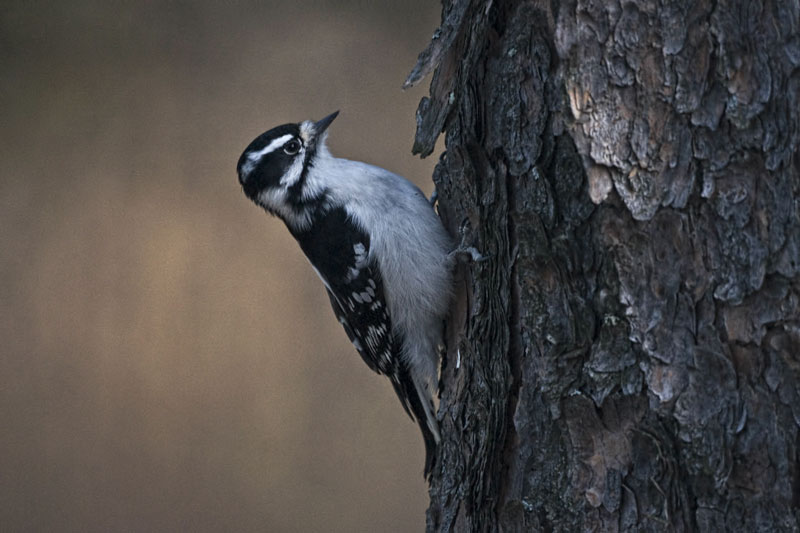 Laurenz Baars
Downy Woodpecker
Laurenz Baars
Downy Woodpecker
Of the 198 species of woodpeckers worldwide, 13 are found in Canada. The smallest and perhaps most familiar species in Canada is the Downy Woodpecker Picoides pubescens. It is also the most common woodpecker in eastern North America.
This woodpecker is black and white with a broad white stripe down the back from the shoulders to the rump. Its wings are checkered in a black and white pattern that shows through on the wings’ undersides, and the breast and flanks are white. The crown of the head is black; the cheeks and neck are adorned with black and white lines. Male and female Downy Woodpeckers are about the same size, weighing from 21 to 28 g. The male has a small scarlet patch, like a red pompom, at the back of the crown.
The Downy Woodpecker looks much like the larger Hairy Woodpecker Picoides villosus, but there are some differences between them. The Downy’s outer tail feathers are barred with black, unlike the Hairy Woodpecker’s, which are all white. The Downy is about 6 cm smaller than the Hairy, measuring only 15 to 18 cm from the tip of its bill to the tip of its tail. And the Downy’s bill is shorter than its head, whereas the Hairy’s bill is as long as or longer than its head length. The Downy’s name refers to the soft white feathers of the white strip on the lower back, which differ from the more hairlike feathers on the Hairy Woodpecker.
Woodpeckers are a family of birds sharing several characteristics that separate them from other avian families. Most of the special features of their anatomy are associated with the ability to dig holes in wood. The straight, chisel-shaped bill is formed of strong bone overlaid with a hard covering and is quite broad at the nostrils in order to spread the force of pecking. A covering of feathers over the nostrils keeps out pieces of wood and wood powder. The pelvic bones are wide, allowing for attachment of muscles strong enough to move and hold the tail, which is important for climbing.
Another special anatomical trait of woodpeckers is the long, barbed tongue that searches crevices and cracks for food. The salivary glands produce a sticky, glue-like substance that coats the tongue and, along with the barbs, makes the tongue an efficient device for capturing insects.
Signs and soundsAs early as February or March a Downy Woodpecker pair indicate that they are occupying their nesting site by flying around it and by drumming short, fast tattoos with their bills on dry twigs or other resonant objects scattered about the territory. The drumming serves as a means of communication between the members of the pair as well. Downys also have a variety of calls. They utter a tick, tchick, tcherrick, and both the male and the female add a sharp whinnying call during the nesting season.
Hatchlings give a low, rhythmic pip note, which seems to indicate contentment. When a parent enters the nest cavity, the nestlings utter a rasping begging call, which becomes stronger and longer as the chicks mature. -
 Rick Dobson
Evening Grosbeak
Rick Dobson
Evening Grosbeak
The Evening Grosbeak Coccothraustes vespertinus is a plump, sturdy finch. Its body is about the size of a robin’s, but its neck and its slightly forked tail are considerably shorter. Its prominent thick cone-shaped bill is truly tremendous for a bird of its size. The plumage of the adult male is spectacular, with golden yellow body feathers and a conspicuous gold band across the forehead. The underparts are yellow, and the crown and neck feathers resemble glossy, rich brown velvet. Tail feathers are jet black, as are the wing feathers except for a snow-white shoulder patch. Sub-adult males may be identified by dark areas on the shoulder patches.
Adult females are comparatively subdued in appearance. Their bodies are smoky silver-grey with areas of yellow on the sides, nape, and rump. That part of the wing lining nearest the body is bright yellow. The black tail and wing feathers have distinct white patches, and the underparts are lighter grey with undertail coverts and chin usually buffy and silvery white. By the time they are able to fly the plumage of young female and male Evening Grosbeaks resembles that of their parents sufficiently for sexual identification.
The Evening Grosbeak’s bill is bone coloured during winter, but it undergoes a dramatic change in pigmentation in early spring. Its new colour matches precisely the green of fresh deciduous buds and leaves and also the new needles that will tip the spruce boughs around the site where the bird’s nest will be built a few weeks hence. The Evening Grosbeak conceals its body in the trees and in order to see lifts only its head and bill, which looks like a young green spruce or balsam cone. This is a fine example of protection through appropriate coloration.
Signs and sounds
The Evening Grosbeak’s flight is undulating. Its wing-beat is rapid with white wing patches flashing conspicuously, and the birds often call in flights.
These birds are noisy and possess a wide repertoire of calls and cries. Their only song has been described as "a series of abrupt warbles" and even this is seldom heard. The most typical call is a monosyllabic chirp that sounds very much like the chirp of the common House Sparrow, amplified. It is employed by each bird to proclaim its place in the flying flock. A lone individual or a member of a perching flock utters this same cry, apparently to advertise its presence to all within hearing range.
The Evening Grosbeak uses a wide variety of sounds to register fear, surprise, anger, pain, uncertainty, curiosity, and alarm. Most of these sounds can be heard by observing a flock closely for a few minutes at a crowded feeding tray. -
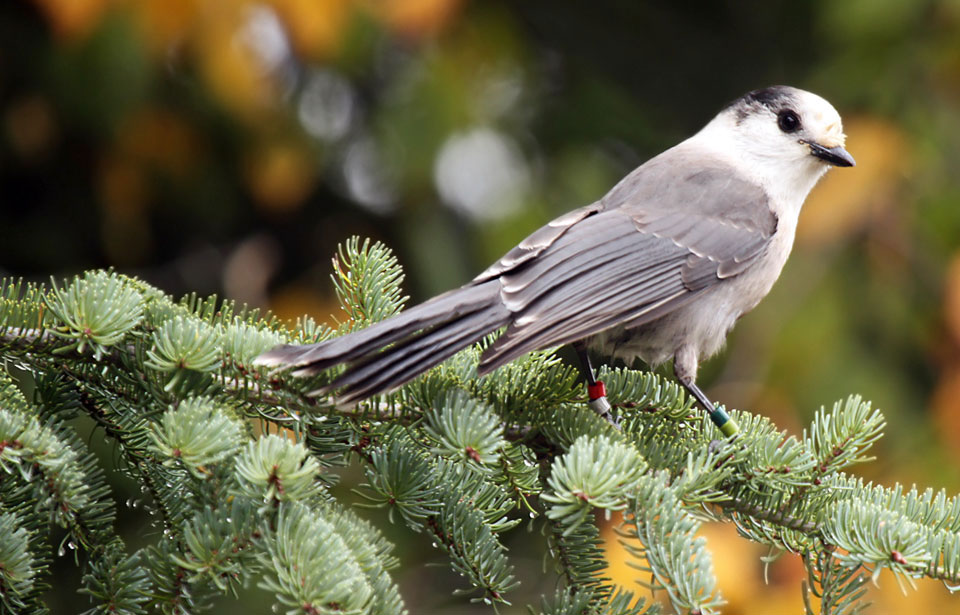 Megan Lorenz
Gray Jay
Megan Lorenz
Gray Jay
The Gray Jay Perisoreus canadensis is only slightly smaller than a Blue Jay and, silhouetted against the sky, the two birds are surprisingly similar, although the Gray Jay is a somewhat slower and weaker flier than its southern relative. Close up, the Gray Jay can hardly be confused with any other bird. Its back and tail are a medium gray and the underparts a slightly lighter shade, but the head has a quite striking and unique pattern of black and white. The short, black bill, the large dark eyes, and the thick, fluffy plumage, help give the Gray Jay a soft, rounded appearance that most people find highly appealing. For the Gray Jay, of course, the thick plumage is what keeps it warm on long winter nights or in cold snaps when the temperature may be 40 below zero for days at a time.
Juvenile Gray Jays just out of the nest are very different from the adults, being a uniform, sooty gray colour all over their bodies. Young and old are so distinct, in fact, that they were at first thought to be different species. Juveniles begin their first moult in July, however, and by the end of August they essentially look just like the adults.
-
 Alicja Kukielczynska
Great Blue Heron
Great Blue Heron
Alicja Kukielczynska
Great Blue Heron
Great Blue Heron
The Great Blue Heron Ardea herodias is the largest heron in Canada. Adults stand over 1 m high with their necks outstretched, and they weigh around 2.5 kg.
This bird gives the general impression of being tall and thin: its wings, neck, bill, and legs are long. The long limbs dictate the heron’s movements: it flies with deep, slow wing beats, and on land, or in the water, it walks erect with long strides. In flight, the neck is doubled back, the head resting against the shoulders, and the long legs held straight behind (see sketch).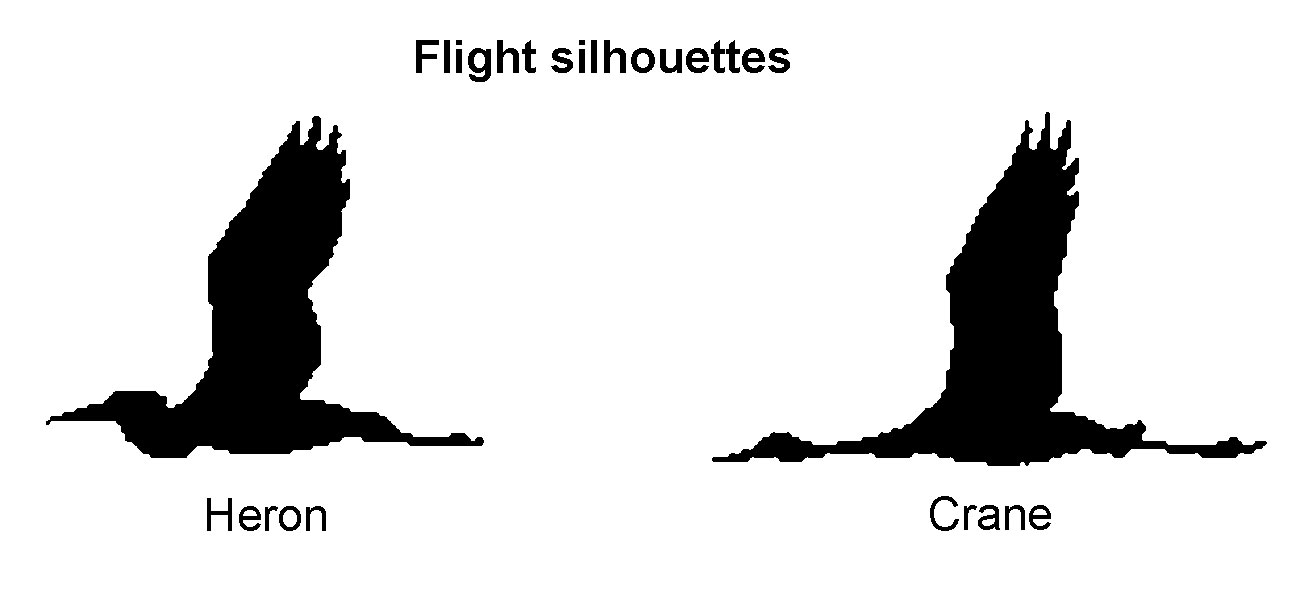
The top of the adult’s head is white with a black stripe on each side extending from the yellow eyes to slender black plumes at the back of the head. Its back is greyish blue, and its breast is white streaked with black. Breeding herons have long plumes on their breasts, flanks, and backs. The sexes look much alike, but the males are usually bigger than the females.
From birth to two years, Great Blue Herons moult, or replace old feathers with new, four times. During the first year, juveniles have grey crowns and grey wings flecked with brown, and they lack plumes. Adult Great Blue Herons show brighter colours during the breeding season, moult some plumes in summer, and change to duller colours in winter.
Great Blue Herons live long lives, some as long as 17 years.
Signs and sounds
The Great Blue Heron is generally silent, but it does have a repertoire of noises. It gives a frawnk sound at breeding colonies when alarmed, a gooo call at the end of one of its courtship displays, an occasional ee call when flying, and sometimes a series of clucks when foraging. The heron also utters a roh-roh-roh sound when it approaches the nest, perhaps to alert its mate to its arrival.
Part of the males’ courtship displays are loud bill snaps. Females snap bills when they are approaching unmated males and after they have formed a breeding pair. It is also common for paired birds to engage in a rapid side-to-side tapping of each other’s bill tips. -
 Megan Lorenz
Great Horned Owl
Megan Lorenz
Great Horned Owl
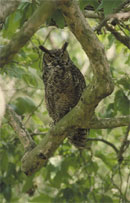 The Great Horned Owl Bubo virginianus is one of Canada’s commonest large birds of prey. The most notable physical attributes are its large size and prominent ear tufts or "horns." A predator that hunts at night, this owl has enormous yellow eyes set in a broad face, a curved beak and claws, and long fluffy feathers. Its coloration tends mainly toward brown or grey-brown, with conspicuous barring. Very dark races occur in British Columbia and Labrador, whereas extreme whiteness is seen in Great Horned Owls from the Northwest Territories and northern sections of the Prairie provinces. As is the general case with hawks and owls, the female Great Horned Owl is considerably larger than the male, averaging about 2 kg to the male’s 1 to 1.5 kg, with a wingspan of about 1.2 m. The only larger owl is the Snowy Owl, a winter migrant to southern Canada, whose maximum weight approaches 3 kg.
The Great Horned Owl Bubo virginianus is one of Canada’s commonest large birds of prey. The most notable physical attributes are its large size and prominent ear tufts or "horns." A predator that hunts at night, this owl has enormous yellow eyes set in a broad face, a curved beak and claws, and long fluffy feathers. Its coloration tends mainly toward brown or grey-brown, with conspicuous barring. Very dark races occur in British Columbia and Labrador, whereas extreme whiteness is seen in Great Horned Owls from the Northwest Territories and northern sections of the Prairie provinces. As is the general case with hawks and owls, the female Great Horned Owl is considerably larger than the male, averaging about 2 kg to the male’s 1 to 1.5 kg, with a wingspan of about 1.2 m. The only larger owl is the Snowy Owl, a winter migrant to southern Canada, whose maximum weight approaches 3 kg.
Signs and sounds
There are few rural residents, hunters, or vacationing city dwellers who have not either observed this magnificent bird in the woods or listened on a still evening to its legendary hooting—a soft yet vibrant whoo-hoo-ho-o-o. -
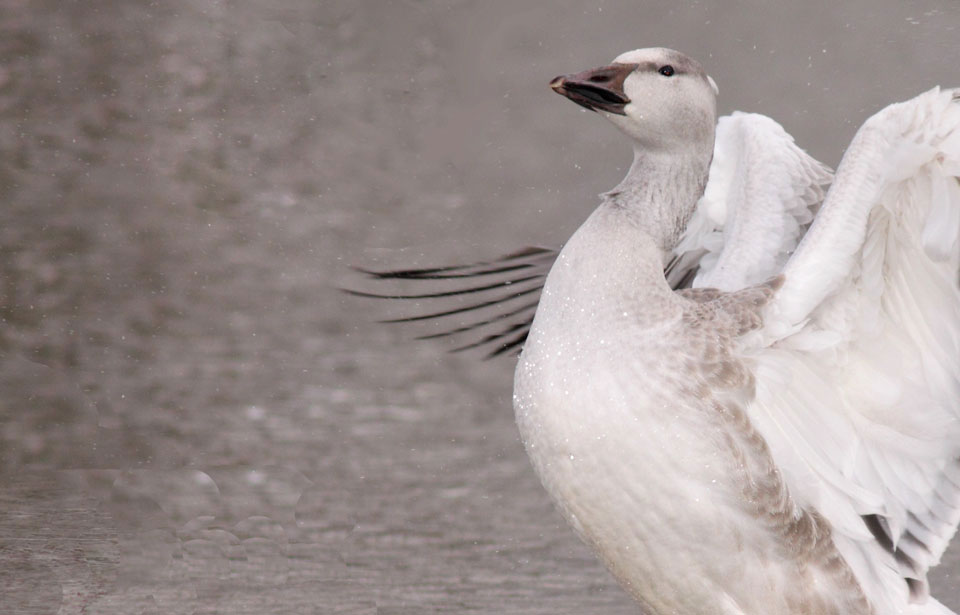 Michèle Amyot
Greater Snow Goose
Greater Snow Goose
Michèle Amyot
Greater Snow Goose
Greater Snow Goose
The adult Greater Snow Goose Chen caerulescens atlantica is almost entirely white, except for black primary feathers at the wing tips. Its feet are pinkish, as is its bill, which is also narrow and rather high and equipped with cutting edges that allow the Greater Snow Goose to feed on the roots of plants that grow on muddy banks. These cutting edges form a blackish arc, called a "grinning patch" or "smile," along each side of the bill on both the upper and lower mandibles. Because the goose constantly digs in the mud in search of food, its head often becomes stained rusty-orange from the traces of iron in the mud.
Young geese have grey plumage with greyish white patterns. Their feet and bills are a dark olive-slate colour. During their first winter, the young gradually lose their grey feathers, which are replaced by white ones. By the start of their second year, the juveniles are as white as the adults.
The wingspan of an adult Greater Snow Goose can be slightly more than 1.5 m. Adult males may weigh up to 3.5 kg; females are a little lighter. In their first fall, juveniles weigh between 1.5 and 3 kg.
Signs and sounds
The main call of the adult Greater Snow Goose—a loud, nasal whouk or kowk or a kow-luk, resembling a dog’s bark, which it utters at any time—has earned this goose a reputation as the noisiest of waterfowl. Young birds that have not bred are fairly quiet. -
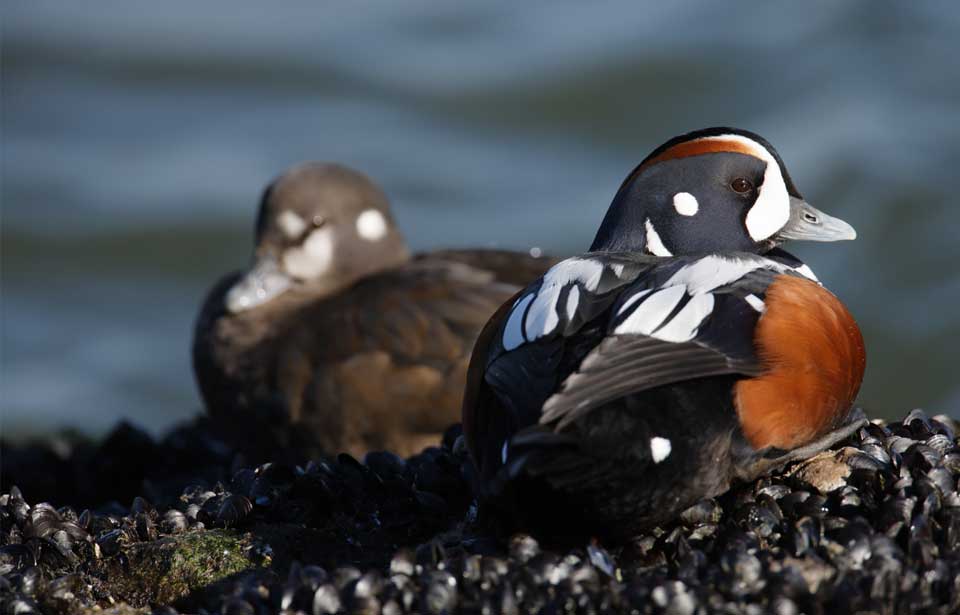 Thinkstock
Harlequin Duck
Harlequin Duck
Thinkstock
Harlequin Duck
Harlequin Duck
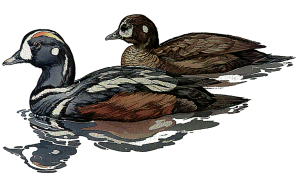
The Harlequin Duck Histrionicus histrionicus is a small, relatively uncommon sea duck. It gets its English name from characters in Italian comedy that wear masks and have oddly painted costumes. The colourful male, or drake, is one of the most attractive of sea ducks. At an average weight of less than 700 g for males and less than 600 g for females, the species is roughly half the size of an average Mallard.
From a distance, Harlequin Ducks look black or dark grey and can easily be confused with more common sea ducks, such as scoters. At close range, however, the adult male is striking and brightly coloured. It is characterized by slate blue plumage, chestnut flanks, and streaks of white on its head and body. The most distinctive markings on the head are a crescent-shaped white patch at the base of the short bill and a round white ear patch. The belly is slate grey.
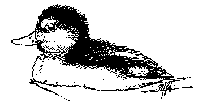
Females and young birds lack the lustre of the drakes. The female has plain, brownish-grey colouring that is darkest on its head, a white patch extending below and in front of each eye, and a prominent white ear patch. The belly is white with brown speckles. Young birds strongly resemble the adult females. They have the white spot between the bill and eyes, as well as the prominent round ear patch. However, the feathers on the upper body of the young are darker than those of adult females, and the belly is more finely barred, giving an overall greyer appearance. The young males achieve some adult features during their first winter, but do not grow full adult plumage until two or three years of age.
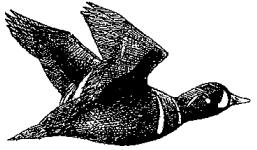
Seen from afar, Harlequin Ducks can be distinguished from other sea ducks by several features. They have slighter bodies and shorter bills than scoters, and they raise and lower their heads and nod while swimming. The birds are also normally found in smaller flocks and closer to shore than other sea ducks. Female and immature birds do not have the white wing patches found on Buffleheads and White-winged Scoters.
Signs and sounds
Harlequin Ducks are also known as "sea mice" and "squeakers" because of their mouse-like call.
-
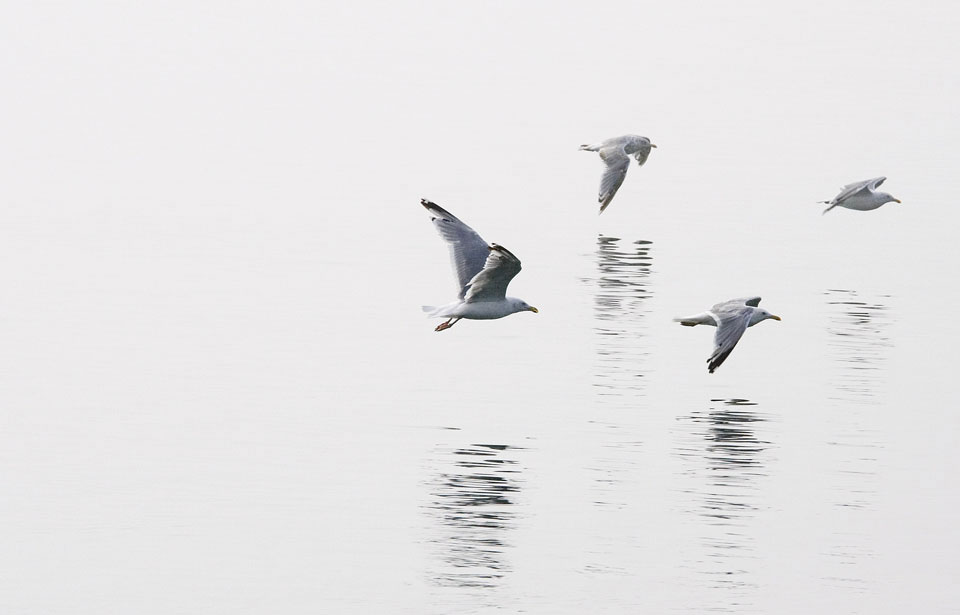 Allan McDonald
Herring Gull
Herring Gull Urban Wildlife (30 seconds) Urban Wildlife (60 seconds)
Allan McDonald
Herring Gull
Herring Gull Urban Wildlife (30 seconds) Urban Wildlife (60 seconds)
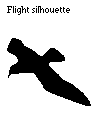 In Canada, most seagulls are Herring Gulls Larus argentatus. The adult Herring Gull is about 61 cm long from the tip of its bill to the tip of its tail. Its head, body, and tail are white, its bill is yellow with a red spot on the lower tip, and its legs are pink or flesh-coloured. The backs and upper wing surfaces of adult gulls are grey, and the tips of their outermost flight feathers are black with a white spot. In winter, the heads of adult gulls are streaked with brown. Immature birds are a mottled brown and take four years to develop full adult plumage.
In Canada, most seagulls are Herring Gulls Larus argentatus. The adult Herring Gull is about 61 cm long from the tip of its bill to the tip of its tail. Its head, body, and tail are white, its bill is yellow with a red spot on the lower tip, and its legs are pink or flesh-coloured. The backs and upper wing surfaces of adult gulls are grey, and the tips of their outermost flight feathers are black with a white spot. In winter, the heads of adult gulls are streaked with brown. Immature birds are a mottled brown and take four years to develop full adult plumage. Signs and sounds
Herring Gull communication has been studied for several decades. A gull states its intent to stand fast by giving the trumpeting “long call.” It threatens to peck a neighbour by drawing itself up to look bigger, lowering its bill tip ready to strike, and pulling its “wrists” out of its body feathers. Then it steps stiffly towards its opponent. -
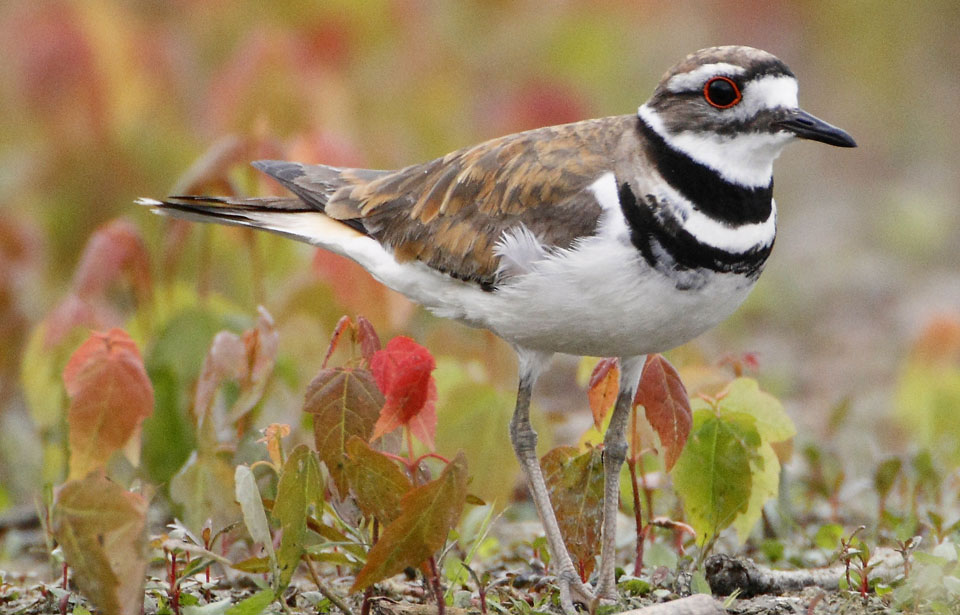 Ted Busby
Killdeer
Killdeer
Ted Busby
Killdeer
Killdeer
The Killdeer Charadrius vociferus is a member of the plover family. It is a strikingly handsome bird. From bill-tip to tail-tip it measures 23 to 28 cm, and it weighs up to 100 g. It is almost the same size as a robin, but its long legs make it appear larger. Two black bands across the white chest and an orange-coloured lower back, rump, and tail are its most distinctive markings. A white collar and white above the bill contrast with the brownish cap and the dark band below the eye and around the nape, or back, of the neck. The upper back and wings are brown, but large white wing stripes are visible when the bird flies. The plumage, which is worn by male and female alike, shows no perceptible differences in summer or winter.
Signs and sounds
This noisy and handsome bird gets both its Latin name and its common name from its call. The common name tells us what it says, and the second part of the Latin name describes its tone. The loud and almost hysterical sound of kill-dee or kill-deeah repeated frequently by both male and female is heard from early spring through summer from fields and open places. -
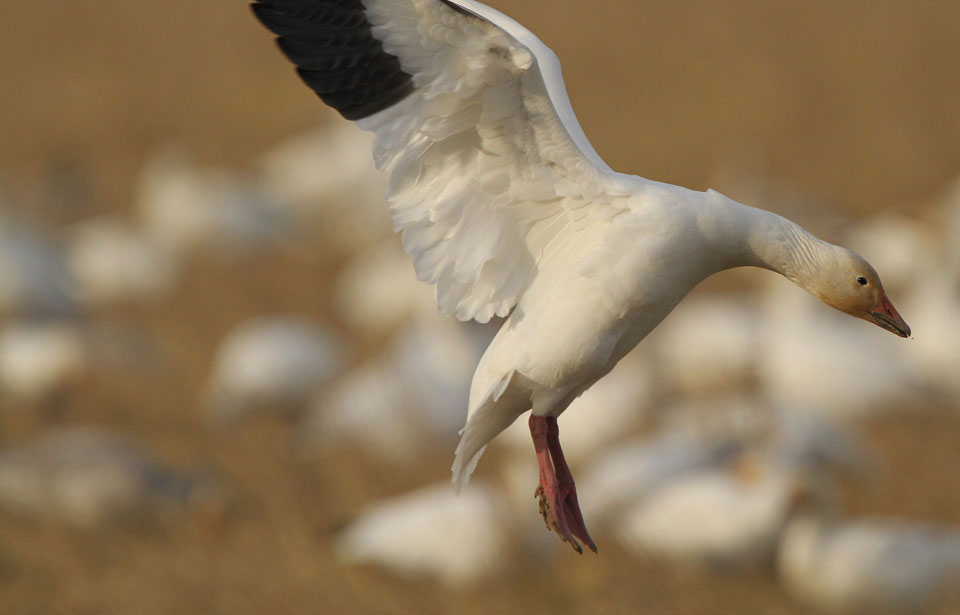 Lauren Nicholl
Lesser Snow Goose
Lauren Nicholl
Lesser Snow Goose
The Lesser Snow Goose Chen caerulescens caerulescens has two different appearances, white phase and blue phase. The plumage of white-phase geese is almost completely white, except for black wing tips. The blue-phase goose has a white head, a bluish colour on the feathers of the lower back and flanks, and a body that ranges in colour from very pale, almost white, to very dark. Both the white- and blue-phase snow geese frequently have rusty orange faces, because their feathers have been stained by iron in the earth where the birds feed.
The downy goslings of the white-phase geese are yellow, those of the blue phase nearly black. By two months of age the young birds of both colour phases are grey with black wing tips, although the immature blue-phase birds are generally a darker grey and have some light feathers on the chin and throat, which can become stained like those of the adults. The goslings have mostly lost their grey coloring by the following spring; in April and May they may only show a few flecks of darker coloring on their head and neck, and a few grey feathers on their wings that distinguish them from adults.
By the spring the black to dark grey bills of the immature birds have become grey-pink. The bill of the adult is pink and is narrower than the broad, black bill of the Canada Goose. It has evolved to enable the geese to eat the nutritious roots of marshland plants. The serrated black edge of the bill makes the bird appear to be smiling and is sometimes called the "grinning patch."
The Lesser Snow Goose has a wingspan of about 90 cm and its average weight is 2.2 to 2.7 kg, the male being larger.
There are two other types of white geese found in North America: the Greater Snow Goose Chen caerulescens atlantica, and Ross’ Goose Chen rossii. The Greater Snow Goose is slightly larger than the Lesser Snow Goose and nests farther north and east; blue-phase Greaters are rarely seen. The Ross’ Goose is much smaller than the Lesser Snow Goose and does not have a grinning patch on the side of the bill. Blue-phase Ross’ Geese are rare. As the numbers and ranges of both species have increased during the last 50 years, hybrids between them have become quite frequent. The hybrids are intermediate in size between Ross’ Geese and Lesser Snow Geese.
Signs and soundsThe Lesser Snow Goose makes a loud, resonant, nasal whouk or houck, which can sound like a high-pitched bark, often uttered in chorus.
-
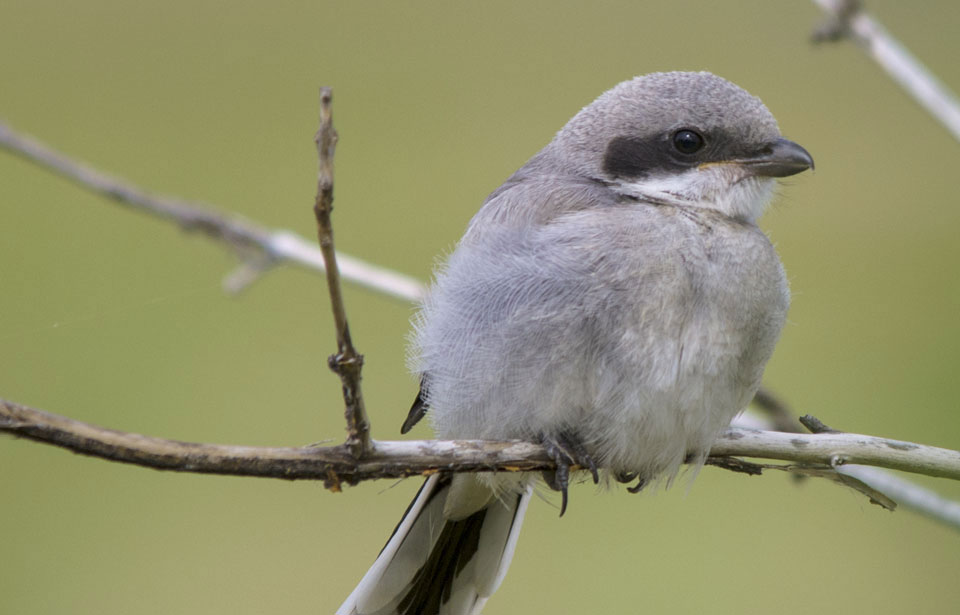 Daniel Arndt
Loggerhead Shrike
Daniel Arndt
Loggerhead Shrike
The Loggerhead Shrike Lanius ludovicianus is a robin-sized bird that hunts like a small hawk, preying on insects and small animals, including small birds. There are 11 subspecies of Loggerhead Shrike in North America, two of which are found in Canada: the Prairie Loggerhead Shrike Lanius ludovicianus excubitorides and the Eastern Loggerhead Shrike Lanius ludovicianus migrans.
All of the subspecies are quite similar. The back is grey, the wings are black and white, the chest and belly are white, and the tail is black with white strips along the sides. A notable field mark is the “mask,” a black stripe across the eyes and forehead. The birds have a heavy, hooked beak, and a somewhat large head for the size of the body, which likely is the source of their name—“loggerhead” means “blockhead.” Adult Loggerhead Shrikes measure about 21 cm and weigh about 47.5 g.
A close relative, the Northern Shrike, looks much like the Loggerhead Shrike, although there are several differences. Northern Shrikes, at 25 cm long, are bigger than Loggerhead Shrikes. The black face mask on the Northern Shrike does not usually extend across the forehead above the beak, as it does in the Loggerhead, and adult Northern Shrikes retain faint brownish barring on their underparts. While young Loggerhead Shrikes closely resemble adults during their first year, young Northern Shrikes do not: they have a brown coloration. Finally, the beak of the Northern Shrike is longer than that of the Loggerhead, measuring about half of the front-to-back length of the head.
Signs and sounds
During the spring courtship period, both male and female Loggerhead Shrikes make a range of noises. Their calls are an unmusical series of notes. Other sounds are a variety of shrieks, uttered when the birds are alarmed, or a repeated tink, like that made by tapping two pieces of metal together. -
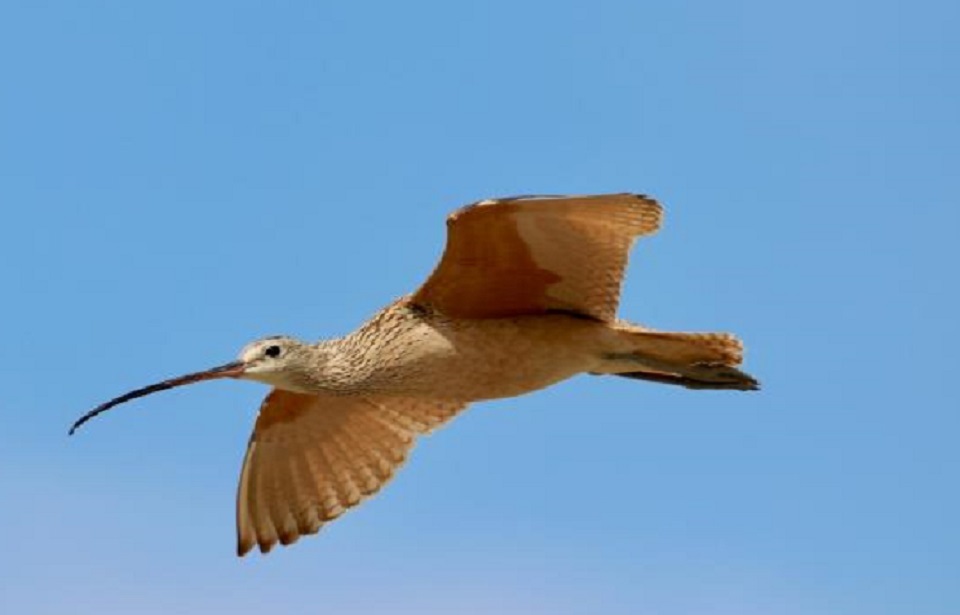 Ken Risi
Long-billed Curlew
Long-billed Curlew (Youth) Long-billed Curlew (15 seconds) Long-billed Curlew (30 secondes) Long-billed Curlew
Ken Risi
Long-billed Curlew
Long-billed Curlew (Youth) Long-billed Curlew (15 seconds) Long-billed Curlew (30 secondes) Long-billed Curlew
-
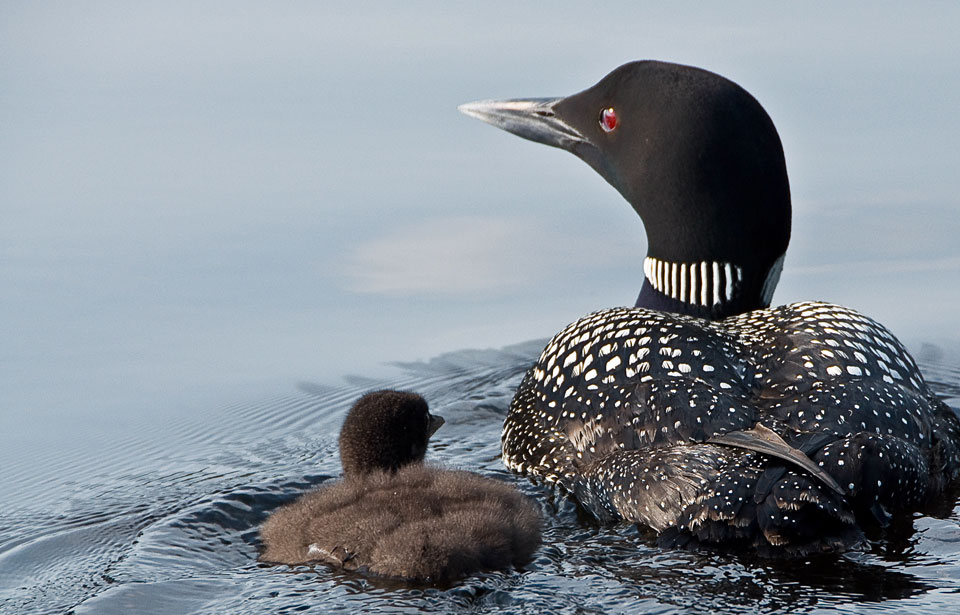 Rick McKenzie
Loons
Loon (Original) Common Loon (30 seconds) Common Loon (60 seconds)
Rick McKenzie
Loons
Loon (Original) Common Loon (30 seconds) Common Loon (60 seconds)
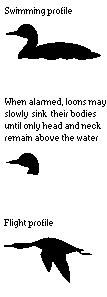 Loons are water birds like ducks, geese, and grebes, but they are classified separately by scientists. The five species are Red-throated Loon Gavia stellata, Pacific Loon Gavia pacifica, Arctic Loon Gavia arctica, Yellow-billed Loon Gavia adamsii, and Common Loon Gavia immer. The Common Loon is the species best known to most of us, as its breeding range lies across most of Canada.
Loons are water birds like ducks, geese, and grebes, but they are classified separately by scientists. The five species are Red-throated Loon Gavia stellata, Pacific Loon Gavia pacifica, Arctic Loon Gavia arctica, Yellow-billed Loon Gavia adamsii, and Common Loon Gavia immer. The Common Loon is the species best known to most of us, as its breeding range lies across most of Canada.The Common Loon in summer is very striking with its black-and-white checkered back, glossy black head, white belly and wing lining, and characteristic white necklace around the throat. All loons have greyish feathers in the winter, and immature birds tend to resemble adult birds in winter plumage. The white feathers of the belly and wing linings are present year-round.
Loons’ habit of swimming low in the water helps to distinguish them from other waterbirds, such as ducks and geese. Loons most resemble the grebes, but can be identified by their larger size, thicker necks, and longer bills. In flight, loons can be recognized by their humpbacked profile, with head and neck held low and feet pressed back towards the body and projecting beyond the tail.
Males and females look the same, although males are generally larger. Adults are large-bodied, weighing from 2.7 to over 6.3 kg and measuring almost a metre from bill tip to outstretched feet. The bill is quite large, averaging 75 mm in length, and is black in colour throughout the year.
The skeleton and muscular system are designed for swimming and diving. Loons are streamlined. Their legs are placed far back on their body, allowing for excellent movement in water but making them ungainly on land. The head can be held directly in line with the neck during diving to reduce drag, and the legs have powerful muscles for swimming. -
 Brigitte Charbonneau
Mallard
Mallard
Brigitte Charbonneau
Mallard
Mallard
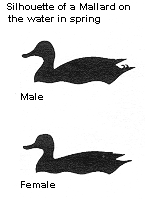 The handsome Mallard Anas platyrhynchos is the best known wild duck in the world. The male in breeding dress is unmistakable. The glossy head and upper neck are brilliant green, separated from the rich chestnut of the breast by a white collar. The rest of the underparts and the sides are light grey.
The handsome Mallard Anas platyrhynchos is the best known wild duck in the world. The male in breeding dress is unmistakable. The glossy head and upper neck are brilliant green, separated from the rich chestnut of the breast by a white collar. The rest of the underparts and the sides are light grey.
The back and wings of the bird are greyish brown, with a purplish-blue speculum, or wing patch, on the wing. The whitish tail has black above and below it. Two central black feathers that curve back above the tail give the breeding male its characteristic curly-tailed appearance. The male has a yellow bill and orange legs and feet.
The female Mallard is a much less colourful bird. Its back is mottled brown, its breast heavily streaked with buff and darker brown. It is best recognized by the white-bordered speculum on the wing, which is similar to that of the male. The female has an orange bill, sometimes blotched with black, and its legs and feet are orange.Signs and sounds
The female Mallard’s call is a loud quack-quack similar to that given by farmyard ducks. The call of the male is a softer, low-pitched rhab-rhab. -
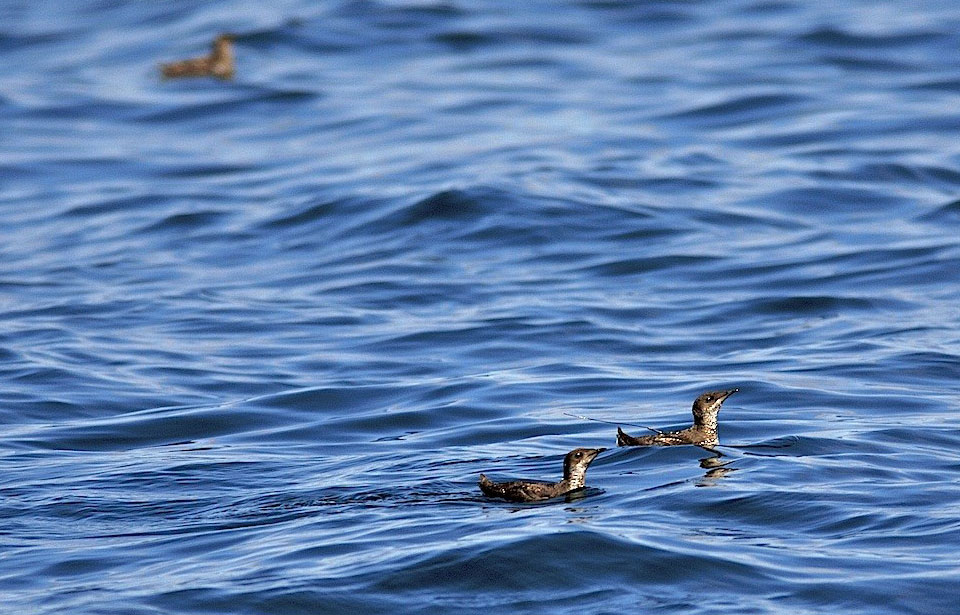 USFWS Aaron Barna
Marbled Murrelet
Ocean Commotion (webisode)
USFWS Aaron Barna
Marbled Murrelet
Ocean Commotion (webisode)
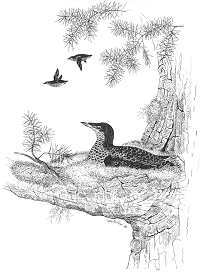
Visually, the Marbled Murrelet Brachyramphus marmoratus is completely unspectacular, with no fancy facial plumes or colourful bill ornaments. Like many other birds, this murrelet grows two sets of feathers each year, and, like some of those other birds, its summer and winter plumages are quite different. The summer plumage is "marbled" in shades of (mostly dark) brown. The winter feathering is black and white, similar to that of the more numerous Ancient Murrelet; however, white shoulder patches and a white throat distinguish the Marbled Murrelet.
Signs and sounds
Observers have noticed a lot of activity near nesting sites for an hour before and after sunrise. They have seen murrelets circling high up near the sites, uttering a characteristic keer-keer that sounds a little like the call of a gull. Occasionally, they make a peculiar "jet-plane" noise by allowing air to rush through their feathers. Others are completely silent, and only their silhouettes are visible against the lightening sky. -
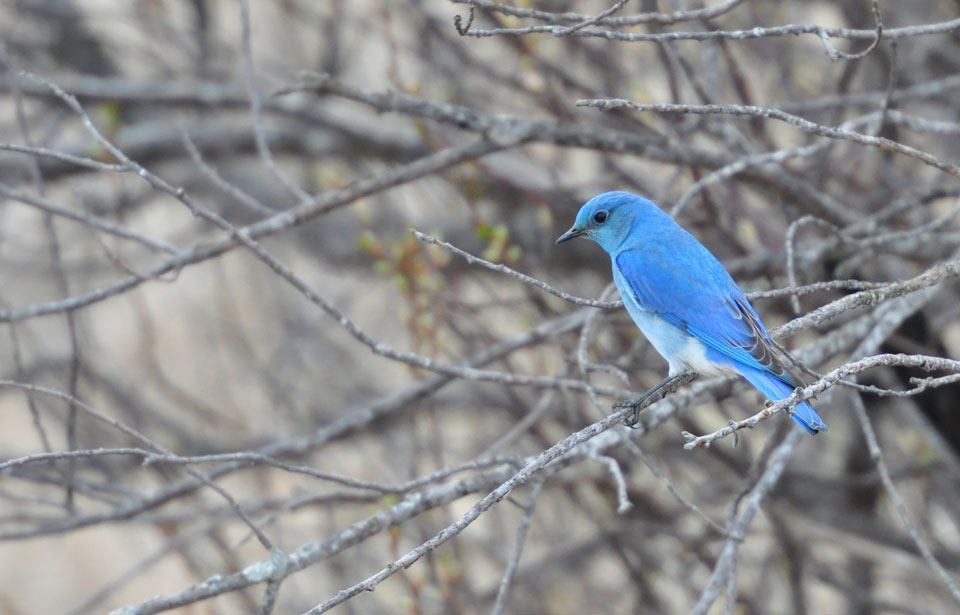 Diane Elaine Taylor
Mountain Bluebird
Diane Elaine Taylor
Mountain Bluebird
Three species of bluebird are found in North America: the Mountain Bluebird Sialia currucoides, the Eastern Bluebird Sialia sialis, and the Western Bluebird Sialia mexicana.
Bluebirds belong to the thrush family, whose members are found throughout much of the world. Another of North America’s well-loved birds, the American Robin, is also a thrush.
The Mountain Bluebird is a little larger than a House Sparrow but smaller than an American Robin. The back, wings, and tail of the male are a bright azure-blue, and the throat and breast are a lighter blue, which fades to white on the abdomen.
On the female, the flight feathers and tail are pale blue and the head and back are a mixed wash of blue and grey. The throat is brownish-ash, blending to white on the lower breast. Immature birds resemble females, except for the mottled breast characteristic of all juvenile members of the thrush family.
Signs and sounds
After working the fence line for some time, the Mountain Bluebird may disappear over the next ridge or clump of trees, leaving behind a soft warbling song. It has a louder song, which is heard most often in pre-dawn hours, during the breeding season. -
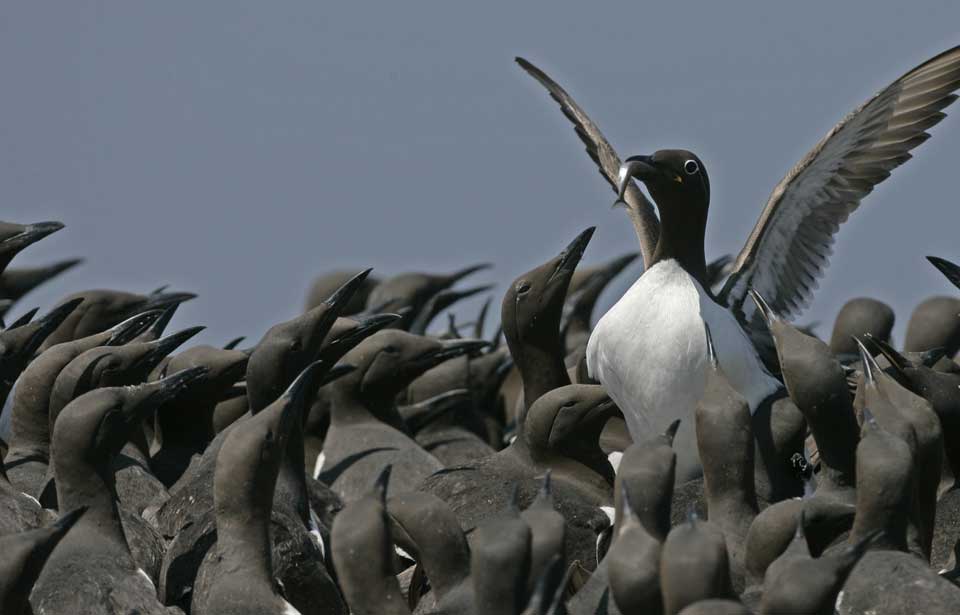 Thinkstock
Murres
Ocean Commotion (webisode)
Thinkstock
Murres
Ocean Commotion (webisode)
There are two species of murre: the Common Murre Uria aalge and the Thick-billed Murre Uria lomvia. They and their close relatives—razorbills, dovekies, guillemots, and puffins—are members of a group of black and white, penguin-shaped seabirds called auks.
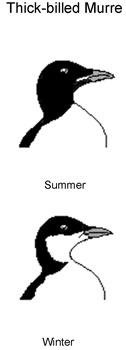
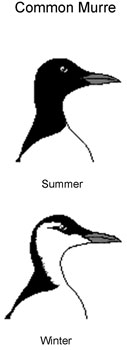
The two species look much alike. In summer they are black on the back, neck, and upper breast and glossy white below—they look as if they are wearing elegant dinner jackets. In winter, the throat, cheeks, and upper breast turn white. In summer, the Common Murre’s chocolate-coloured back is lighter than the Thick-billed Murre’s darker and shinier feathers; in winter, the Common Murre shows a white streak behind the eye.
Both species have sharp, dagger-like bills that are somewhat flattened from side to side; however, as the name suggests, the Thick-billed Murre’s beak is shorter and stouter than the Common Murre’s. The beak is black, and in summer the two species can be told apart by the distinct white line along the cutting edge of the top half of the Thick-billed Murre’s beak.Adult murres weigh about 1 kg and are about 30 cm tall.
Signs and sounds
Murre colonies are very noisy places, as neighbouring birds quarrel in deep, growling guttural aargh calls, and mates greet each other in rattling crescendos. Adults keep track of their own chicks on crowded ledges by recognizing their peeping calls, which the chicks first make from within the shell just before hatching. Their calls become more strident wee-wee notes as the chicks prepare to leave the colony, and chicks and adults keep in touch by calling to each other at sea as they depart on their swimming migration. -
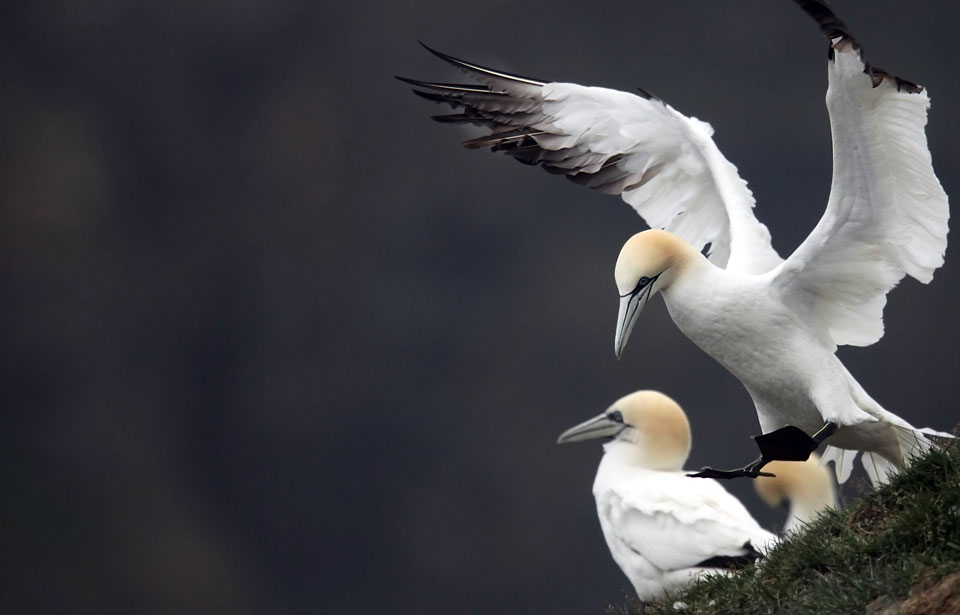 Megan Lorenz
Northern Gannet
Northern Gannet Ocean Commotion (webisode)
Megan Lorenz
Northern Gannet
Northern Gannet Ocean Commotion (webisode)
The Northern Gannet is one of three subspecies of Gannet Morus bassanus in the world: the other two occur along the south coast of Africa and in Tasmania and New Zealand.
Adult gannets have dazzling white plumage except for narrow grey spectacles and jet black, tapering wingtips. During the breeding season, the head and neck assume a delicate saffron yellow tinge. The eyes are an icy blue, and the bill is blue to grey-blue.
Young gannets in autumn plumage are brown, with many white flecks. With the passing of each season, they become progressively whiter, reaching the complete adult plumage in their fourth or fifth year. -
 Luc Farrell
Osprey
Luc Farrell
Osprey
The Osprey Pandion haliaetus is a large, powerful raptor, or bird of prey.
Adult birds have a dark brown back and white forehead, cheeks, neck, breast, and belly. A dark stripe extends from the base of the beak and across the eye to the back. The head and upper part of the breast are streaked brown, as is the underside of the wings and tail. In North America, the breast stripes are heavier on the female than on the male. The juveniles and adults look much alike; however, on the juveniles the brown feathers on the upper parts are tipped with white and the breast and head are more heavily striped. Ospreys acquire their adult plumage at about 18 months.
As is the case with most raptors, the female is larger than the male. She weighs on average 1.6 kg, compared with 1.4 kg for the male, and has an average wingspan of 163 cm, compared with 159 cm for the male. The adult Osprey measures anywhere from 53 to 65 cm long.
Anatomically, the Osprey resembles the eagle, but its narrow wings, when outspread, are markedly angled, and the structure of its feet and claws is so peculiar that it has been placed in a separate subfamily, the Pandioninae, of which it is the sole representative.
Unlike other raptors, the Osprey has four equal toes. The outer one is reversible, enabling the bird to seize its prey with two toes pointing forwards and two pointing backwards. A long, sharp, curved claw on each toe, and short, rigid spikes, known as spicules, on the sole of each foot, give the bird a firm grip on its slippery prey, which nearly always consists of fish that the bird catches alive, hence its nickname of fishing eagle or fish hawk.
Signs and sounds
For its size, the Osprey has a small voice, but if it is displaying or is feeling threatened, its cry will carry a fair distance. Usually, it gives out a whistling chook, chook, chook sound. The cry of the male, when frightened near the nest, is a shrill and frantic cheric, cheric, whereas the females give out a rapid pew, pew, pew sound. -
 Megan Lorenz
Peregrine Falcon
Peregrine Falcon Species at Risk in Canada (30 seconds) Species at Risk in Canada (60 seconds)
Megan Lorenz
Peregrine Falcon
Peregrine Falcon Species at Risk in Canada (30 seconds) Species at Risk in Canada (60 seconds)
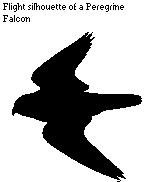 The Peregrine Falcon Falco peregrinus is a sturdy crow-sized falcon. Adult females are larger than males, measuring 45 to 59 cm and weighing about 910 g, compared with the males’ length of 36 to 49 cm and weight of about 570 g. The Peregrine’s most reliable distinguishing features are the blackish malar, or cheek, stripe below the eye and the dark bluish-grey or slate-coloured crown, back, and upper surface of the wings. The throat is white and the underparts are white to buff, with blackish brown bars on the sides, thighs, abdomen, underwings, and lower breast area. Young Peregrines have upperparts whose colour varies from pale to slate or chocolate brown and underparts that are buffy with blackish streaks.
The Peregrine Falcon Falco peregrinus is a sturdy crow-sized falcon. Adult females are larger than males, measuring 45 to 59 cm and weighing about 910 g, compared with the males’ length of 36 to 49 cm and weight of about 570 g. The Peregrine’s most reliable distinguishing features are the blackish malar, or cheek, stripe below the eye and the dark bluish-grey or slate-coloured crown, back, and upper surface of the wings. The throat is white and the underparts are white to buff, with blackish brown bars on the sides, thighs, abdomen, underwings, and lower breast area. Young Peregrines have upperparts whose colour varies from pale to slate or chocolate brown and underparts that are buffy with blackish streaks.Generally smaller and more streamlined than hawks, Peregrines, like all falcons, have small heads, firm compact plumage, and long pointed wings—adaptations that allow them to fly at great speed. In flight they use quick, powerful wing strokes. Their powerful talons and strong hooked beak, equipped with a notch or “tooth” that aids in severing the spinal cord of avian prey, mark them as highly specialized predators.
Some Peregrines have lived 18 to 20 years, but the average life span is much shorter.
Traditionally, the female has been known as the “falcon” and the male as the “tercel.”
Signs and sounds
Peregrines become excited and sometimes aggressive when humans approach their nests, particularly if young are present. Aggressive birds may dive within a metre of intruders or even strike them, screaming a high-pitched cack-cack-cack. Because the calls often intensify the nearer someone gets to the nest, the Peregrine may unknowingly aid rather than intimidate the nest seeker. Although similar, the voices of the two sexes can be distinguished: the male’s is more wheezy and high-pitched, while the female’s is grating and more coarse.
-
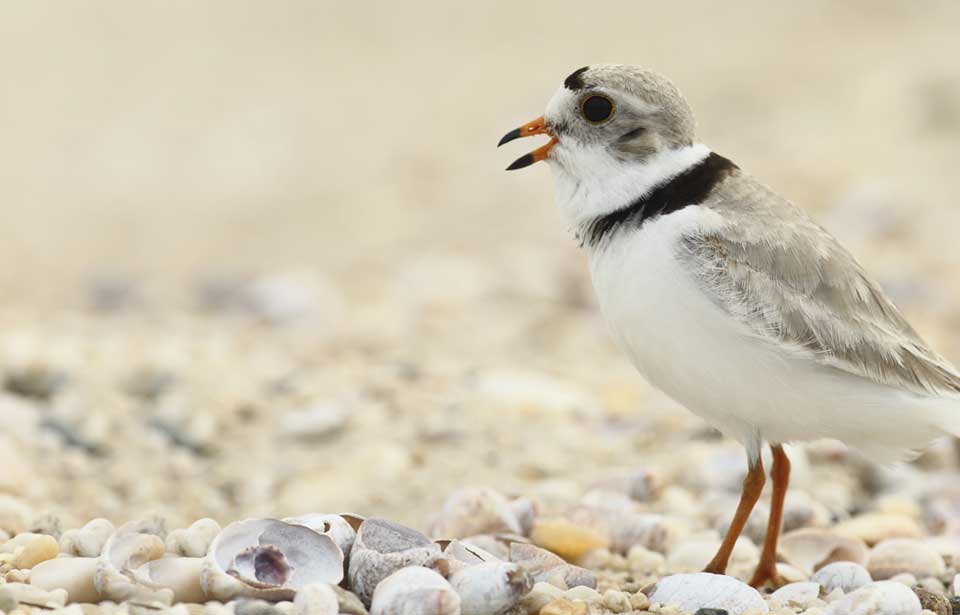 Thinkstock
Piping Plover
Piping Plover
Thinkstock
Piping Plover
Piping Plover
The Piping Plover Charadrius melodus is a small bird of lakeshores, river sandbars, and ocean coasts. With its head and back the colour of dried sand, the Piping Plover blends well into its beach surroundings, helping it hide from predators. It has a white rump, a partially black tail, a black band above its white forehead, and a single black “belt” or breastband (also referred to as a collar or neckband), which is sometimes incomplete, that contrasts with its white breast and abdomen. Its bright orange legs match its orange, black-tipped bill. Adults weigh from 43 to 64 g and are about the size of a bluebird.
Males and females are similar in appearance, although the males tend to have broader and more distinct black bands on the head and breast and a brighter orange bill. The adult winter plumage, which looks like the juvenile plumage, lacks the black head and breast bands. On the wintering grounds, orange legs distinguish the Piping Plover from other plover species.
The Piping Plover is the rarest of six “belted” plover species found in North America. The single band, or “belt,” of the Piping Plover tends to be more incomplete in coastal birds and complete in interior birds. The Piping Plover is often confused with the Semipalmated Plover Charadrius semipalmatus, which is similar in size to the Piping Plover but has a darker body, the colour of wet sand, lacks a white rump patch, and has more pronounced black bands on the forehead, cheek area, and neck. Taxonomically, the Piping Plover is split into two subspecies. The circumcinctus subspecies occurs in the Northern Great Plains and Great Lakes regions. The melodus subspecies is restricted to the Atlantic coast.
Signs and sounds
The Piping Plover’s call is a plaintive cry, sometimes described as a whistled peep-lo, with the first syllable higher. The male calls vigorously during its courtship flights and when preparing nest scrapes.
-
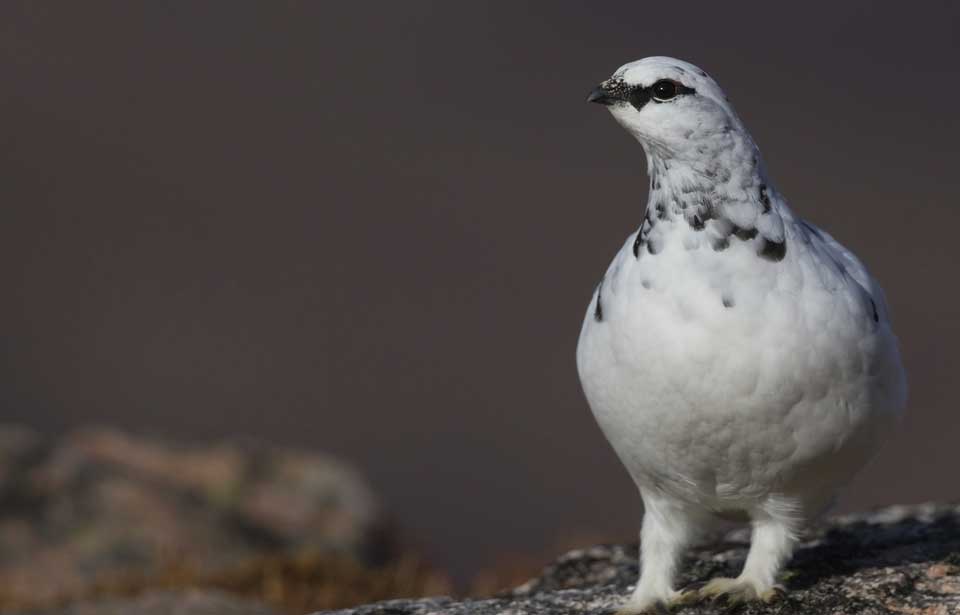 Thinkstock
Ptarmigan
Ptarmigan
Thinkstock
Ptarmigan
Ptarmigan
 Ptarmigans are hardy members of the grouse family that spend most of their lives on the ground at or above the treeline. Three species are present in North America: the Willow Ptarmigan Lagopus lagopus, the White-tailed Ptarmigan Lagopus leucurus, and the Rock Ptarmigan Lagopus mutus.
Ptarmigans are hardy members of the grouse family that spend most of their lives on the ground at or above the treeline. Three species are present in North America: the Willow Ptarmigan Lagopus lagopus, the White-tailed Ptarmigan Lagopus leucurus, and the Rock Ptarmigan Lagopus mutus.
Like other grouse, ptarmigans have chunky bodies, short tails and legs, and short, rounded wings. Willow Ptarmigans weigh from 450 to 800 g, White-tailed Ptarmigans weigh about 350 g, and Rock Ptarmigans are intermediate in size.
All ptarmigans have feathered feet, unique among chickenlike birds, which improve their ability to walk in snow. They also have white wings throughout the year. Inflatable red combs above their eyes, which are especially evident in territorial and courting males, are inconspicuous to barely visible in females.
Ptarmigans have three seasonal plumages per year, instead of the two that are usual for most birds. These plumages keep the birds, particularly the female, well camouflaged at all times. In winter, all ptarmigans of both sexes are basically white. Whereas White-tailed Ptarmigans have permanently white tail feathers, the tails of Willow and Rock Ptarmigans remain black throughout the year. In winter, male—and some female—Rock Ptarmigans sport a black stripe that extends through the eye to the bill (as if they had put on charcoal goggles to prevent snow blindness), distinguishing them from male Willow Ptarmigans.
In ptarmigans, the moult, or shedding of old feathers, starts with the head and progresses towards the tail. As soon as the spring snowmelt begins, females moult into a barred breeding plumage of brown, gold, and black. Female ptarmigans are difficult to tell apart in spring, but the overall tones of the White-tailed Ptarmigan females are cooler in comparison to those of the other two species. Breeding males delay their moult. -
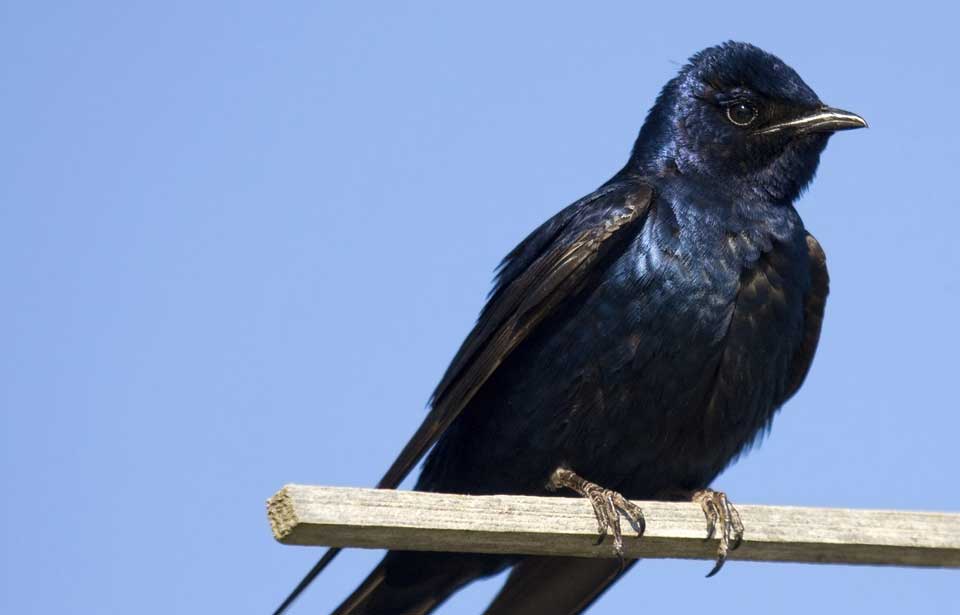 Thinkstock
Purple Martin
Thinkstock
Purple Martin
The Purple Martin Progne subis is a conspicuous bird in many populated areas of North America during spring and summer. Averaging 17 to 20 cm in length, it is Canada’s largest swallow. The Purple Martin resembles other swallows in having a slender body, long wings, and a wide beak. The tail is forked but not deeply as in some other swallows. Male martins, with their dark plumage, often appear to be black, but on bright sunny days their shiny blue-black coloration is clearly visible. Female martins are lighter in colour, with a pale grey throat and belly.
By the time they have left the nest, young martins of both sexes resemble adult females. Young males only become dark at their second breeding season.
Signs and sounds
The call of the martin is a series of loud, distinctive, gurgling notes. In flight, martins alternate short glides with rapid flapping. Like other swallows, they are superb fliers, changing direction often as they pursue flying insects. -
 Jacques Pelletier
Red-breasted Nuthatch
Red-Breasted Nuthatch (30 seconds) Red-Breasted Nuthatch (60 seconds)
Jacques Pelletier
Red-breasted Nuthatch
Red-Breasted Nuthatch (30 seconds) Red-Breasted Nuthatch (60 seconds)
Like all nuthatches the Red-breasted Nuthatch Sitta canadensis has short legs, a flat body, and a large head. Its strong, rather long bill is slightly upturned. The Red-breasted Nuthatch can be distinguished from other nuthatches by a pronounced white eyebrow stripe set off by a black line through the eye, and black on top of the head and neck. The crown is black in the male and dark greyish-blue in the female. The back, wings, and tail are mostly greyish-blue in both male and female. The rusty-coloured underparts that give this species its name are paler in the female. The long and pointed wings when folded extend nearly to the tip of the short tail. The bird’s overall length is about 11 cm.
All of the 17 species of true nuthatches of North America and Eurasia belong to the genus Sitta; these comprise the common nuthatch family or Sittidae. None is more than 19 cm long. Whether in Formosa, Germany, or Mexico, all nuthatches share many characteristics with the Red-breasted Nuthatch. Several Eurasian species, however, differ primarily in that they live on cliffs, foraging on rocks rather than on trees—hence the Rock Nuthatch Sitta neumayer.
Signs and sounds
Red-breasted Nuthatches, scrambling and fluttering about among the cones and needle-tufts at the ends of branches, constantly utter a series of weak nasal notes, more highly pitched and rapidly uttered than those of the White-breasted Nuthatch. Author W. M. Tyler notes that "when a little company is feeding together they keep up a cheery chatter among themselves. We find them at their best when gathered in the northern forests at the close of summer. Then they give their high, tinwhistle note, kng, back and forth on all sorts of pitches, varying its inflection, ringing unheard of changes on this simple call and when they are together thus, they use also a squealing note—a very high, nasal, little piglike or mouselike squeal—and a short explosive kick, or a rapid series of kicks." Also among the Red-breasted Nuthatch’s variety of surprisingly expressive sounds is a territorial song, a prolonged series of monotonous nasal notes: yna-yna-yna or yaaaaa. -
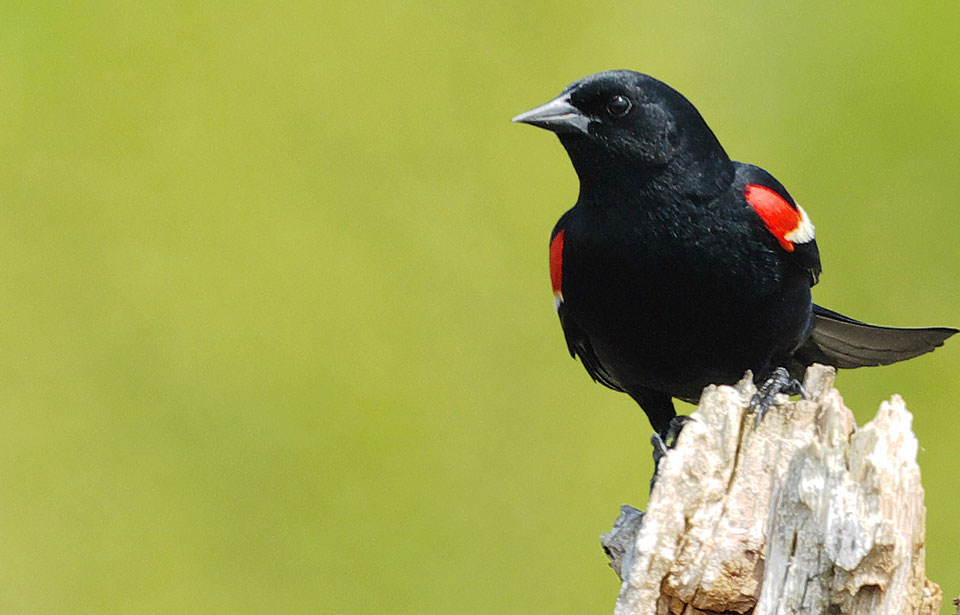 Jacques C. Pelletier
Red-winged blackbird
Jacques C. Pelletier
Red-winged blackbird
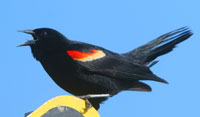
Red-winged blackbird calling.
Male red-winged blackbirds are black with distinctive red epaulets on their shoulders. Sometimes the red is concealed with only a yellow margin showing. Immature males also have red shoulder patches but can be sooty-brown and appear mottled.
Red-winged blackbirds are medium-sized song birds with a length of approximately 17 to 23 centimetres and weigh 32 to 77 grams. Females are somewhat smaller than males.
Females, very different in appearance from adult males, are brownish and have streaked breasts. Females are often mistaken for other blackbirds or large sparrows.
Signs and Sounds
Red-winged blackbird calls sound like loud check and a high slurred tee-err sound when alarmed. Their song is a liquid gurgling konk-ke-ree...
-
 John Williams
Redhead
John Williams
Redhead
The Redhead Aythya americana is a well-known and widely distributed North American diving duck. The adult male is a large, grey-backed, white-breasted duck with a reddish-chestnut head and black neck and chest. It resembles the larger male Canvasback. At close range, the head appears puffy, with an abrupt forehead and a short, broad bill, while the Canvasback’s bill is longer and slopes down from the forehead. The adult female is a large, brown-backed, white-breasted duck with a brown head, whitish chin, abrupt forehead, short, broad bill, and pearl-grey wing patches. Female Redheads, although larger, may be confused with female Ring-necked Ducks and scaups.
In autumn young Redheads resemble adult females, although their breast plumage is dull grey-brown, rather than white. During November and December, the young begin to develop the adult plumage, which has almost completely grown in by February.
The genus Aythya, to which the Redhead belongs, includes 12 species, all of which are well adapted to diving. The body is rounded and thick with large feet, legs set back on the body, and a broad bill. Body shapes vary from the big, long-necked, long-billed Canvasback to the short-billed scaup. The genus is represented in North America by the Canvasback, Redhead, Greater Scaup, Lesser Scaup, and Ring-necked Duck. -
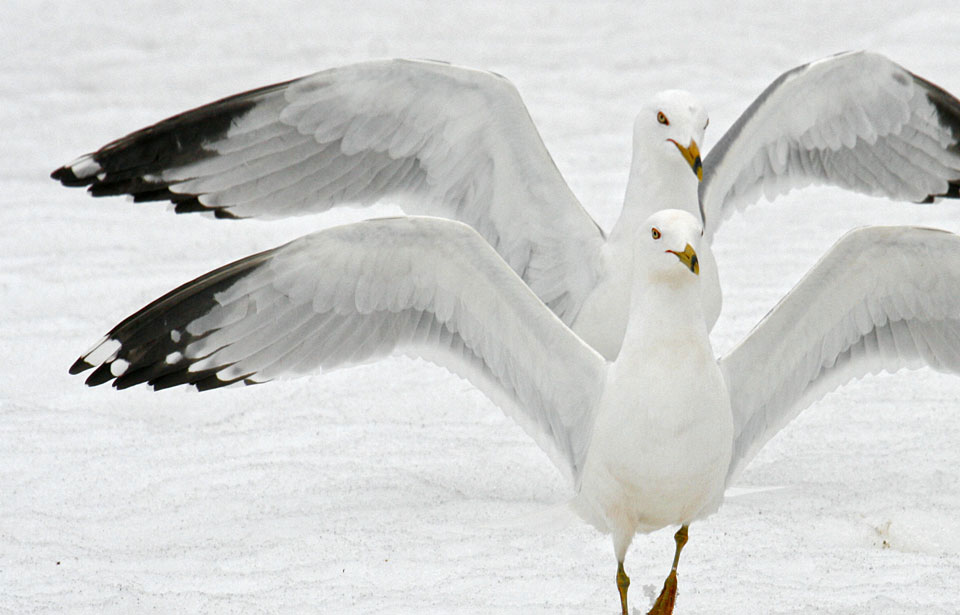 Mary Hindle
Ring-billed Gull
Ocean Commotion (webisode)
Mary Hindle
Ring-billed Gull
Ocean Commotion (webisode)
The adult Ring-billed Gull Larus delawarensis is a medium-sized gull, measuring 45 cm from bill to tail, having a 50-cm wingspan and weighing about 0.7 kg. Its white head, neck, underside and tail contrast with its grey wings (or back when the bird is at rest). The wing-tips are black with white spots and the legs and feet are yellow-green. A black ring encircles its yellow bill near the tip.
In appearance the adult Ring-billed Gull is similar to the Herring Gull, but the Herring Gull is bigger and has flesh-coloured legs and feet and a red dot on the lower part of the bill rather than a black ring.
Young Ring-billed Gulls are a mottled brown, much different in colouring from the adults. With each successive moult, or shedding of old feathers, they lose more of the brown and develop more of the white, grey, and black patterning. They attain full adult plumage when they are three years old.Signs and sounds
The Ring-billed Gull’s notes are higher pitched than those of the Herring Gull. Vocalizations are a loud hiyak . . . hiyah . . . hiyah-hiyak or yuk-yuk-yuk-yuk-yuckle-yuckle. It also makes mewing squeals. Its anxiety note is gah-gah-gah. -
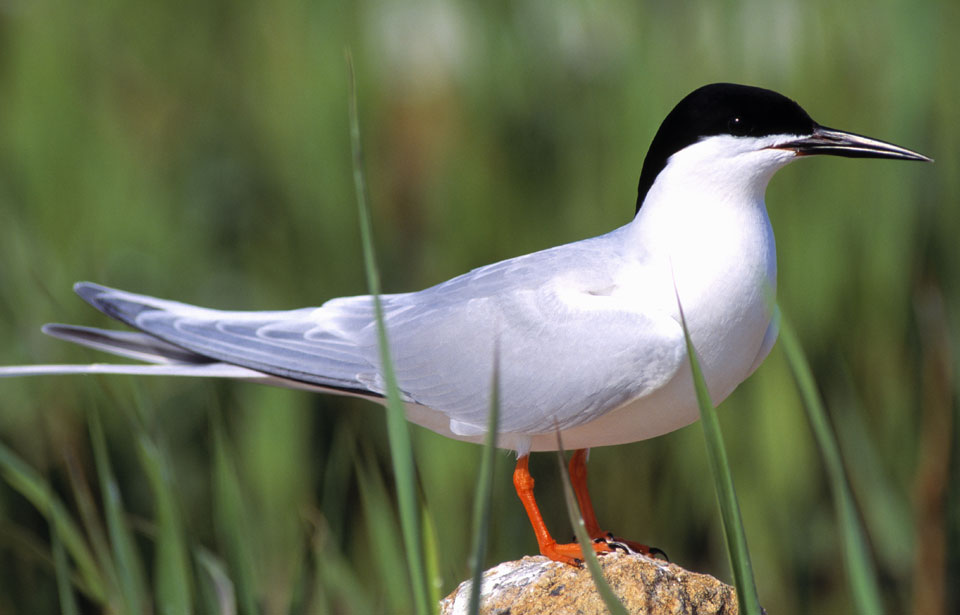 Thinkstock
Roseate Tern
Roseate Tern Ocean Commotion (webisode) Species at Risk in Canada (30 seconds) Species at Risk in Canada (60 seconds)
Thinkstock
Roseate Tern
Roseate Tern Ocean Commotion (webisode) Species at Risk in Canada (30 seconds) Species at Risk in Canada (60 seconds)
The Roseate Tern Sterna dougallii is a seabird that resembles a small gull, but it has the typically slender body, short legs, and long, pointed wings of all terns. It is closely related to the Common Tern Sterna hirundo and the Arctic Tern Sterna paradisaeaand is frequently found in their company. For these reasons, the Roseate Tern is not easy to identify (see drawings). It is a paler grey than Arctic and Common terns, and its tail streamers are considerably longer.
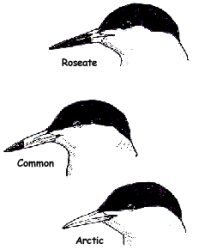
The adult Roseate Tern is 33 to 34 cm in length and has a wingspan of 72 to 80 cm. At a weight of approximately 100 to 120 g, an adult is slightly smaller than a Mourning Dove. It has a black forehead and nape, and its upper wing is a pale grey. Its tail is white with deeply forked outer feathers that give the impression of long streamers when the bird is in flight. The underside of the tern is white, tinged with pink early in the breeding season; however, this pale rosy tint is not a good field mark, or identification characteristic, because it varies from bird to bird, and the colour tends to be bleached out by the sun. The legs and feet are reddish, and the bill is mostly black, although bills of breeding birds may be red at the base. Male and female birds look alike. The head of the nonbreeding adult is mottled black and white.
The juvenile Roseate Tern has a mottled greyish back and rump and dark bill and legs. Chicks are unevenly covered with down, giving them a spiky appearance; their legs are dark purplish to black.
Signs and sounds
All terns have a harsh cry, but the Roseate Tern has a distinctive, two-syllable call — kir-rick. This is often the best way of confirming its presence at a colony. -
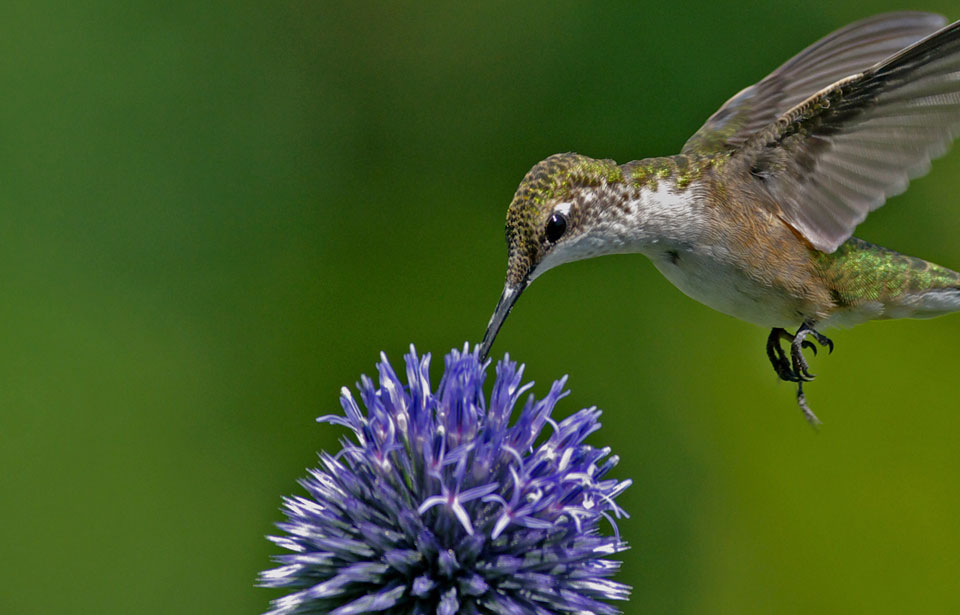 Jacques C. Pelletier
Ruby-throated Hummingbird
Jacques C. Pelletier
Ruby-throated Hummingbird
The Ruby-throated Hummingbird Archilochus colubris is the most common and widely distributed of the hummingbirds in Canada. From the tip of its bill to the tip of its tail it measures from 7.5 cm to slightly more than 9 cm. No larger than a good-sized insect, it is often confused with hawk moths, especially at dusk, as these moths are similar in size, form, and flight.
The male Ruby-throated Hummingbird is shiny metallic green above, greyish white below, and has a forked tail. He wears a splendid gorget, or throat patch, of silky, ruby red feathers, which sometimes appear orange, or even jet black, depending on the light. The female is similar but has a greyish-white throat patch. Her tail is rounded, and some of the outer tail feathers are marked with white spots. These she often displays when posturing and in flight. The Ruby-throated Hummingbird’s bill is long, straight, and almost as slender as a darning needle.
Signs and sounds
The hummingbird’s rapid wing motion produces a distinct hum—hence the bird’s name—which rises and falls according to the wing speed. At great accelerations the hum sometimes turns into a continuous high note, similar to that produced by arrows or bullets in flight. -
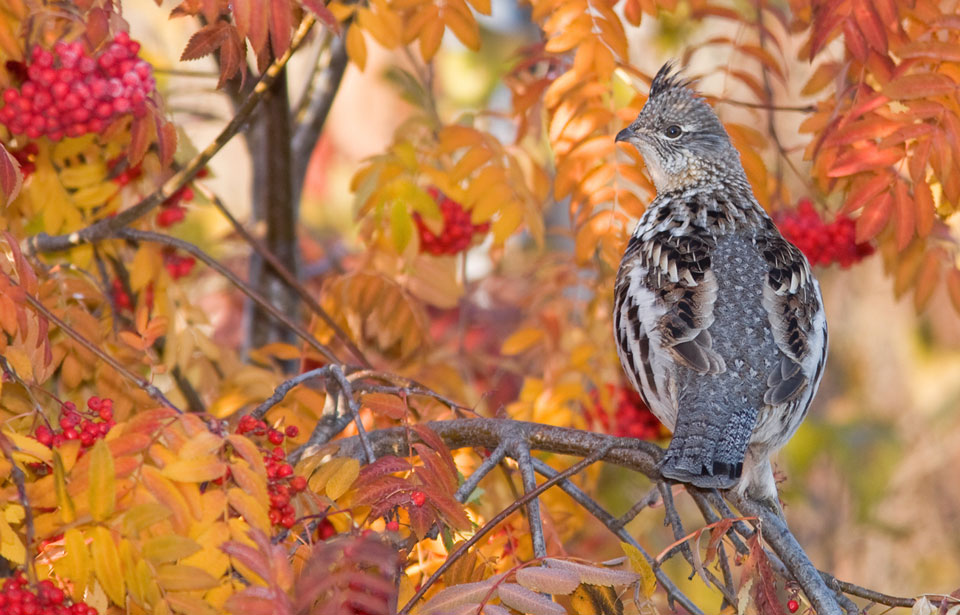 Dave Hughes
Ruffed Grouse
Ruffed Grouse
Dave Hughes
Ruffed Grouse
Ruffed Grouse
The scientific name for the Ruffed Grouse is Bonasa umbellus. Both terms are from the Latin: Bonasa means good when roasted and umbellus, a sunshade. This refers to the ruff or dark-coloured neck feathers that are particularly large in the male. When he is in display before the female, these are erected and surround his head almost like an umbrella. By nodding his head and ruffs, and spreading his tail and strutting, the male identifies himself to the female and encourages her advances.
The male Ruffed Grouse is about the size of a bantam chicken and weighs about 500 g. The females are smaller. Unlike the chicken, the grouse has a broad flat tail that is usually held down but that may be erected and spread into a half circle.
The dappled and barred plumage ranges in colour from pale grey through sombre red to rich mahogany. In the east, most grouse are predominantly grey, although some are red. Greys are in the majority in the central parts of the continent, and on the west coast most grouse are reddish brown.
The colours worn by the grouse are related to their habitat: the dark-coloured grouse inhabit dark forest, as on the coast; grey grouse live in lighter bush. This camouflage helps protect the grouse from their predators.
Males are hard to tell from females at a distance, but they are larger with larger ruffs and a longer tail. In the male the broad band of dark colour in the tail is usually unbroken.
The Ruffed Grouse is frequently called the “partridge.” This leads to confusion with the Gray, or Hungarian, Partridge, which was introduced to Canada from Europe. The Ruffed Grouse is only distantly related to the Gray Partridge, which is a bird of open areas, not woodlands. -
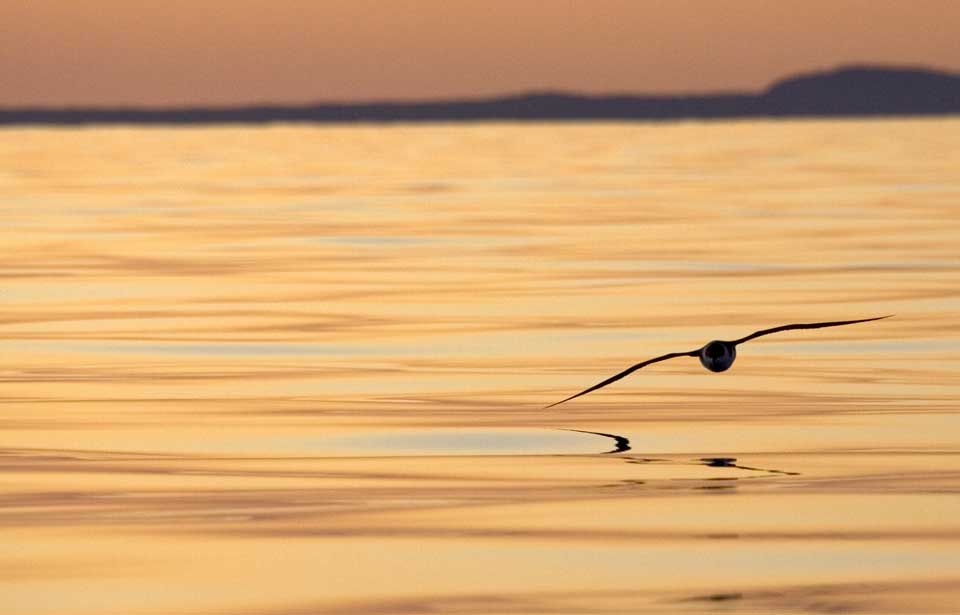 Seabirds
Ocean Commotion (webisode)
Seabirds
Ocean Commotion (webisode)
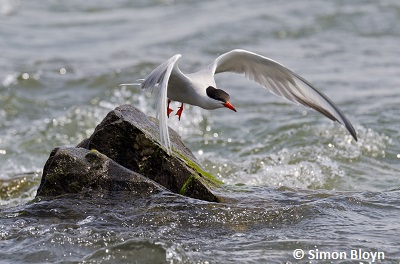
Common Tern
Everyone who has visited the coast is familiar with gulls, those graceful, long-winged birds that throng the beaches and harbours and boldly beg for scraps. The gulls are a family of birds that live mainly at sea, either along the shore, or out in the ocean itself. Worldwide, there are more than 350 species of birds that live either partially or exclusively at sea, and these are generally known as "seabirds.”
The table below lists the 14 families of marine birds and the approximate number of species in each (the exact number of species is continually being revised as genetic research reveals that some very similar-looking birds are so different in their genetic makeup that they constitute different species). All species belonging to the albatross, auk, frigatebird, gannet, penguin, petrel, and storm-petrel families feed exclusively at sea. In addition, many species of cormorants, grebes, gulls, jaegers, loons, pelicans and terns feed either entirely or mainly at sea. The Phalaropes are the only shorebirds that feed at sea.
Families of birds in which all species feed either entirely of partially at sea and the approximate number of species in each family appear below (from https://www.worldbirdnames.org/ioc-lists/master-list/). The number of species that breed in Canada are shown in parentheses. Ducks and grebes that feed at sea are not included.
-
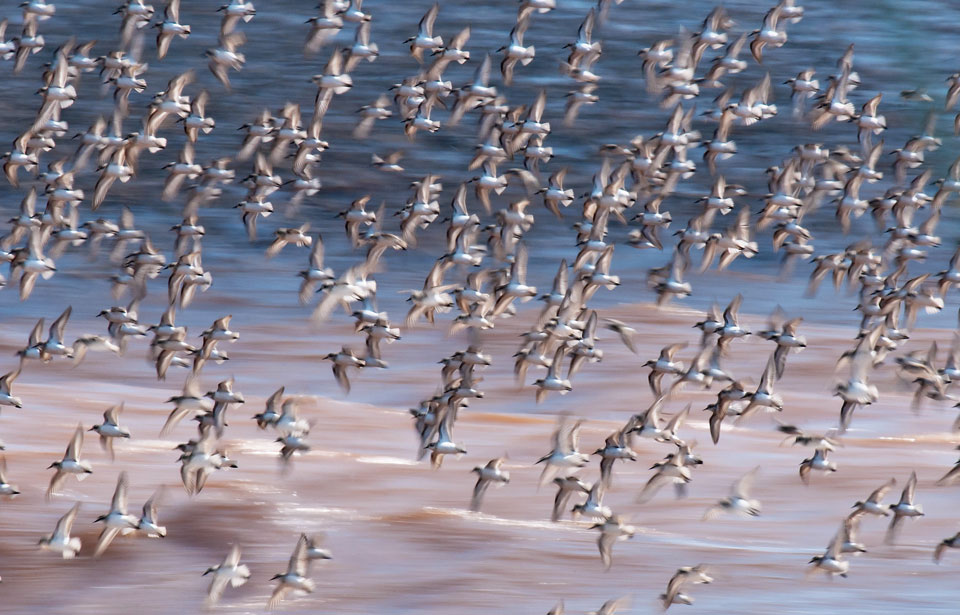 Guy L. Brun
Semipalmated Sandpiper
Guy L. Brun
Semipalmated Sandpiper
 The Semipalmated Sandpiper Calidris pusilla, only about 30 g in weight and 14 cm long, is one of Canada’s smallest shorebirds. Its name comes from the partial webs between its toes. Males and females are identical in rather plain brown or grey plumage although females are slightly larger. The species can be difficult to distinguish from other small sandpipers.
The Semipalmated Sandpiper Calidris pusilla, only about 30 g in weight and 14 cm long, is one of Canada’s smallest shorebirds. Its name comes from the partial webs between its toes. Males and females are identical in rather plain brown or grey plumage although females are slightly larger. The species can be difficult to distinguish from other small sandpipers.
Semipalmated Sandpipers moult, or shed, their body feathers twice a year. The change to the greyish-brown fall-winter plumage usually starts on the breeding grounds and is completed after arrival on the non-breeding area. The moult that takes place on the non-breeding area prior to spring migration gives them a slightly brighter (more brown) breeding plumage. Adults moult their flight feathers (wings and tail) gradually—retaining the ability to fly at all times—and only once per year, usually in the non-breeding area.
Some juveniles do not replace any flight feathers in their first winter, as these are quite new. Others, however, moult some of the outermost primaries (outer wing feathers), which are important for flight and wear most rapidly.
Signs and sounds
The Semipalmated Sandpiper’s voice is a single note chit or cheh. -
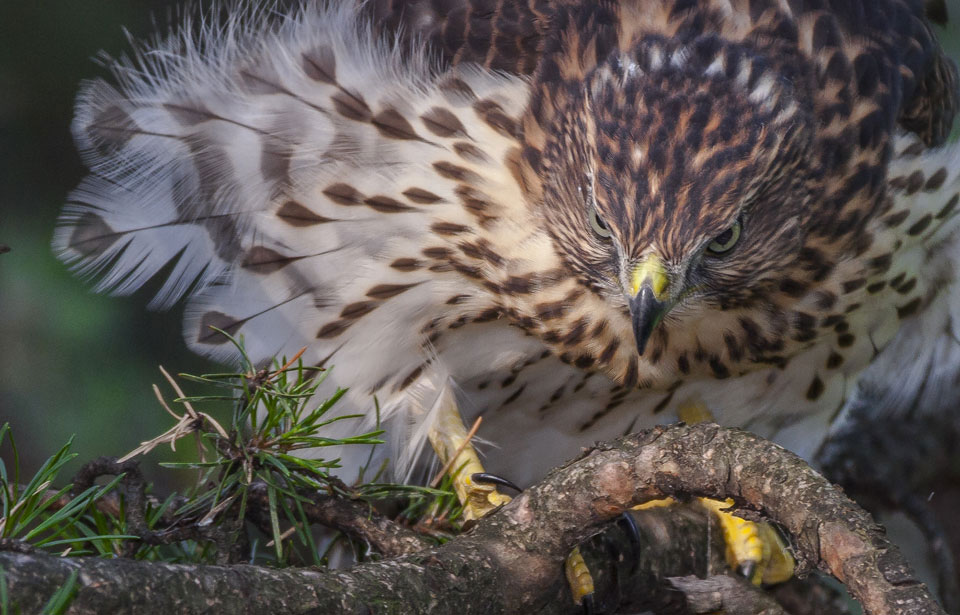 Jean-Daniel Gagné
Sharp-shinned Hawk, Cooper's Hawk, and Northern Goshawk
Jean-Daniel Gagné
Sharp-shinned Hawk, Cooper's Hawk, and Northern Goshawk
Of the 19 species of raptors, or birds of prey, in Canada, three are Accipiters. Accipiters are small to medium-sized hawks of swift flight that occur around the world. The Canadian species are the Sharp-shinned Hawk Accipiter striatus, the Cooper’s Hawk Accipiter cooperii, and the Northern Goshawk Accipiter gentilis. The Sharp-shinned Hawk is found in North, Central, and South America, the Cooper’s Hawk only in North America, and the Northern Goshawk on five continents.
Accipiters can be distinguished from other types of hawks by their flight silhouettes (see sketch). Like the buteos (e.g., the Red-tailed Hawk Buteo jamaicensis) and harriers (the Northern Harrier Circus cyaneus is the only Canadian harrier), the accipitrine hawks have rounded wings; however, these are shorter than in the other two groups. In contrast, the wings of another group of hawks, the falcons, such as the Kestrel or Sparrow Hawk Falco sparverius, are pointed.
All accipiters generally have similar colouring, small heads, long tails, and short rounded wings. The female of each species grows larger than the male. They range in size from the small male Sharp-shinned Hawk, which is smaller than a gull, to the large female Northern Goshawk, which at 55 to 66 cm is larger than a crow. The Cooper’s Hawk is intermediate in size; the male Cooper’s is easily confused with the female Sharp-shinned Hawk, and the female Cooper’s Hawk is almost as large as the male Northern Goshawk. There are distinguishing characteristics—for example, the shape of the tail is square for the Sharp-shinned Hawk, rounded for the Cooper’s Hawk, and almost square for the Northern Goshawk—but identification is difficult.
-
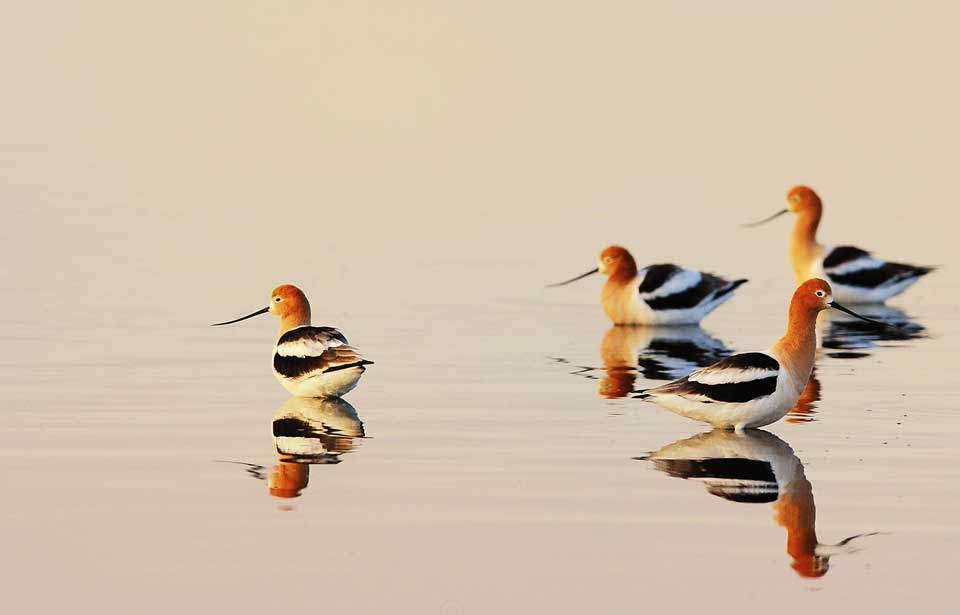 Shorebirds
Shorebirds
 Shorebirds form one of the most interesting, important, and spectacular groups of birds in Canada. They comprise a diverse group of species, including the plovers, oystercatchers, avocets, stilts, turnstones, sandpipers, yellowlegs, snipes, godwits, curlews, and phalaropes.
Shorebirds form one of the most interesting, important, and spectacular groups of birds in Canada. They comprise a diverse group of species, including the plovers, oystercatchers, avocets, stilts, turnstones, sandpipers, yellowlegs, snipes, godwits, curlews, and phalaropes.
To the uninitiated, many species of shorebirds, especially the smaller sandpipers, appear confusingly similar, representing variations on a design involving long legs, a long bill, sharp, dynamic wings, and a streamlined body. These design features all reflect the lifestyle for which the birds are adapted—long legs for wading in water or on mudflats or marshes, the long bill for searching for tiny animal and insect prey by probing into Arctic tundra or a variety of substrates, and long wings and a streamlined body for swift flight over long distances. -
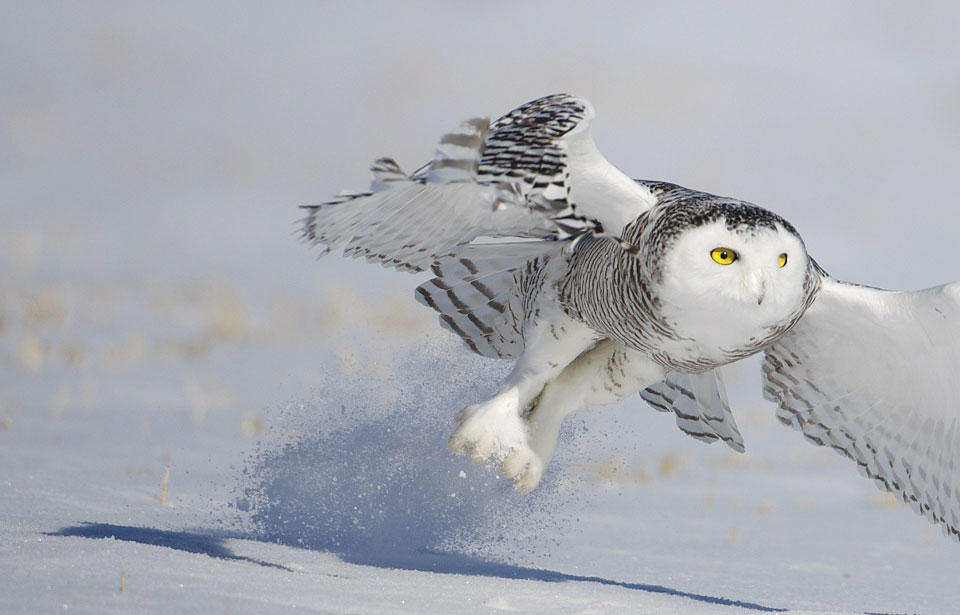 Mark Williams
Snowy Owl
Snowy Owl (15 seconds) Snowy Owl (Youth) Snowy Owl (30 seconds) Snowy Owl Snowy Owl (Original)
Mark Williams
Snowy Owl
Snowy Owl (15 seconds) Snowy Owl (Youth) Snowy Owl (30 seconds) Snowy Owl Snowy Owl (Original)
One of the heaviest of North American owls, the Snowy Owl Bubo scandiacus stands nearly half a metre tall, with a wingspan of almost 1.5 m. As is the case with most diurnal birds of prey—those that are active during the day—the female is larger and heavier than the male. The average weight of the female is 2.3 kg compared to 1.8 kg for the male.
Adult males may be almost pure white in colour. Adult females are darker, their white feathers barred with dark brown. First-year birds of both sexes are more darkly marked than their adult counterparts. Immature males resemble adult females, and immature females are heavily barred and may appear dark grey when seen from a distance. The light coloration of Snowy Owls provides camouflage when the owls are perched on snow, but this advantage is lost in summer. As spring approaches and the ground becomes bare, Snowy Owls move to sit on patches of snow or ice. No one knows whether they do this to camouflage themselves or whether they are merely keeping insects away or staying cool.
A dense layer of down, overlaid with thick feathering, insulates the Snowy Owl’s entire body, including the legs and toes, and enables the bird to maintain a body temperature of 38 to 40°C, even when the air temperature reaches -50°C. In strong wind, Snowy Owls may seek shelter by crouching on the ground behind a windbreak, such as a pile of stones, snowdrift, or bale of hay.
-
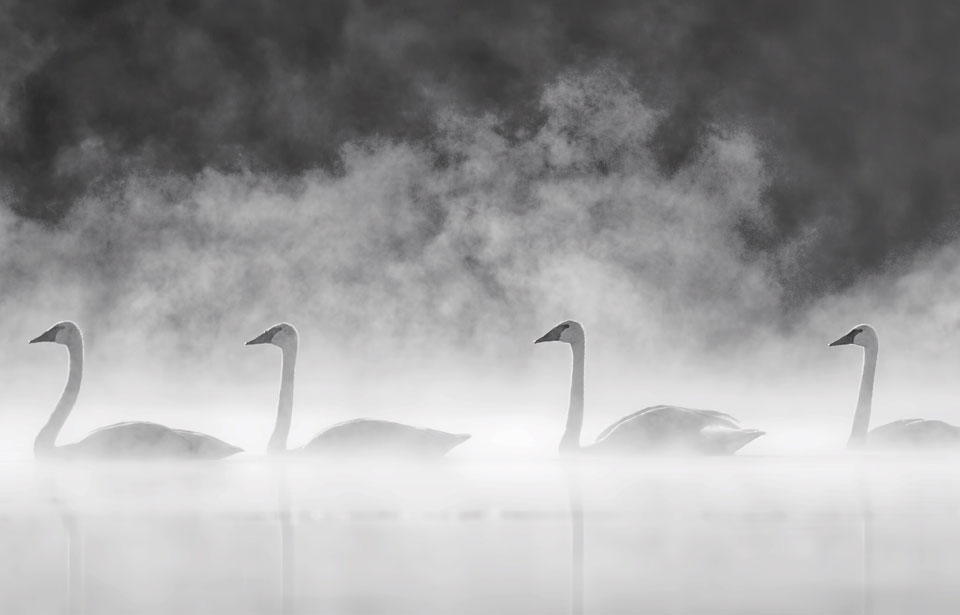 Bill Maynard
Trumpeter Swan
Trumpeter Swan Wetlands (30 seconds) Wetlands (60 seconds)
Bill Maynard
Trumpeter Swan
Trumpeter Swan Wetlands (30 seconds) Wetlands (60 seconds)
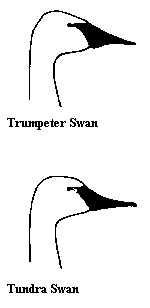 Adult Trumpeter Swans Cygnus buccinator are large birds with white feathers and black legs and feet. The feathers of the head and the upper part of the neck often become stained orange as a result of feeding in areas rich in iron salts. The lack of colour anywhere on the swans’ bodies distinguishes them from other white species of waterfowl, such as snow geese, which have black wing tips.
Adult Trumpeter Swans Cygnus buccinator are large birds with white feathers and black legs and feet. The feathers of the head and the upper part of the neck often become stained orange as a result of feeding in areas rich in iron salts. The lack of colour anywhere on the swans’ bodies distinguishes them from other white species of waterfowl, such as snow geese, which have black wing tips.
The male swan, or cob, weighs an average of 12 kg. The female, or pen, is slightly smaller, averaging 10 kg. Wings may span 3 m. Young of the year, or cygnets, can be distinguished from adults by their grey plumage, their yellowish legs and feet, and until their second summer of life, their smaller size.
The shape and colour of the bill help in identifying the Trumpeter and Tundra swans in the field. Trumpeters have all black bills; Tundra Swans, formerly called Whistling Swans, have more sloping bills, usually with a small yellow patch in front of the eye. If this patch is missing, it is quite difficult to distinguish between the two birds unless the voice is heard. At close range, an observer should look for a salmon-red line on the lower bill.
A third type of swan, the Eurasian Mute Swan, is often seen in Canadian parks and zoos. The Mute is all white with a black knob on a reddish-orange and black bill. The Trumpeter Swan is the largest of the three species.
Signs and sounds
Although very similar in appearance, the Trumpeter Swan and the Tundra Swan have quite different voices. The Trumpeter Swan has a deep, resonant, brassy, trumpet-like voice; the voice of the Tundra Swan is softer and more melodious. -
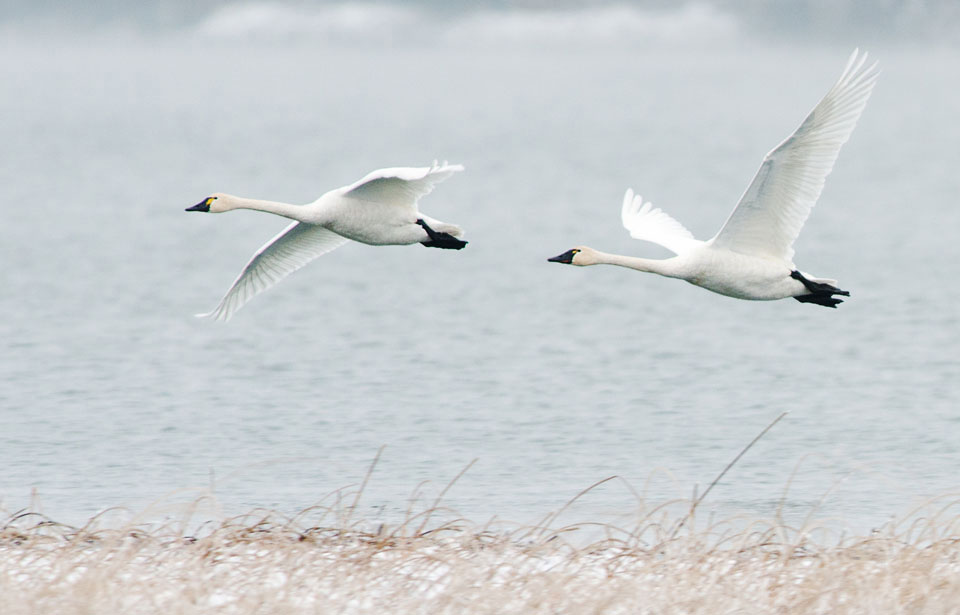 Lindy Martin
Tundra Swan
Lindy Martin
Tundra Swan
The Tundra Swan Cygnus columbianus, formerly known as the Whistling Swan, is a large bird with white plumage and black legs, feet, and beak. However, when it is feeding in iron-rich areas, the feathers on its head and neck may take on a reddish tinge.
The male weighs on average 7.5 kg and can measure 1.3 m from bill to tail. The adult female is about the same size as the male but weighs slightly less, about 6.3 kg. The young of the year are smaller than the adults and have grey plumage, pinkish beaks with black tips, and pink legs and feet. It takes at least two years for adult plumage to grow in.
There are seven species of swans in the world. Two of these, the Tundra Swan and the Trumpeter Swan C. buccinator, are native to North America; their respective populations comprise 140 000 and 16 000 individuals. One non-native species, the Mute Swan, is found in North America,. People brought Mute Swans from Europe and Asia for ornamental display in parks and zoos, and now this species is found in the wild in certain parts of the continent. The Tundra Swan is the most common of the three species of swan found in Canada.
Although Trumpeter Swans are slightly larger than Tundra Swans, it is very difficult to tell the two species apart. At close range, a small yellow mark at the base of the bill, close to the eye, can be seen on the Tundra Swan. There is no such mark on the Trumpeter Swan.
Signs and sounds
Although very similar in appearance, the Trumpeter Swan and the Tundra Swan have quite different voices. The Trumpeter Swan has a deep, resonant, brassy, trumpet-like voice; the voice of the Tundra Swan is softer and more melodious.
The Tundra Swan’s former name “whistling swan” referred to the sound made by the slow, powerful beating of the wings in flight, and not to the voice of the bird. The call is pitched lower than a whistle and more closely resembles a blowing or tearing sound.
When thousands of birds are concentrated at a migratory staging point, the level of sound is very high, particularly at night when much of the social activity takes place. -
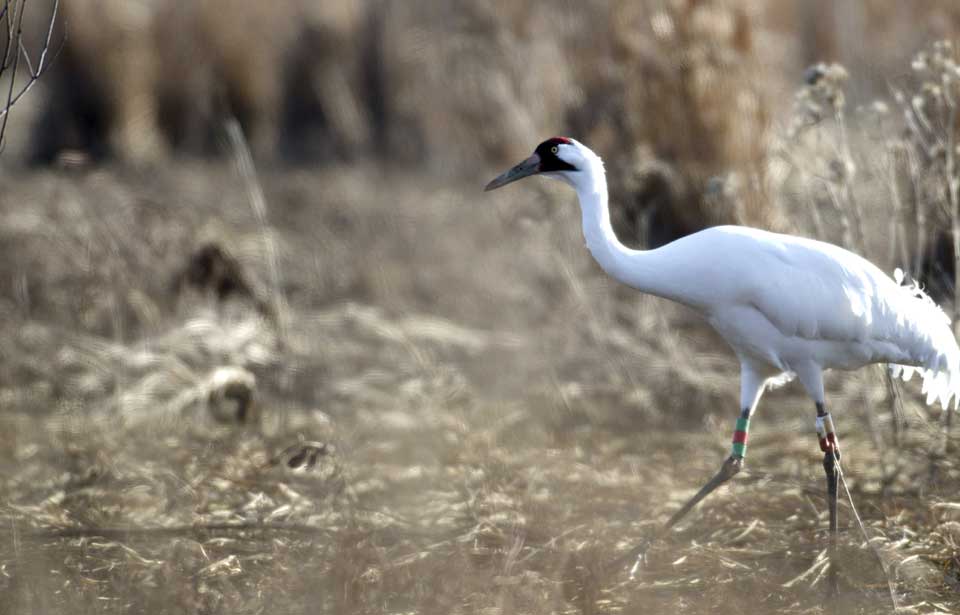 Thinkstock
Whooping Crane
Whooping Crane
Thinkstock
Whooping Crane
Whooping Crane
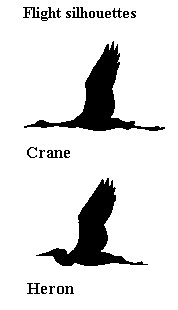 The Whooping Crane Grus americana, or whooper, is the most famous endangered bird in North America. It is famous partly because it is large, distinctive, and photogenic and partly because, since 1967, Canadians and Americans have cooperated in a successful recovery program to save it from extinction.
The Whooping Crane Grus americana, or whooper, is the most famous endangered bird in North America. It is famous partly because it is large, distinctive, and photogenic and partly because, since 1967, Canadians and Americans have cooperated in a successful recovery program to save it from extinction.
The adult Whooping Crane is the tallest North American bird. It has a long neck, long dark pointed bill, and long thin black legs. A large male is about 1.5 m tall. In the air, the wings measure 2 m or more between the tips of the long black primaries, or flight feathers, which cannot usually be seen when the bird is at rest. At close range, the adult Whooping Crane is an imposing bird, with snowy-white plumage, black bristlelike feathers on crown and face, a small black patch on the back of the head below the crimson crown, and bright yellow eyes. The juvenile bird has dark brown eyes and cinnamon-and-white plumage. In both adults and juveniles the white wings are tipped with black. -
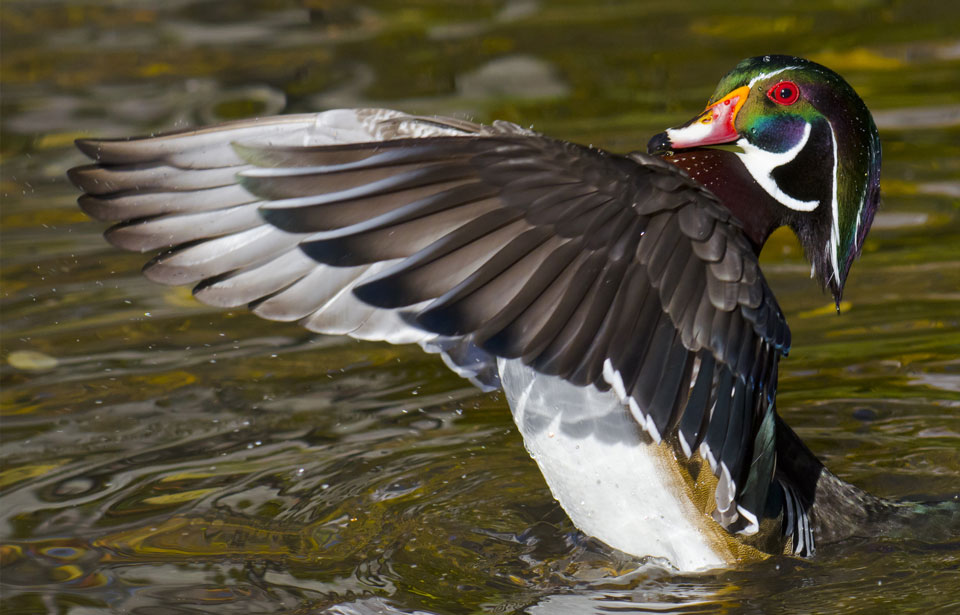 Simon Bolyn
Wood Duck
Wetlands (30 seconds) Wetlands (60 seconds)
Simon Bolyn
Wood Duck
Wetlands (30 seconds) Wetlands (60 seconds)
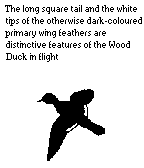 Many naturalists and hunters consider the Wood Duck Aix sponsa to be the most beautiful duck in North America, if not the world. The male in its multi-coloured breeding plumage, worn from October through June, is unexcelled among ducks. The female is less showy, although still beautiful and more colourful than other female ducks.
Many naturalists and hunters consider the Wood Duck Aix sponsa to be the most beautiful duck in North America, if not the world. The male in its multi-coloured breeding plumage, worn from October through June, is unexcelled among ducks. The female is less showy, although still beautiful and more colourful than other female ducks.
Wood Ducks are intermediate in size, between the Mallard and Blue-winged Teal; on average, males weigh 680 g and females weigh 460 g. From a distance, the male Wood Duck on the water appears as a dark-bodied, dark-breasted, light-flanked duck with a striped crested head and a light-coloured throat. At close range, its iridescent plumage, red eyes, and black, red, and white bill are conspicuous. A white eye-ring, light-coloured throat, and fine crest distinguish the female from both the male Wood Duck and females of other species. Both sexes usually show a downward pointing crest at the back of the head, and their long broad square tails are distinctive features in flight.The wings of Wood Ducks are highly characteristic. The primary wing feathers, which are the 10 outermost flight feathers attached to the wing beyond the wrist, are dark in colour. The outer vanes of these feathers look as if they have been sprayed with aluminum paint. The Wood Duck is the only North American duck so marked.











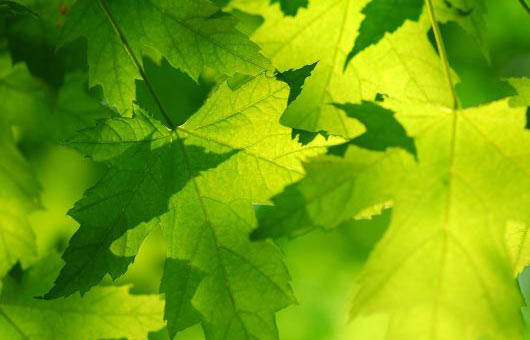
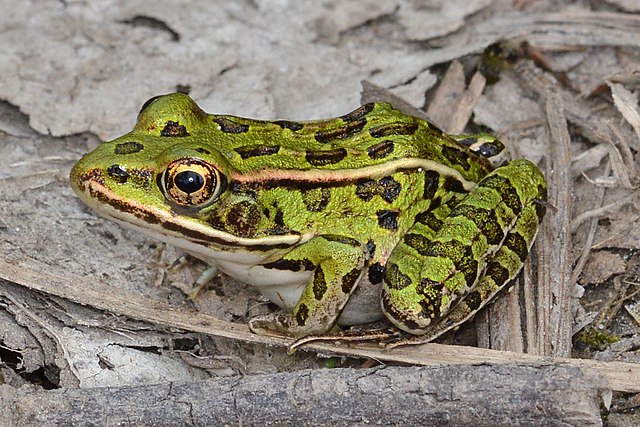
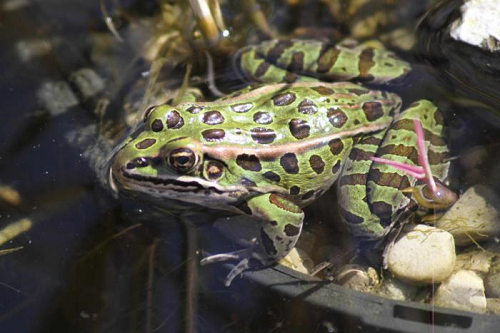
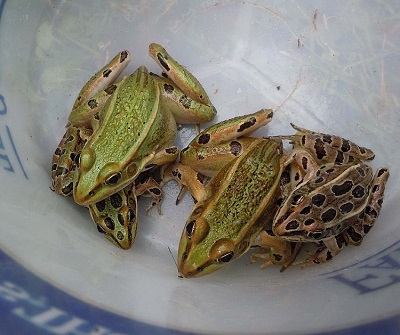
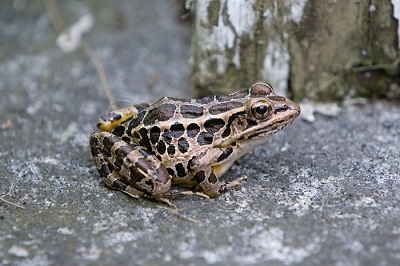

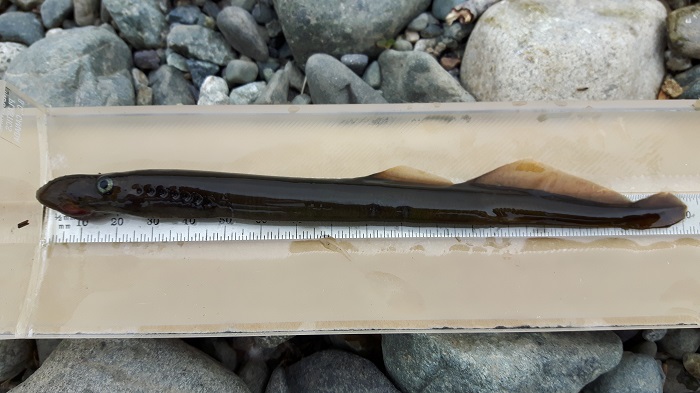
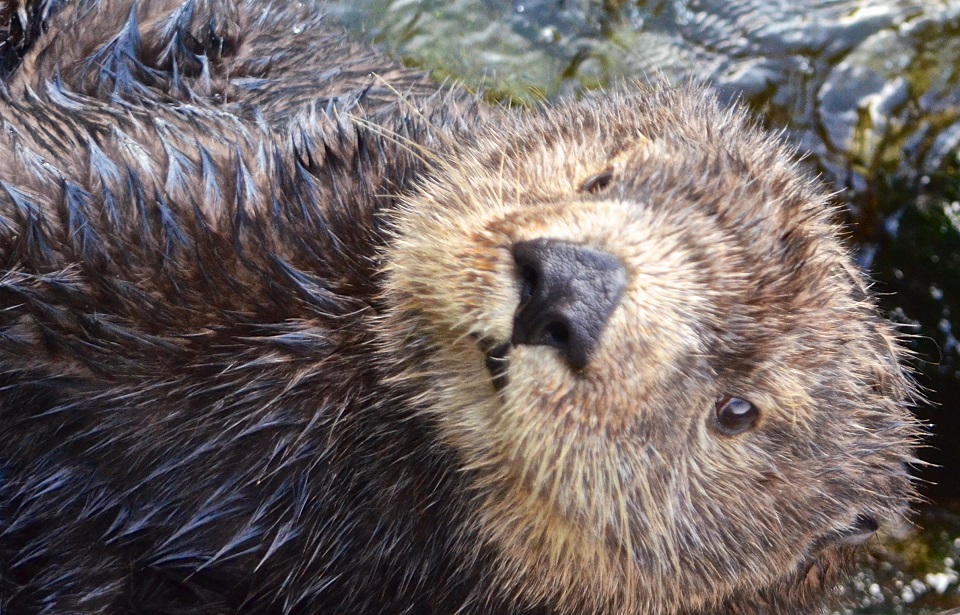
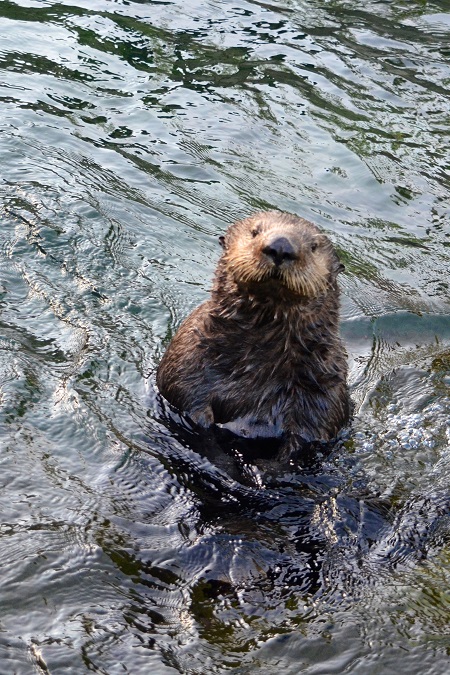
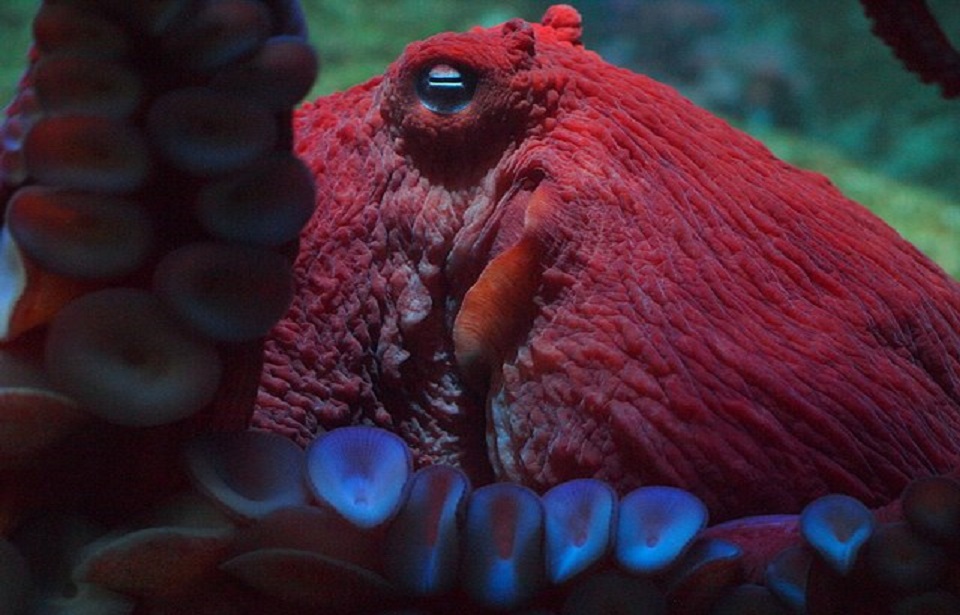
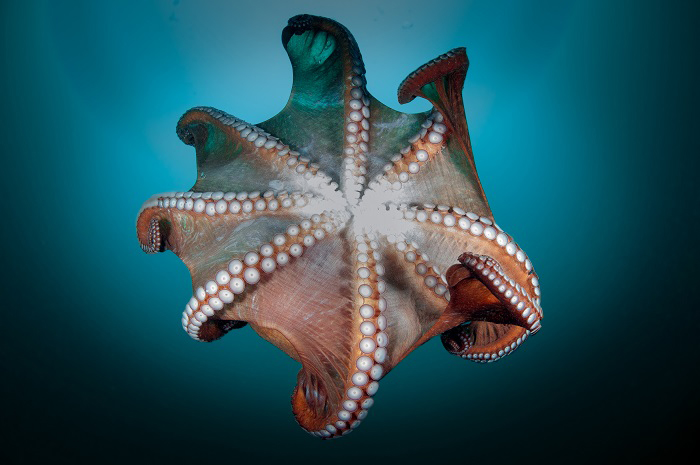

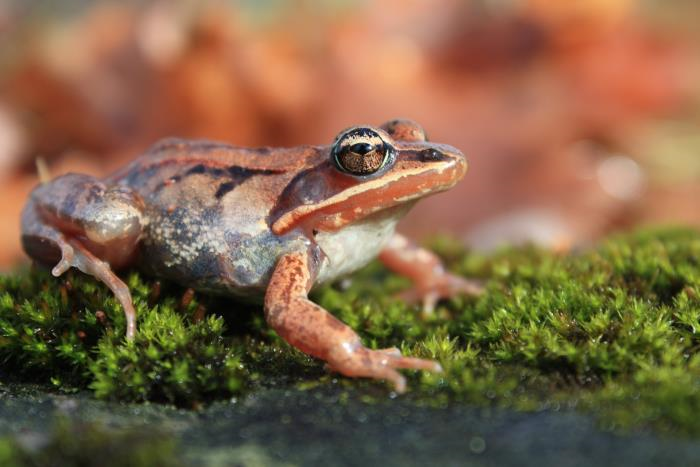

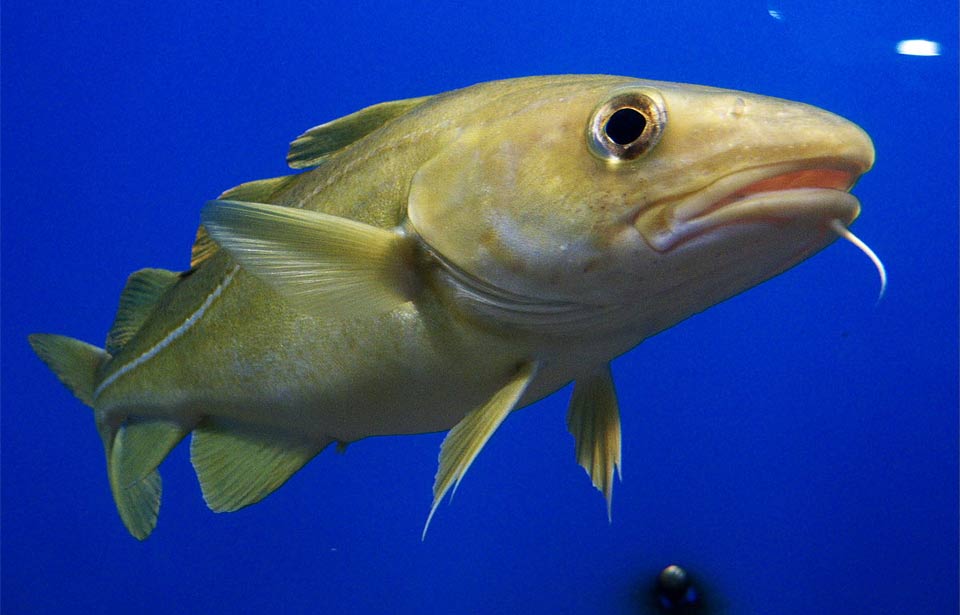
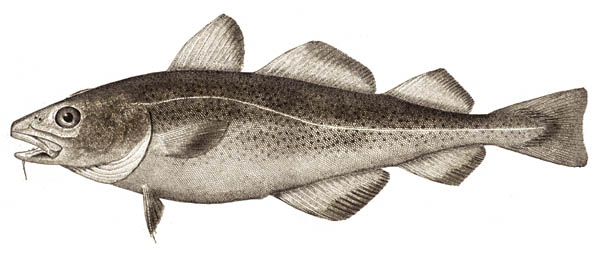 The Atlantic Cod (Gadus morhua) is a medium to large saltwater fish: generally averaging two to three kilograms in weight and about 65 to 100 centimetres in length, the largest cod on record weighed about 100 kg and was more than 180 cm long! Individuals living closer to shore tend to be smaller than their offshore relatives, but male and female cod are not different in size, wherever they live.
The Atlantic Cod (Gadus morhua) is a medium to large saltwater fish: generally averaging two to three kilograms in weight and about 65 to 100 centimetres in length, the largest cod on record weighed about 100 kg and was more than 180 cm long! Individuals living closer to shore tend to be smaller than their offshore relatives, but male and female cod are not different in size, wherever they live.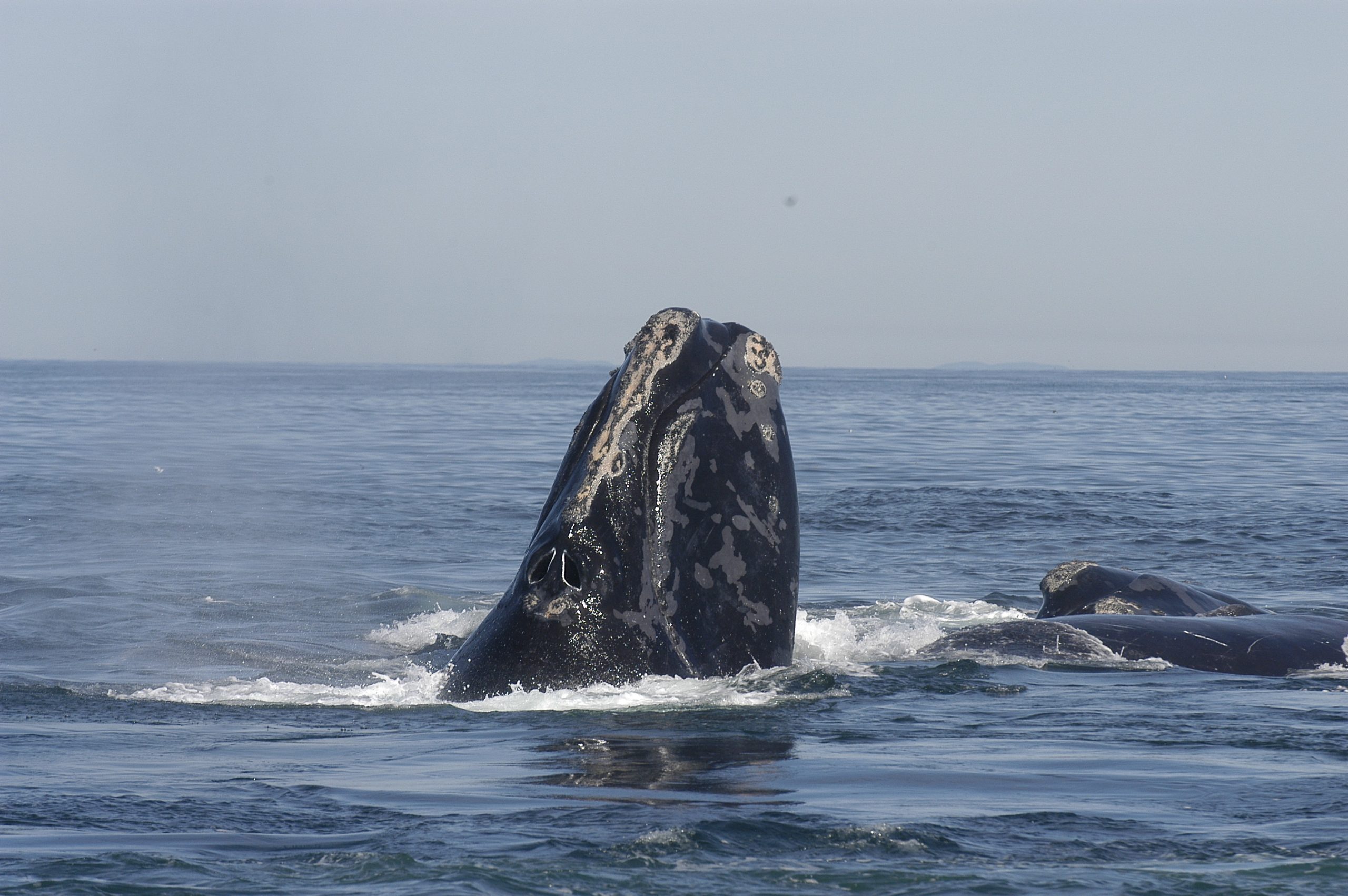
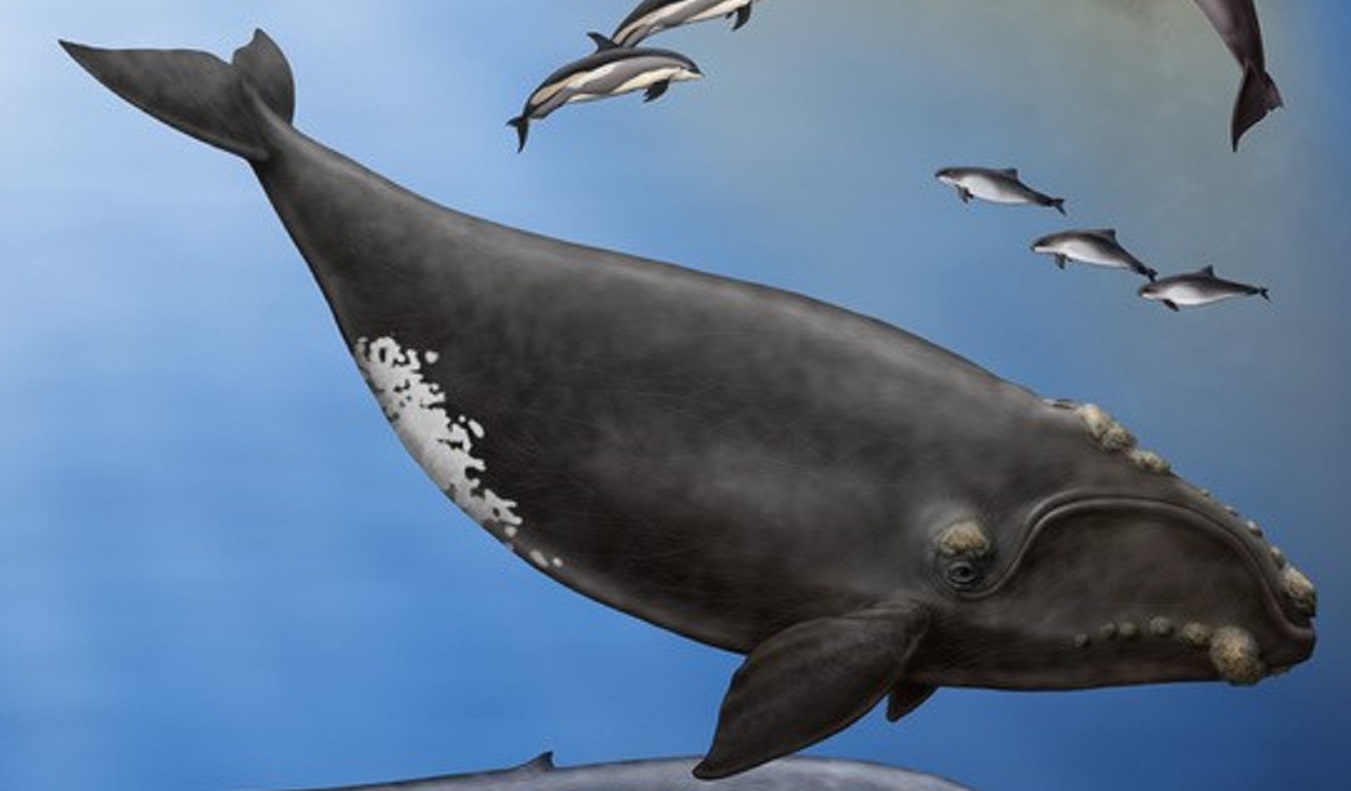 The North Atlantic Right Whale (Eubalæna glacialis) is one of the rarest of the large whales. It can weigh up to 63,500 kilograms and measure up to 16 metres. That’s the length of a transport truck and twice the weight! Females tend to be a bit larger than males – measuring, on average, one metre longer. Considering its weight, it’s fairly short, giving it a stocky, rotund appearance. Its head makes up about a fourth of its body length, and its mouth is characterized by its arched, or highly curved, jaw. The Right Whale’s head is partially covered in what is called callosities (black or grey raised patches of roughened skin) on its upper and lower jaws, and around its eyes and blowhole. These callosities can appear white or cream as small cyamid crustaceans, called “whale lice”, attach themselves to them. Its skin is otherwise smooth and black, but some individuals have white patches on their bellies and chin. Under the whale’s skin, a blubber layer of sometimes more than 30 centimetres thick helps it to stay warm in the cold water and store energy. It has large, triangular flippers, or pectoral fins. Its tail, also called flukes or caudal fins, is broad (six m wide from tip to tip!), smooth and black. That’s almost the same size as the Blue Whale’s tail, even though Right Whales are just over half their size. Unlike most other large whales, it has no dorsal fin.
The North Atlantic Right Whale (Eubalæna glacialis) is one of the rarest of the large whales. It can weigh up to 63,500 kilograms and measure up to 16 metres. That’s the length of a transport truck and twice the weight! Females tend to be a bit larger than males – measuring, on average, one metre longer. Considering its weight, it’s fairly short, giving it a stocky, rotund appearance. Its head makes up about a fourth of its body length, and its mouth is characterized by its arched, or highly curved, jaw. The Right Whale’s head is partially covered in what is called callosities (black or grey raised patches of roughened skin) on its upper and lower jaws, and around its eyes and blowhole. These callosities can appear white or cream as small cyamid crustaceans, called “whale lice”, attach themselves to them. Its skin is otherwise smooth and black, but some individuals have white patches on their bellies and chin. Under the whale’s skin, a blubber layer of sometimes more than 30 centimetres thick helps it to stay warm in the cold water and store energy. It has large, triangular flippers, or pectoral fins. Its tail, also called flukes or caudal fins, is broad (six m wide from tip to tip!), smooth and black. That’s almost the same size as the Blue Whale’s tail, even though Right Whales are just over half their size. Unlike most other large whales, it has no dorsal fin.